Let me guide you to Florence, the city that was home to the Medici Family and the cradle of the Italian Renaissance.
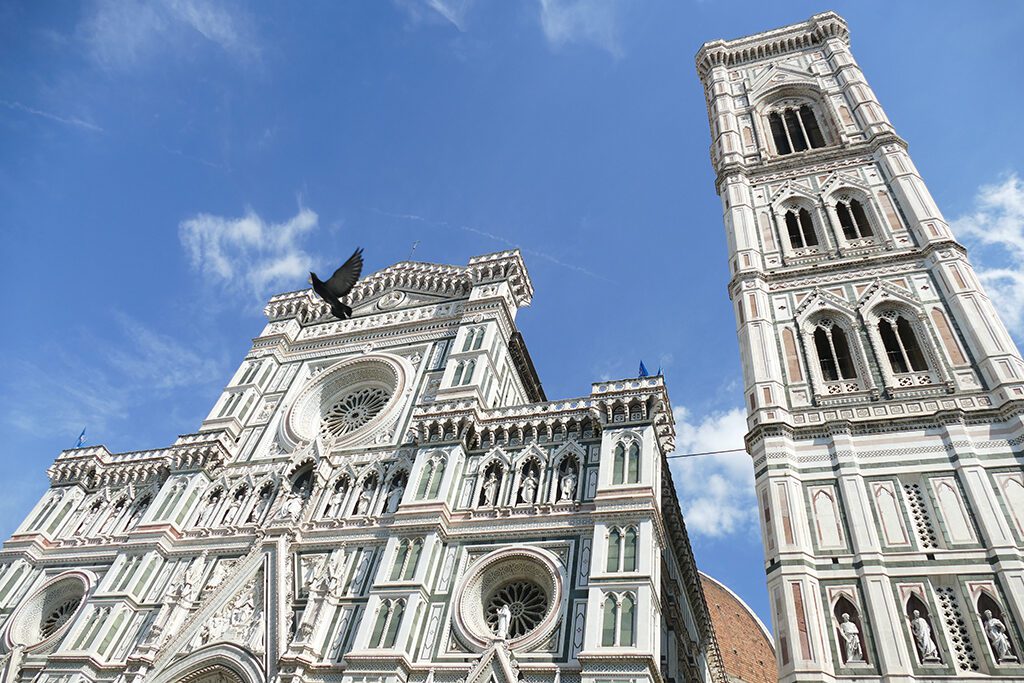
To this date, there are so many art treasures that Florence deems rather an Open-Air-Museum than a North Italian city with ordinary people and everyday life.
Florence and I
On a few occasions, I’ve mentioned that trip with my boyfriend. The one when I was 17. We travelled by interrail and got robbed twice. Then, on one of the last days, I dumped him. He got drunk and ended up at a suspicious clinic in Pisa and…yadda yadda yadda. If you don’t know the story yet, you can read it in this post.

These globes hanging at the courtyard of the Palazzo Strozzi are from a Tomás Saraceno exhibition. I’ve introduced his fascinating masterpiece in orbit in my post on Düsseldorf.
Well, the reason I mention that trip from time to time is that it was the awakening experience for many road trips to come. We meandered pretty much mindlessly from spot to spot. And one of these spots was Florence. I was just a teenager and very much annoyed by the womanizing Italians and also not a culture vulture yet. Nevertheless, Florence just blew me away. Forever. I remember standing on the Piazza del Duomo with my eyes wide open – simply mesmerized.
Until the next creep positioned himself next to me and tried to initiate some moronic conversation.
But forget about the creep – I clogged my ears and awed at the beauty around me. How could one single place have so much excellence in store? So much art that it didn’t all fit in museums, hence, was exhibited right on bridges and squares.
The heart wants what it wants: I fell in eternal love with Florence straight on my very first visit.
History in a Nutshell
Florence is so outstandingly beautiful because there always were wealthy and powerful patrons pampering the city. They flooded it with money. This allowed Florence to lean back and let the best architects and the most talented artists embellish both banks of the river Arno.
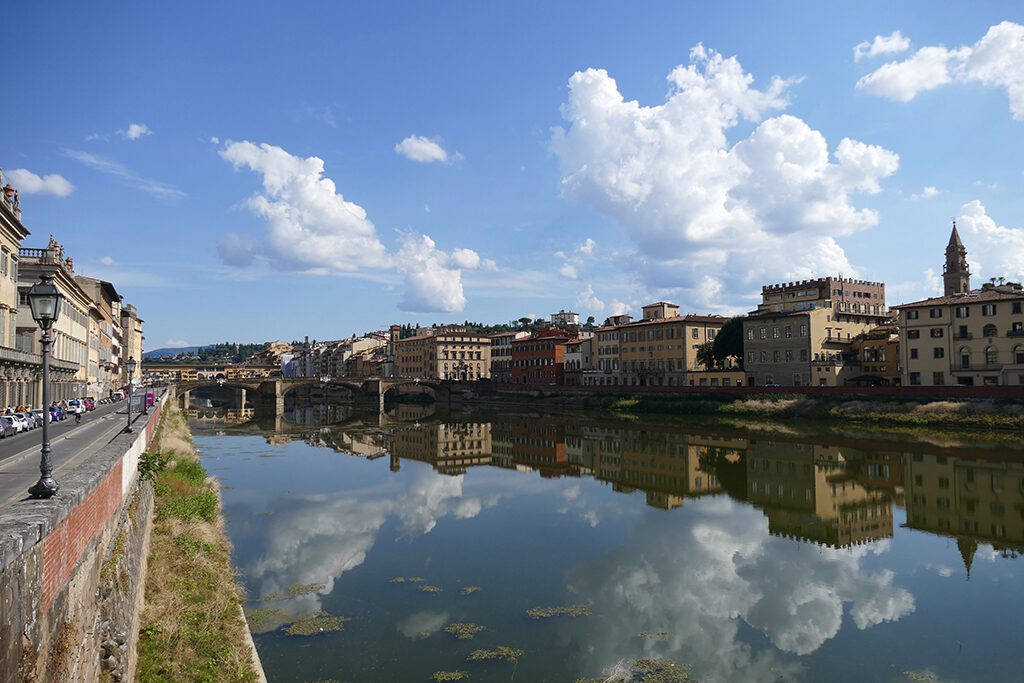
Consequently, it was the center of trade and finance and one of the richest European cities during the 15th and 16th centuries. Also, this economic wealth enabled Florence to become the cradle of the Renaissance, the cultural and philosophical rebirth after the dark years of the Middle-Ages.
Keeping Up With the Medicis
Especially between the 14th and 16th centuries, Florence flourished and set the standard in European art and culture. Many artists and scholars settled here. First, there were for instance Donatello and Botticelli. Later came Michelangelo, Machiavelli, Leonardo da Vinci, and Galileo Galilei.
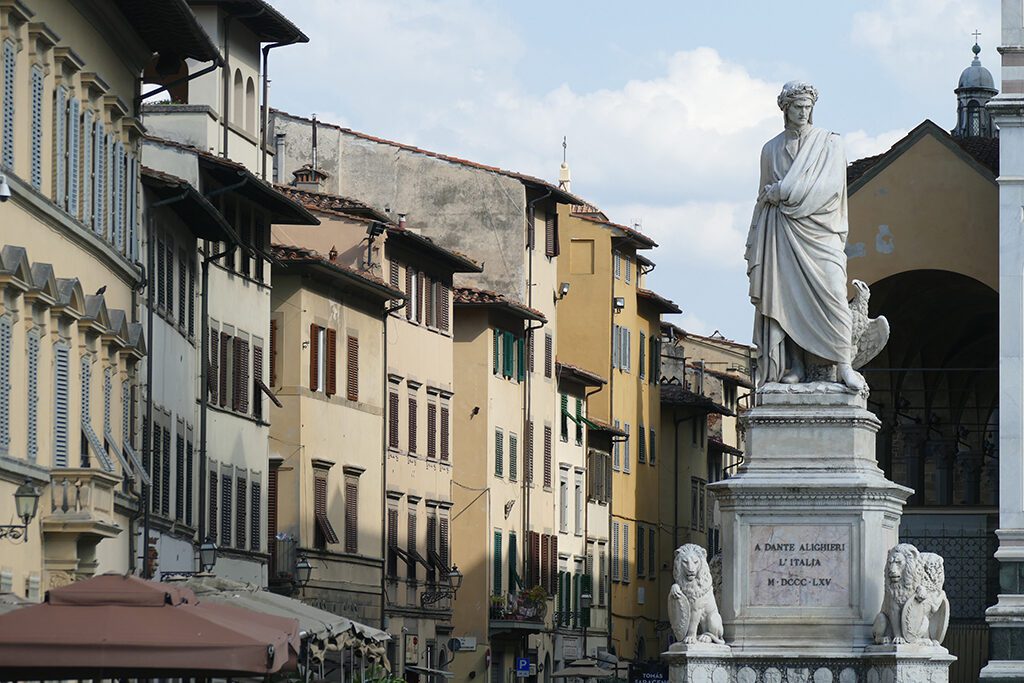
At the same time, Florence became a commercial and financial center. Like no other family, the wealthy Medicis rose to power and molded the city.
The first principal figure of the Medicis was Cosimo the Elder. Born in 1389, he became a banker and politician and gradually subjugated the city.
For a short time, Cosimo lived in exile as opposing families had overthrown the Medici. However, during the Medici’s absence, the economy came to a standstill. Hence, Cosimo returned from his exile and took over the reign again. Through skillful manipulation, he created a system of powerful politicians, merchants, and clerics.
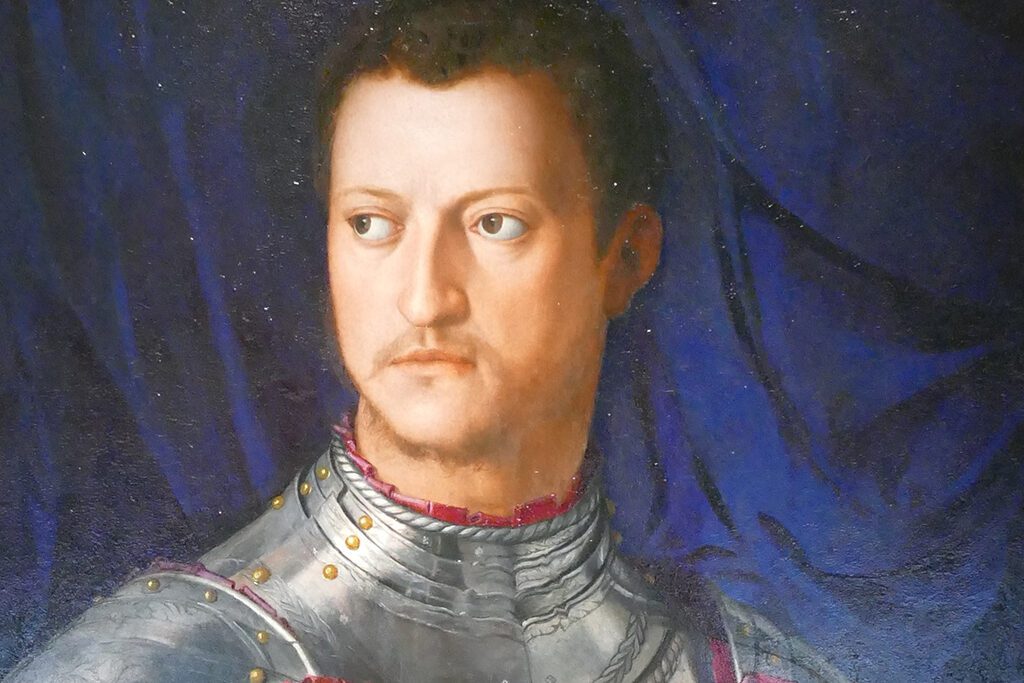
Like many other nobles, also the Medici tended to recycle the same names. So just to be clear, the is not Cosimo the Elder that I’m introducing above.
The fact that the Medici acted as the Pope’s private bankers quickly made them a respected banking family. But behind the scenes, intrigues and scandals dominated the politics of that time. Nevertheless, the influence of the Medici, their skills, and their keen business acumen allowed Florence to prosper. It became a cultural stronghold for two centuries in Europe.
Lorenzo Il Magnifico
In 1449, Cosimo’s grandson Lorenzo was born to Piero di Cosimo de Medici and Lucrezia Tornabuoni. Together with his brother Giuliano di Piero de Medici, Lorenzo prepared himself for his future role through extensive humanistic education.
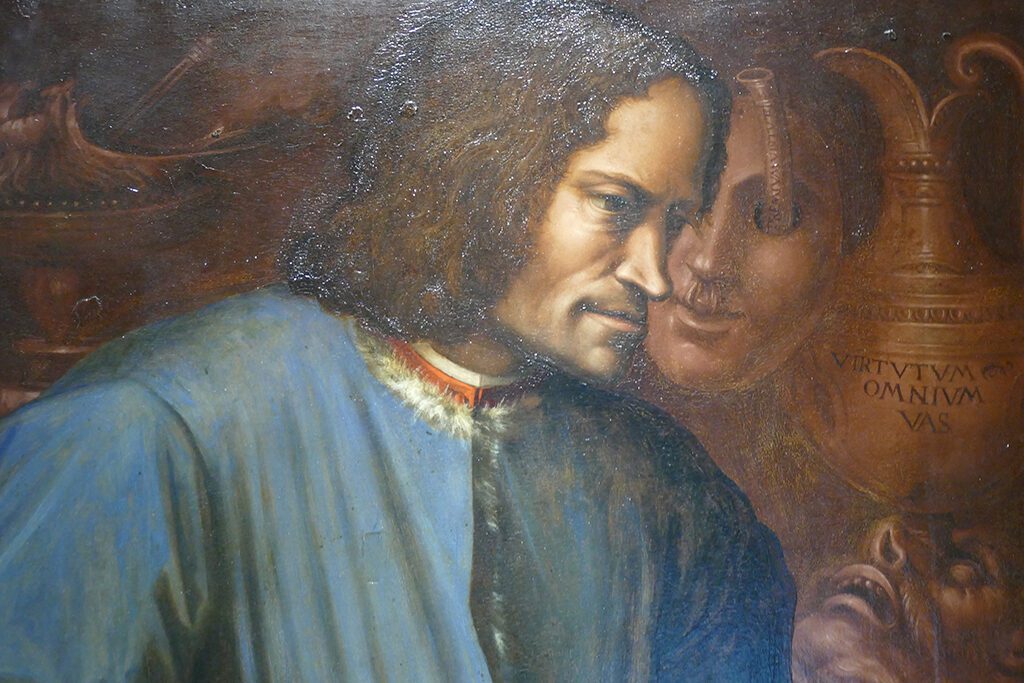
After his father’s death in 1469, Lorenzo became the leading statesman of the Republic of Florence. Although he had no official jurisdiction, in fact, he ruled the city.
Albeit, he governed behind closed doors. From the background, he was able to inspirit the people who held the official positions. Only those sponsored by Lorenzo could establish a political career.
Lorenzo got the nickname Il Magnifico, hence, The Splendid, due to his generous support of the fine arts. Under his rule, Florence became the most important city of the arts during the Renaissance.
However, Lorenzo not only promoted and protected artists. He also had detailed knowledge of architecture and literature himself. He wrote poems in the local language and participated in the planning of the church of San Salvatore al Monte.
So this glorious dynasty made Florence one of the most prosperous metropolises in Europe during the Renaissance. From 1865 to 1870, the city even was the capital of the young Kingdom of Italy!
The city’s history is well-known because it was first written down around 1520 by Niccolò Machiavelli. Machiavelli wrote his Istorie Fiorentine on behalf of the Medici. Eventually, he also narrated the history of his hometown. He was basically one of the first modern historians.
The Grand Tours
The city’s importance waned in the 17th century. The Medici, who had shaped the city for a long time, died out. From 1808 until the defeat of Napoleon in 1814, the Arno department was part of France. Still, with Florence as the capital.
In the 19th century began a new economic boom. Due to its cultural treasures, Florence became the destination of educational trips, called the Grands Tours. Also, at that time, it was a part of the Austro-Hungarian Empire. Only in 1861, Florence became part of unified Italy, following Turin as Italy’s capital in 1865.
Finally, in 1871, Rome took over.
The urban population doubled over the 19th century and tripled in the 20th. The economy benefited greatly from the freshly developing tourism. And even the former trade and finance sectors flourished again.
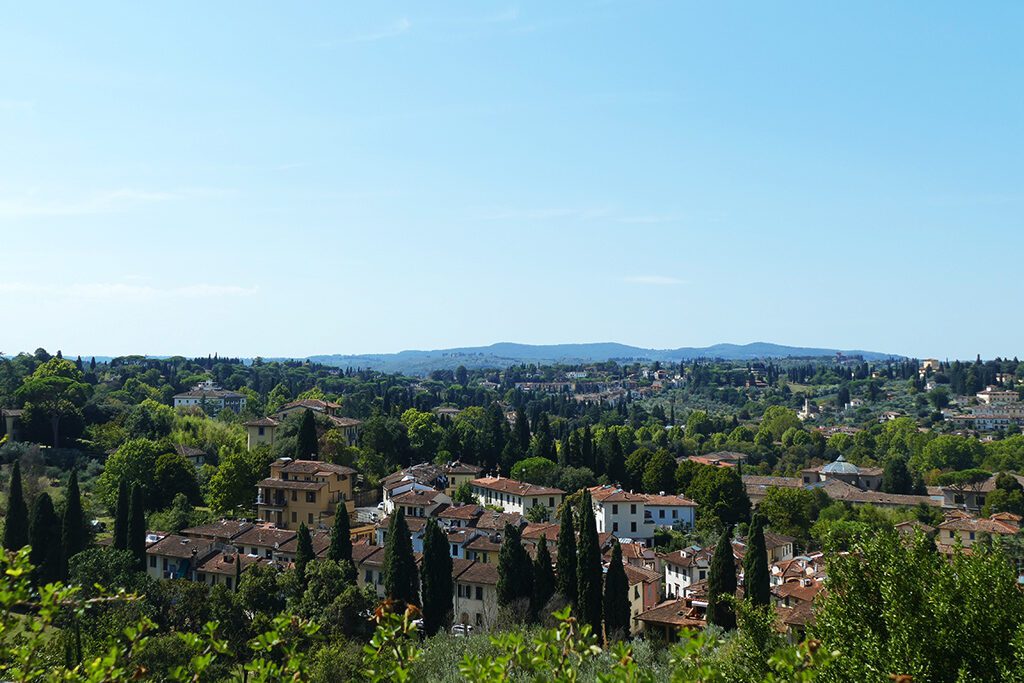
To this date, the historic center of Florence attracts millions of tourists. According to Euromonitor International, it is the 40th most visited city worldwide. Obviously, the historic city center has been on the list of the UNESCO World Heritage Sites since 1982.
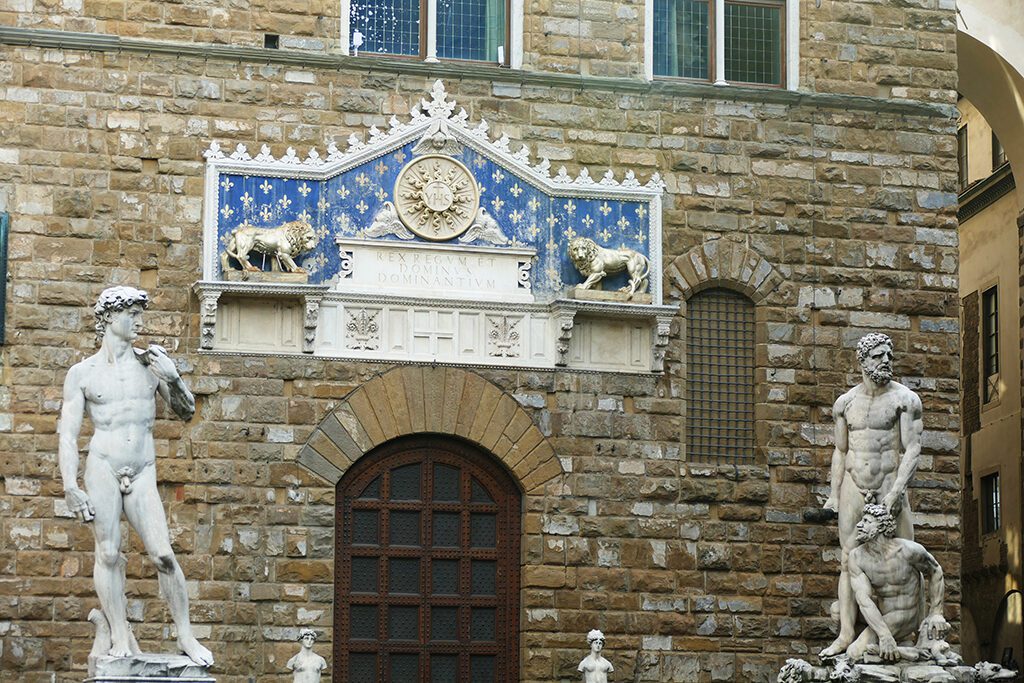
Forbes Magazine has selected Florence as one of the most beautiful cities in the world. Therefore, every year, more than 4 million tourists pay the city’s 370,000 inhabitants a visit.
Even as I was there during the pandemic in Summer 2020, the center was noticeably fuller than for instance the city of Rome.
Florence Walks Along Four Axis
Florence. Since I’ve been a fan for decades, I decided to spend the second week of my language-learning vacanze at the Medici family’s majestic hometown. Every day after my Italian lesson was over, I explored as many mesmerizing landmarks as possible. To visit all the amazing places I’m introducing in this post, you should need about five to seven days. If you can’t afford to stay that long, just pick what suits you best. You can come back for the rest later.
Howsoever, to make things easier for you, I divided this itinerary into four routes. A vertical axis starting at the Piazza di San Marco and leading all the way to the famous Ponte Vecchio. Following this route, you’ll get to see basically the most important landmarks, sites, and museums.
The horizontal axis is for those of you who’d like to dig a bit deeper into Florence’s history, but do also want to sample some specialties and shop for unique souvenirs. However, halfway between the endpoints of this route, you’ll cross the North-South Axis so that you might continue there, if you prefer. In any case, please consider this guide being an hors d’oeuvre plate – and just pick what tickles your fancy!
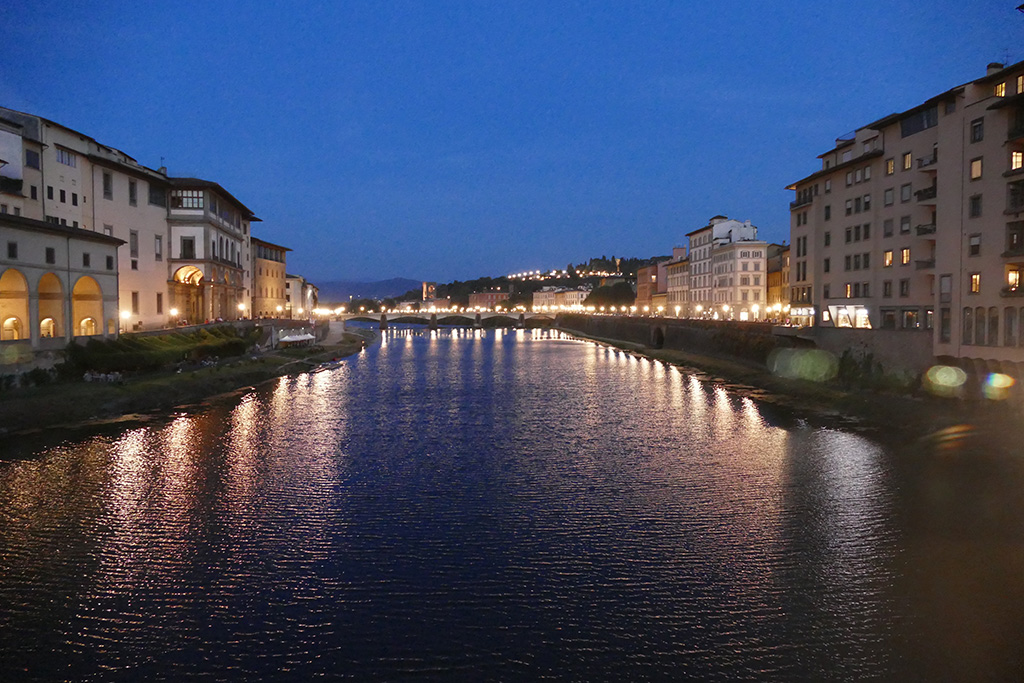
Especially in the months of summer, a walk on the banks of the river Arno is beautiful. Also, it’s definitely more serene than exploring just the historic nucleus. Also don’t miss out on a nightly stroll as those typical yellow street lamps illuminate the banks.
The North-South Axis
If you have to pick just one route, you’ll find the most iconic landmarks walking along this North-South Axis. Obviously, you can as well walk it from the river Arno towards the Piazza San Marco. Also, you might add some of the attractions from the other walks if your time allows it.
Museo di San Marco
The San Marco Museum is located on the northern side of Florence’s Piazza San Marco – which makes total sense, obviously. It’s housed in an ancient Dominican convent and therefore really outstanding and unique.
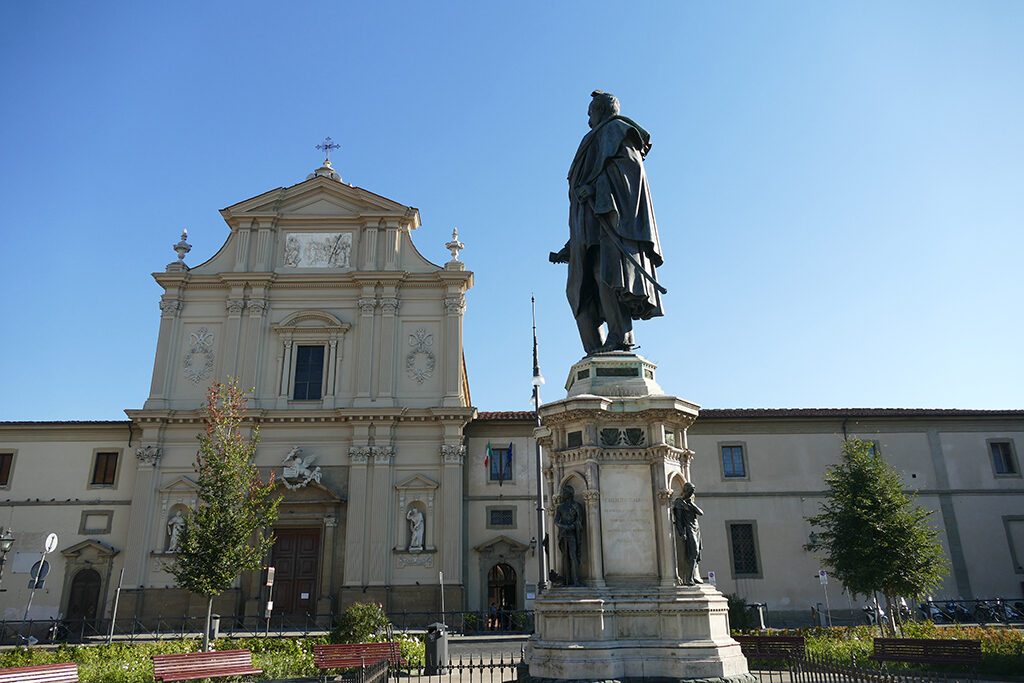
Fanti was an important leader in battles for Italian independence and unification.
The museum’s fame is mainly due to the works by Fra Angelico, one of the most important painters of the early Renaissance. His deeply pious work was believed to be directly mystically inspired. He decorated many rooms of the architectonic masterpiece.
Around 1300, the Benedictine Congregation Silvestrina commissioned the complex. At that time, it was not only a monastery but also the parish church.

Inside, forty-four cells are arranged along three corridors. These cells are decorated with an unparalleled cycle. Between 1442 and 1445, Fra Angelico and his elves aids painted a series of frescoes telling the stories of Christ.
Dinner Is Ready
Before you walk down the stairs, note Fra Angelico’s tender fresco of the Annunciation. It’s one of the master’s most famous works with a remarkable monumentality of the portraied figures.
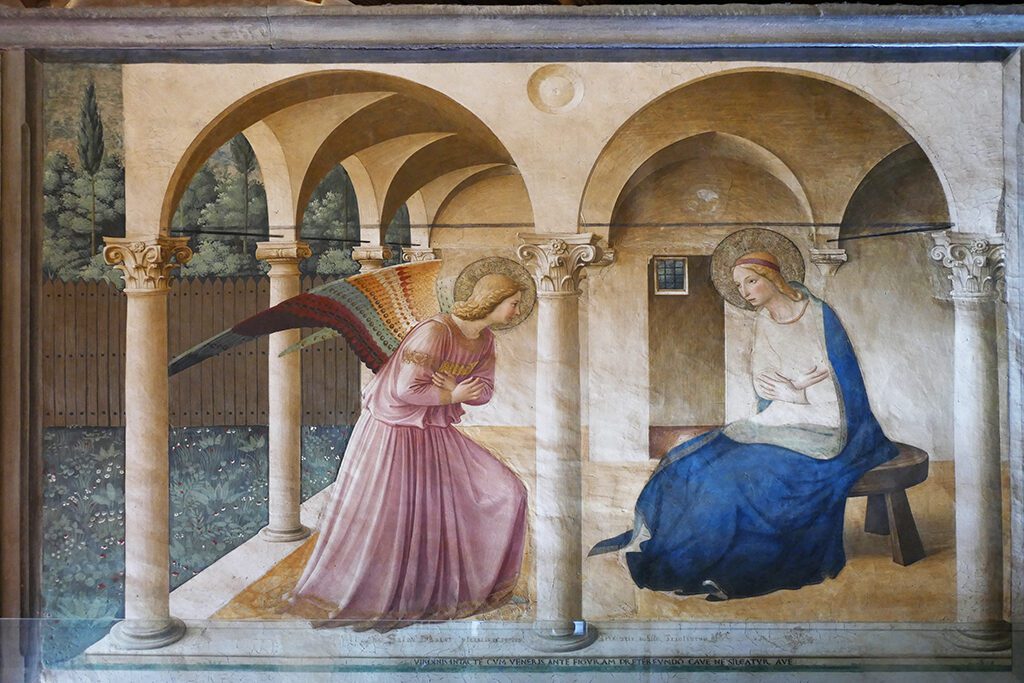
Virgin Mary and the Archangel Gabriel are depicted isolated in the perspective scheme of a portico that gives them a strong sense of silent spirituality.
Angelico depicted the same scene in other famous works that can be seen in Italy at the Museo della Basilica di Santa Maria delle Grazie in San Giovanni Valdarno, at the Museo Diocesano of Cortona, and in Spain at the at the Prado in Madrid.
In 1445, the master was called to Rome to paint frescoes at the Basilica of San Pietro and the Vatican Palace.
The most famous and important frescoe, however is the Cenacolo, the Last Supper, by Domenico Ghirlandaio.
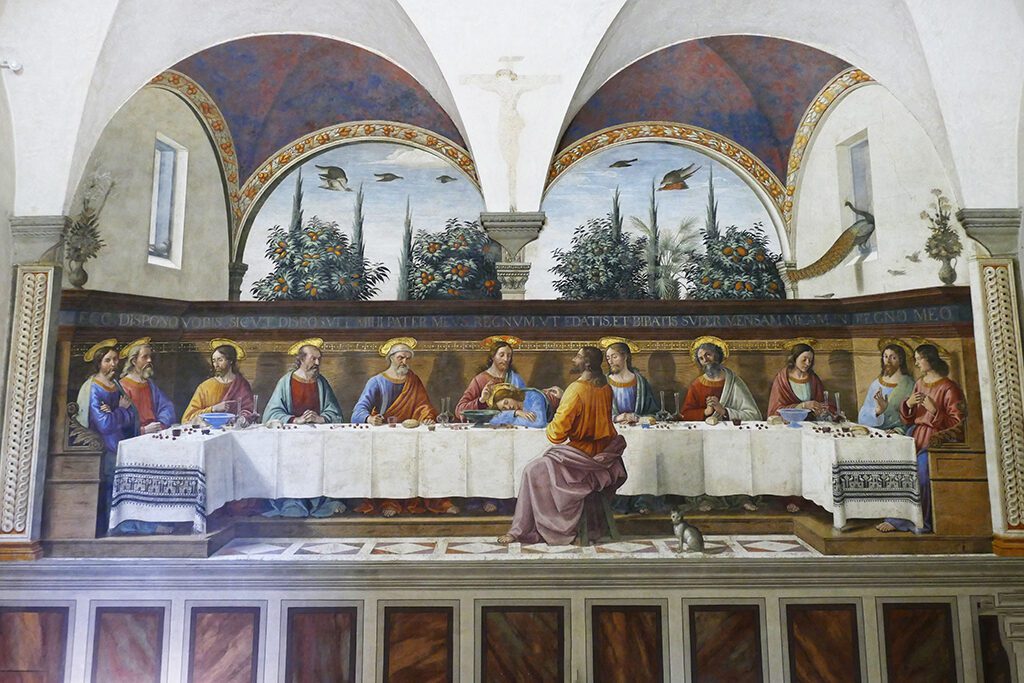
Ghirlandaio, who belonged to the so-called third generation of the Florentine Renaissance, decorated the wall of the former refectory of the monastery’s guesthouse. It is actually one of three Last Supper frescoes the artist painted around his hometown Florence. The others are at the refectory of the Convent of the Ognissanti respectively at the Badia di Passignano, a historic Benedictine abbey 30 kilometers south of Florence.
Gimme Shelter
In 1489, a controversial celebrity moved in. Fra Girolamo Savonarola, a Dominican friar, penitential preacher, and church reformer made the monastery his headquarters. He caused a stir with his increasing fundamental criticism of the church. Also, he lashed out harshly against the lascivious and decadent mores of the Florentine upper class. Nonetheless, for a while, the Medici remained well-disposed to him.
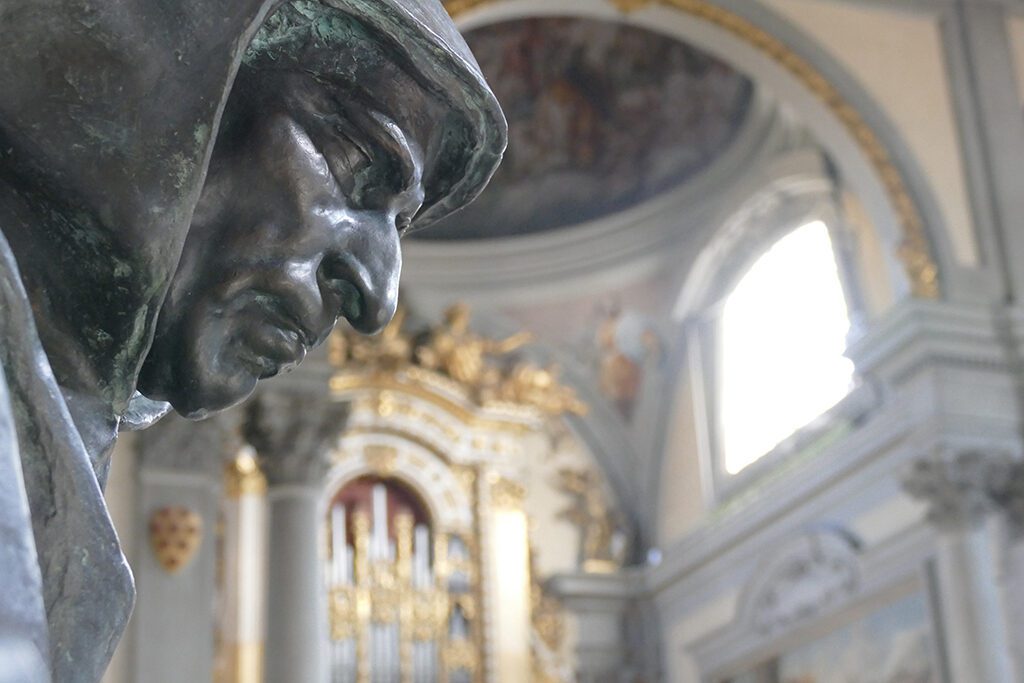
However, Pope Alexander VI. excommunicated Savonarola already in 1497 for “heretics, schismatics, and despisers of the Holy See”. In 1498, the Pope demanded that the penitential preacher was taken prisoner. Hence, an angry mob dragged Savonarola out of the monastery.
He was imprisoned, tortured, and sentenced to death. Together with his confreres Domenico Buonvicini and Silvestro Maruffi, Savonarola was hanged and then burned in front of a huge crowd in the Piazza della Signoria. As some women tried to take bones with them as relics, the piazza was closed. The following day, Savonarola’s ashes were scattered into the river Arno.
Museo San Marco
Piazza San Marco 3
50121 Florence
Open from 8.15 a. m. to 2 p. m.
Closed on the 1st, 3rd, and 5th Sunday of each month on each Monday after an opening Sunday.
Note: In the Cash, Cards, and Deals-section at the end of this post is a link to a page where you can buy tickets online. While this won’t save you money, but definitely spare time.
Sant’Apollonia
I’m totally fascinated by Italian frescoes – which are basically the predecessors of today’s artful graffiti. Sometimes, the fantastic trompe l’oeil at churches and beautifully painted ceilings at villas and museums even distract me from the pictures on display.
So while Ghirlandaio’s Last Supper is probably the most famous of its kind, there are many more cenacoli to be found at Florence. Most of the time, they were painted at the so-called refectories.
These refectories, hence, the monasteries’ dining halls, are places where a beguiling silence awaits the visitors. Here, you can experience art and history up close and in a very touching way.
The most important cenacoli that under normal circumstances are accessible to visitors are
- Taddeo Gaddi at the Basilica di Santa Croce – see below
- Andrea di Cione, called Orcagna, at the Basilica di Santo Spirito – see below
- Domenico Ghirlandaio at Chiesa di San Salvatore in Ognissanti – see below
- Domenico Ghirlandaio at the Museo di San Marco – see above
- Pietro Perugino at the Convent of the Sisters of Foligno
- Andrea del Sarto at San Michele a San Salvi
- Francesco Giudici, called Franciabigio, at Convitto della Calza
- Andrea del Castagno at Sant’Apollonia – don’t look any further
The monastery of Sant’Apollonia is just two blocks West of San Marco on Via Ventisette Aprile. It was founded in 1339 and later modernized and extended.

Today, visitors can access the former refectory free of charge. The hall has an elegant coffered ceiling and, obviously, the beautiful fresco by Andrea del Castagno.
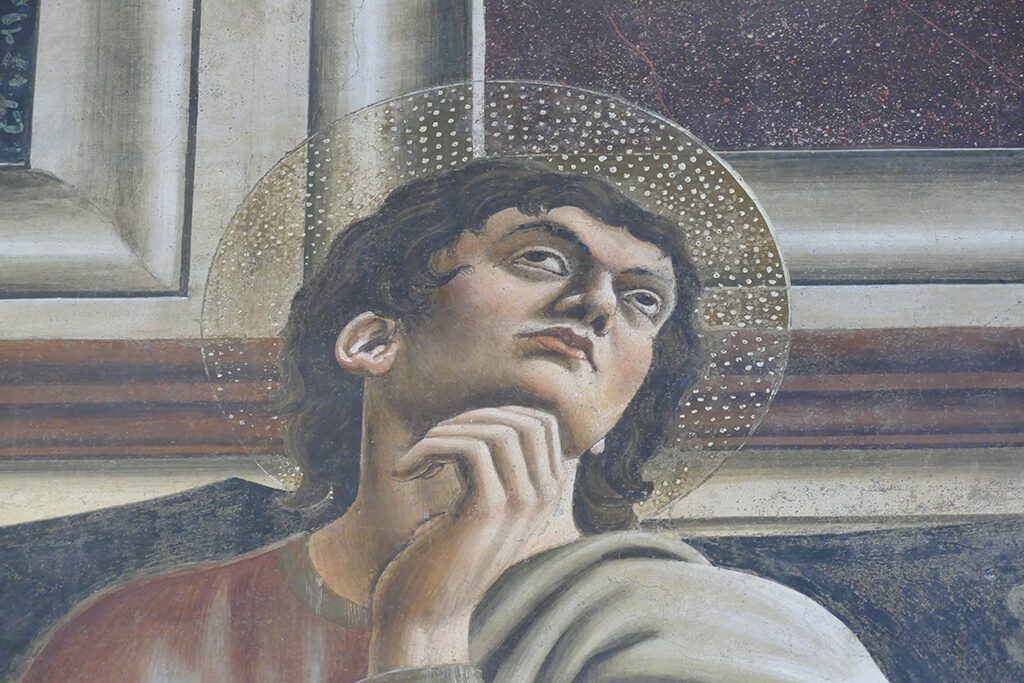
In 1447, the artist painted the Last Supper as if it was taking place in a small building. Since he left the front wall out, the viewer can actually see the interior. One of my favorite details are the precious marble boards in different colors on the wall behind the dining group. Also, the tenderly depicted persons are just beautiful and remind me very much of portraits by Boticelli and Filippino Lippi.
You can visit this tiny museum for free to admire also other frescos and paintings by for instance Neri di Bicci and Paolo Schiavo.
Sant’Apollonia
Via Ventisette Aprile 1
50129 Firenze
Open daily from 8.15 a. m. to 2 p. m.
Santissima Annunziata di Firenze
To get to the Santissima Annunziata, you just need to cross Piazza San Marco in the opposite direction. Then, just walk one long block on Via Cesare Battisti.
This church was founded already in the 13th century and houses one of the city’s most revered sanctuaries.
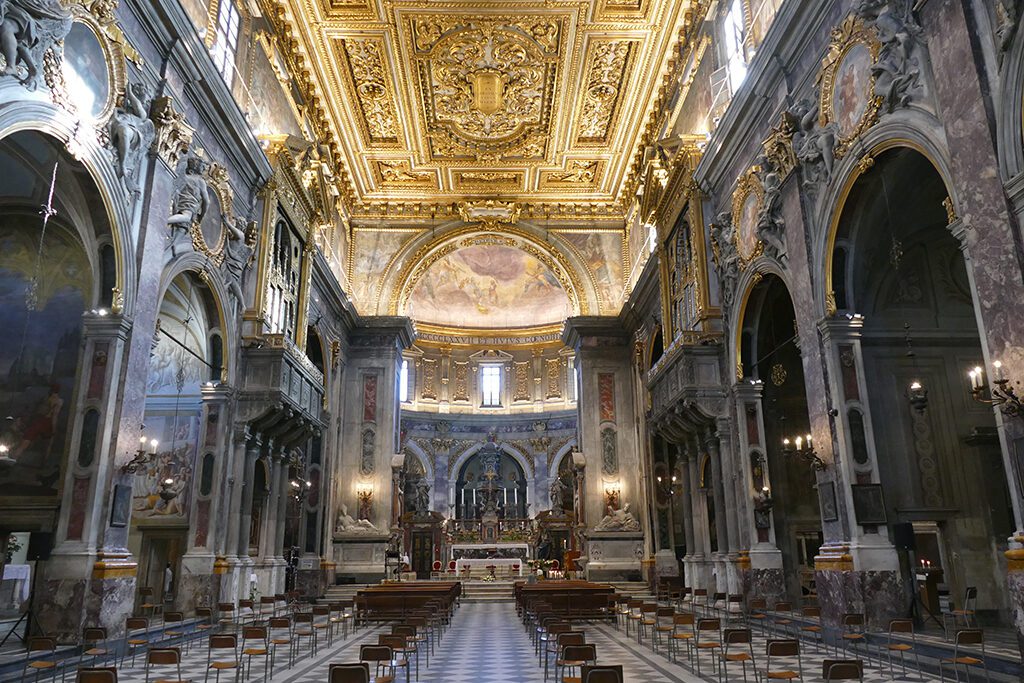
Santissima Annunziata, which translates to Holy Annunciation, got famous for a fresco of the Annunciation to Mary. According to a legend, this large-format miraculous painting was begun around 1250 by an alleged Master Bartolommeo and then completed by an elf angel.
Piazza di Santissima Annunziata
After you’ve visited Santissima Annunziata, you definitely should linger for a bit since the Piazza that was named after the church is surrounded by some truly amazing buildings.
Palazzo Budini Gattai
Across from the church is the Palazzo Budini Gattai – you can see it in the picture below to the right.
The exposed bricks adorning the façade are a rare example in Florence where the use of brick, especially in a monumental building, had never been established.

Actually, I had seen them before during the Venice Biennial in 2015 and eventually at various seasons of the NordArt shows.
Palazzo delle Due Fontane
To the left, you see the Palazzo delle Due Fontane. Its façade is relatively modern, adopting the shapes and colors of the nearby Palazzo Grifoni. It was remodeled at the end of the 19th century to grant an esthetically suitable appearance of the square – as you can clearly see in the picture above to the left.
Fontane dei Mostri Marini
The two fountains that gave the Palazzo its name were made by Pietro Tacca in 1626. However, they were placed on the square only in 1641 as a symmetrical counterpoint to the scenographic effect of the square that is dominated by the equestrian monument to Ferdinand I. as its central element.

In the picture above, you can spot one of the fountains. A copy was placed in the park of Villa Doria Pamphilj in Rome.
Monument to Ferdinand I.
The monument to Ferdinando I de Medici is scenographically placed in line with Via dei Servi and therefore visible all the way from Piazza del Duomo, seemingly framed by the central arch of the Santissima Annunziata’s portico.
It is one of the last works of Flemish artists Jean de Boulogne. Better known as Giambologna, clearly a corruption of the artist’s French name, he was famous for equestrian statues of various European rulers. He also designed the equestrian monument to Cosimo I. in the Piazza della Signoria.
Being Giambologna’s pupil, Pietro Tacca completed the monument after the master died in 1608.
Loggia of the Servants of Mary
In the picture above you can see the Loggia of the Servants of Mary, located on the North-Western side of the square.
It was built between 1516 and 1525 by Antonio da Sangallo the Elder and Baccio d’Agnolo in harmony with the design of the building on the square’s opposite side. Commissioned by the order of the Servants of Mary linked to the Basilica of the Santissima Annunziata, it harmoniously links the different structures around the square.
Noteworthy are the corbels inside the loggia, marked with the intertwined S of the Order of the Servants of Mary.
Palazzo della Crocetta
This palace owes its name to its proximity to the Crocetta monastery. It was built in 1619 as Princess Maria Maddalena de Medici’s home. Being the sister of the Grand Duke Cosimo II. yet born handicapped, she needed a residence that suited her rank and was at the same time easily accessible. In fact, the Princess spent basically her entire life in this residence. The architect Giulio Parigi created raised arches with passages above street-level. This way, Maria Maddalena could move freely without climbing stairs and at the same time, she was sheltered from curious glances.
A few years after her death, the connections were demolished and the building remodeled into an independent palace.
Today, it is the seat of Florence’s National Archaeological Museum.
Galleria dell’Accademia
You don’t have to walk far from the Piazza della Santissima Annunziata to get to one of Florence’s most important galleries.
Obviously, no visit to Florence would be complete without paying David a visit. No, I’m not talking about the replica standing in front of the Palazzo Vecchio. I’m talking about the real thing, Michelangelo’s true masterpiece standing at the Accademia di Belle Arti di Firenze.

This Academy of Fine Arts in Florence was founded by Cosimo I de Medici in 1563. In 1784, all sections were joined to one institution. Its purpose was the establishment of a modern art teaching institute that would also focus on the newly developed applied arts.
Becoming a Gallery
In 1784, the Galleria dell’Accademia was founded. As the gallery was separated from the school during the time of Firenze Capitale between 1865 and 1871, there was finally enough space to present the ancient as well as the modern collection to the public in one venue.


In 1872, Michelangelo Buonarroti’s David moved in. In exchange, the Academy provided a copy to be placed in Piazza della Signoria.
Galleria dell’Accademia
Via Ricasoli 58/60
50129 Firenze
The gallery is open from Tuesday to Sunday from 9 a. m. to 6.15 p. m., Tuesdays and Thursdays also from 7 p. m. to 10 p. m
Especially during public holidays and high season, I highly recommend purchasing tickets online in advance – despite the additional booking fee.
Opificio delle Pietre Dure
I don’t remember where I’d heard of this gallery and why I visited. All I know is that from my first visit on, the opificio has been one of my favorite venues in Florence. Maybe I just stumbled in by accident since it’s around the corner from the Galleria dell’Accademia – literally two minutes away.
It’s neither the largest nor does it house the most famous works. However, it’s just so unique and ingenious – I enjoy my visits time and time again.

The first Opificio delle Pietre Dure, hence the workshop of stones, goes back to the old handicraft and art workshops of the Grand Duchy of Florence. In 1588, they were established in the former monastery of San Niccolò by Grand Duke Ferdinando I de Medici – the one riding a horse on the Piazza della Santissima Annunziata.
At this workshop, works like inlays in semi-precious stones were produced and are still made today. This also where workers were trained to decorate the large Medici Chapel with inlaid marble at the Basilica di San Lorenzo.
Set in Stone
However, the major part of the most impressive works were designed by Neoclassicist artist Giuseppe Zocchi.
Although he was mainly famous for vedutas of Florence that are a precious document of eighteenth-century Florence, since 1749, the artist has also dedicated himself to make designs for inlays in semi-precious stones.
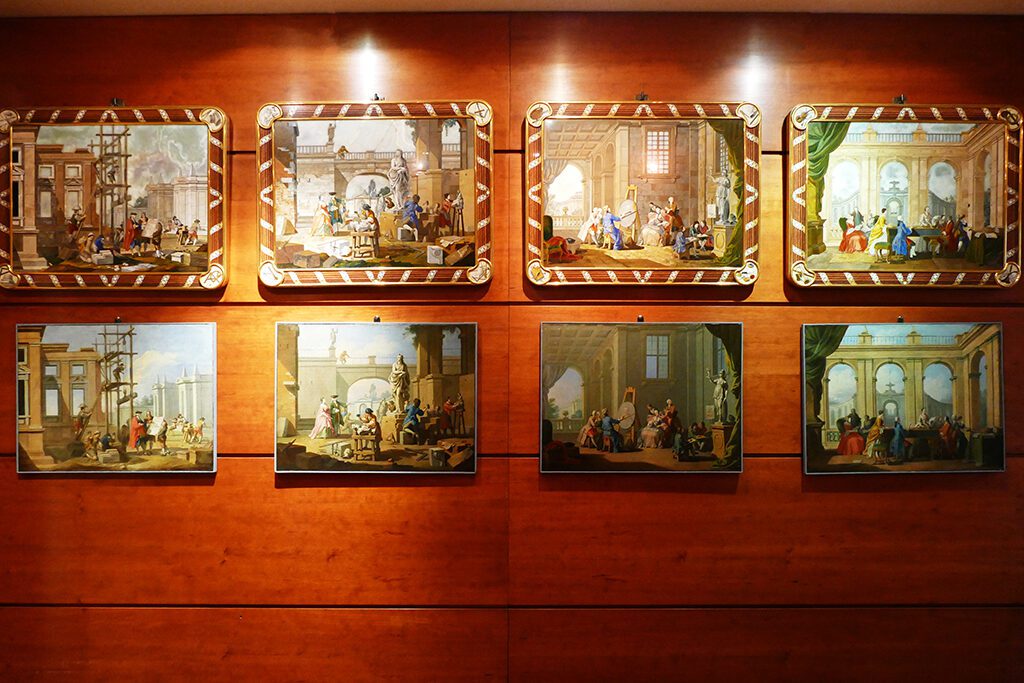
Zocchi’s were fantastically inventive, graceful, and suited the fashionable subjects of his time. There were the aforementioned vedutas, but also views of fantastic ruins, landscapes, allegorical themes, and bourgeois salon scenes.

Today, Zocchi is far less renowned than he deserves, however, in his time, he was very successful and worked for commissioners as important as the Habsburg emperor and the King of Prussia.

The museum has been open to the public at its current exhibition rooms since 1862.
There are amazing works with stone inlays like cupboards, tabletops, and various panels decorated with flowers, fruits, and birds. However, there also landscapes and cityscapes like the Piazza della Signoria.
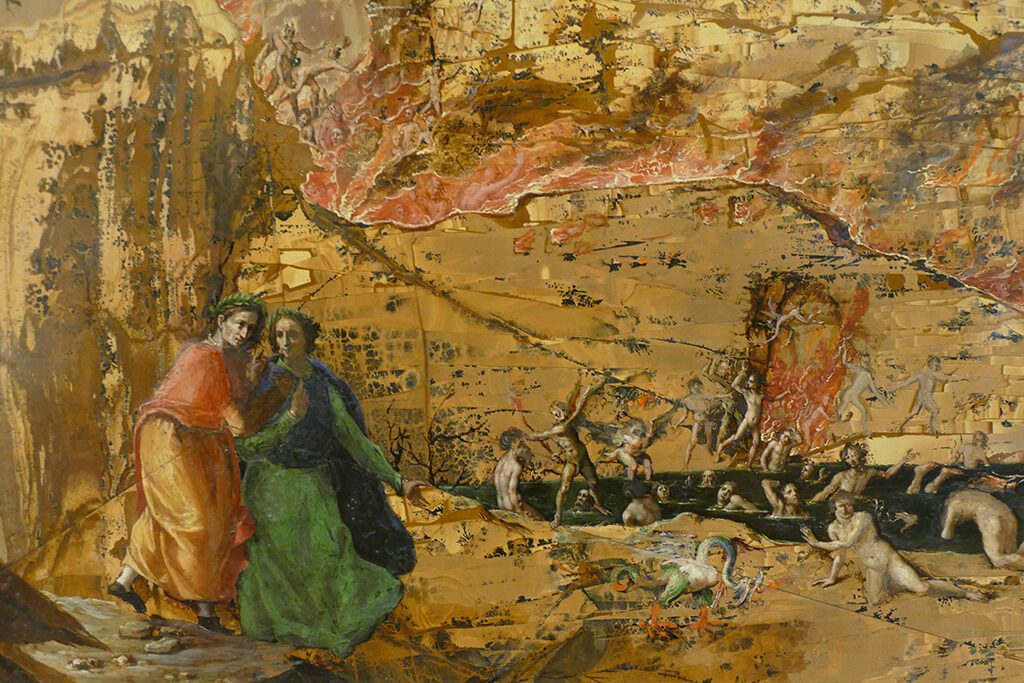
On the museum’s upper floor is a comprehensive collection of inlay tools and stones.
You see, the Opificio delle Pietre Dure is a hidden….gem – literally!
Opificio delle Pietre Dure
Via degli Alfani 78
50122 Firenze
The gallery is open to the public from Monday to Saturday from 8.15 a.m. to 2 p.m.
Cathedral of Santa Maria del Fiore
From my secret treasure box that is the Opificio delle Pietre Dure it’s only two long blocks down the Via Ricasoli to get you to the Cathedral of Santa Maria del Fiore. Although, everybody refers to this magnificent and huge piece of art as the Duomo. Despite the fact that the Piazza della Signoria is widely considered the most important square – mostly due to the fake David – to me, it was the Piazza del Duomo that I remembered vividly even decades after my first visit to Florence.
Up until the 13th century, there was only the Baptistery of San Giovanni and a few smaller churches around Florence. It was not until 1296 that Arnolfo di Cambio was commissioned to…change that; cambio, change…pun totally intended.
Di Cambio’s building had to have a size – and grandeur – that Tuscany had never seen before. After all, Florence was competing with Venice, Pisa, and even Siena.
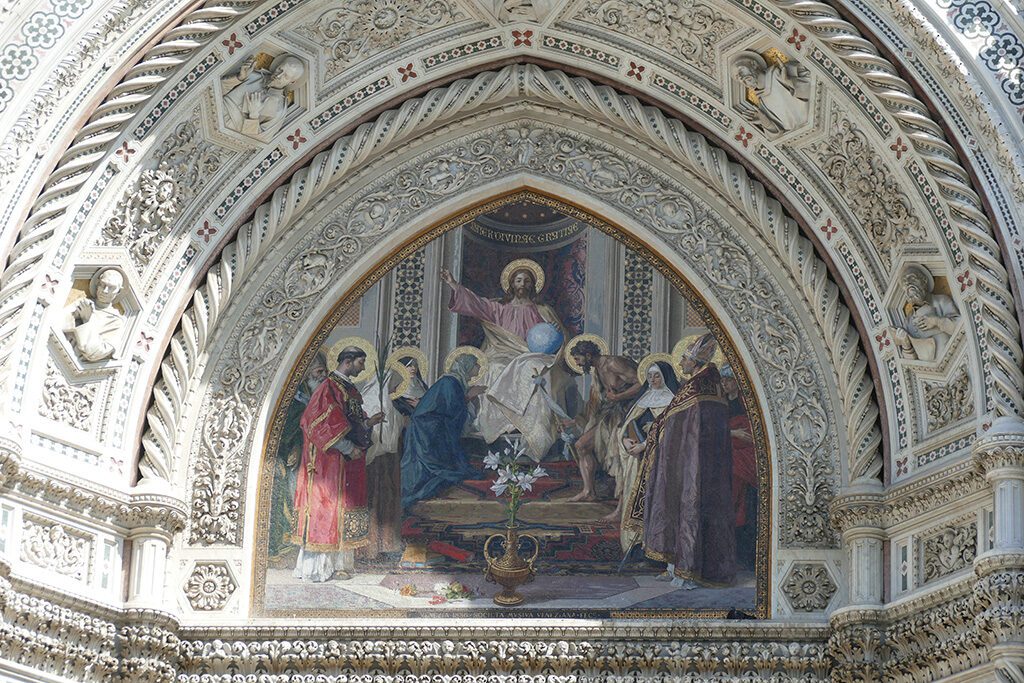
The original bishop’s church, Santa Reparata, was initially surrounded by the new building and continued to be used for liturgical purposes. After Di Cambio died in 1310, work came to a halt as the resources were used to build the Palazzo Vecchio as well as a third city wall. Finally, the building was completed only in 1436. The façade is beautifully covered by marble panels in various shades of green and pink, bordered by white.
On top of the portal are niches with the twelve Apostles with. In their middle is the Madonna with Child.
This Rings a Bell
The tower foundations had already been laid in 1298 at the start of the construction work. Later, no less than Giotto di Bondone was assigned to design a free-standing Campanile. The master, by then already 68 years old, planned a tower about 110 meters high and with a pyramidal top. When Giotto died in 1337, only the first floor was completed. Hence, Andrea Pisano and Francesco Talenti finished the construction in 1359 by adding a few changes. Finally, the tower is now only 85 meters high.
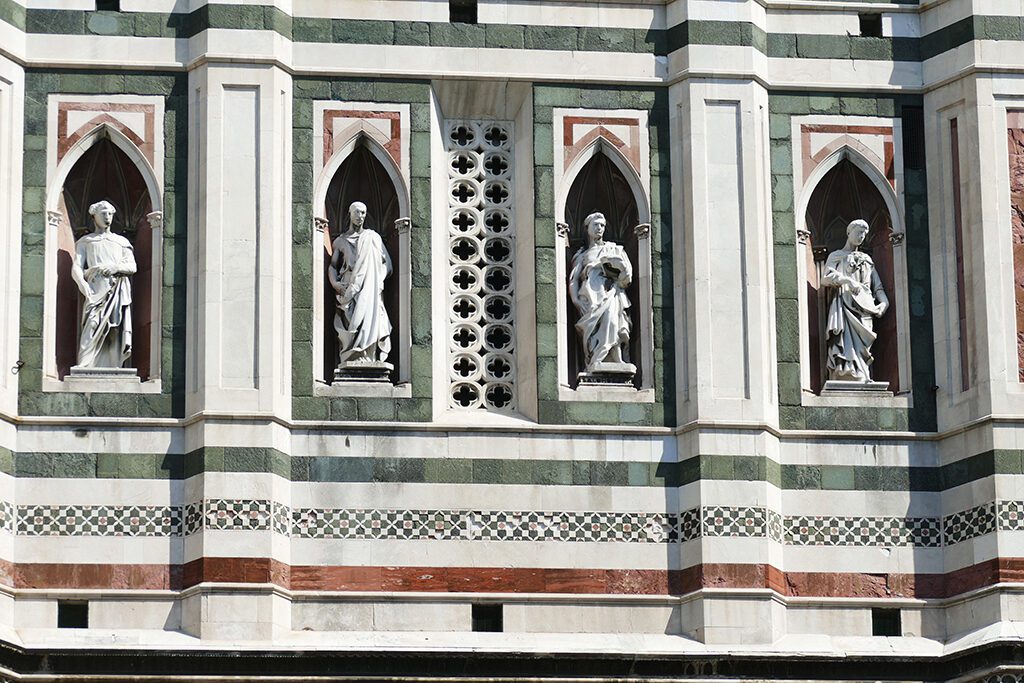
I assume that today’s visitors are very grateful for that. Yes, you can climb the tower taking the stairs with 414 steps. No, there is no lift. Hence, the climb is not for people who suffer from vertigo or claustrophobia – or who are simply not that fit.
Welcome to the Pleasure Dome
Without a doubt, the cathedral’s huge dome is the building’s most impressive feature and actually considered a technical masterpiece of the early Renaissance.

In 1417, Filippo Brunelleschi presented his first model of the dome. Then, the construction of the 107-meter high cupola with a diameter of 45 meters took 16 years. From the beginning, the two-shell construction was self-supporting and erected without any falsework.
While the Duomo is such an impressive and beautiful structure from the outside, on the inside, it’s surprisingly austere. Since the space is so huge – the nave can accommodate around 30,000 people – the relatively few masterpieces seem to get somehow lost. The church has a feel to it as if it’s undergoing construction. In reality, this unadornment corresponds with Girolamo Savonarola’s ideals of simplicity and rigidity of religious life.
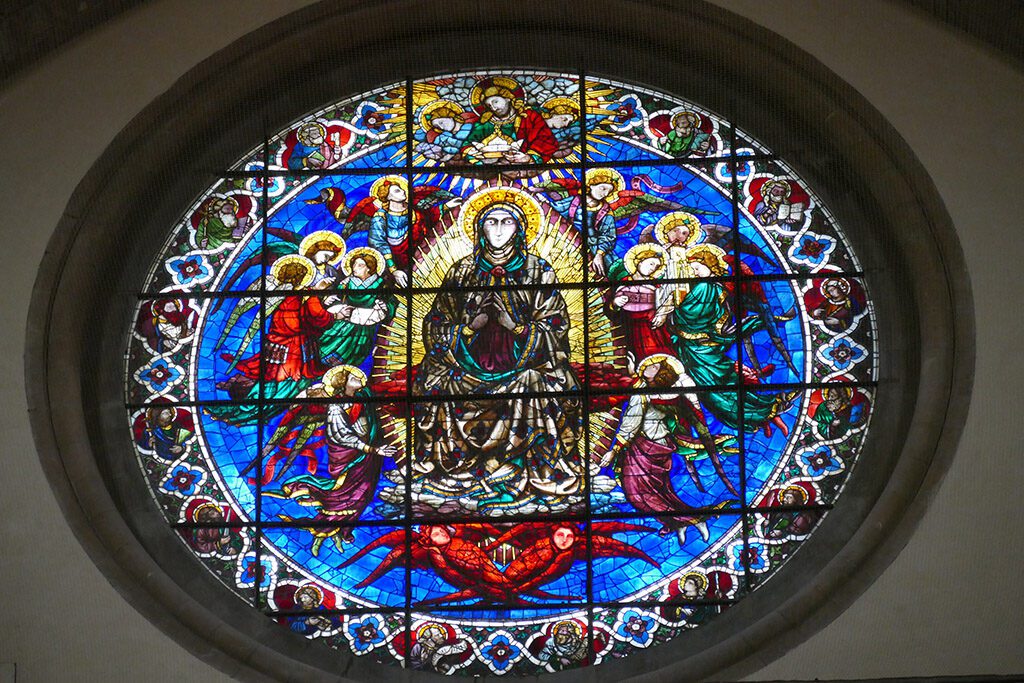
Battistero di San Giovanni
Across from the Duomo’s main portal is the Baptistery of San Giovanni, a fine example of the Florentine Proto-Renaissance. Constructed at the turn of the 12th century, it is one of the city’s oldest buildings. One of Florence’s most famous sons Dante Alighieri was baptized here as were other notable burghers like the members of the Medici family.

In this picture, you can see the panel The Story of Abraham. It is on the lower left side of the eastern door.
The baptistery’s octagonal shape was long thought to be an old Martian temple. There are three artistically significant bronze portals. Between 1330 and 1452, the south doors were designed by Andrea Pisano and those in the north and the east by Lorenzo Ghiberti.
Today, the baptistery bears the papal honorary title Basilica minor.
It is likely that the baptistery of San Giovanni in Laterano, I’ve introduced it in my post on Rome, was the model for the Florentine baptistery.
How to Visit
While the entrance to the Duomo itself is free of charge, you need a ticket for the museum. This gives you also access to all the other structures belonging to the Duomo such as the crypt with Brunelleschi’s tomb, the cupola, the baptistery, and the bell tower. This ticket is valid for 72 hours after your first entrance. The complex is open daily from 10 a. m. to 5 p. m. and especially on holidays or during high season, buying tickets in advance online is highly recommended.
Chiesa e Museo di Orsanmichele
While the Duomo is more impressive on the outside, the next landmark has a nice balance of a grand façade and impressive art treasure inside.
Walking down Via dei Calzaiuoli takes you to the church-building of Orsanmichele. This structure from the Romanesque and Gothic eras forms an entire block between the streets Via dei Calzaiuoli, Via dell‘Arte della Lana, Via dei Lamberti and Via Orsanmichele.
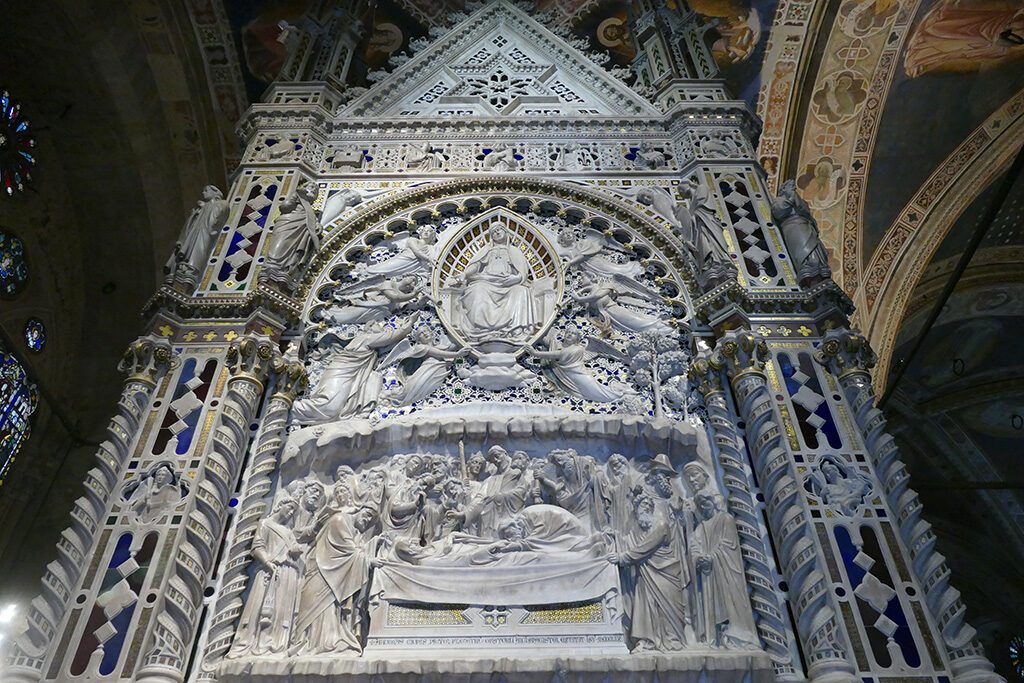
Being part of the Bargello network, the museum on the first floor houses art from the fifteenth to the sixteenth century. The most famous piece is the marble tabernacle of the Madonna delle Grazie. From the second floor, you have a panoramic view of Florence.
The church is open every day from 10 a.m. to 5 p.m. while the museum opens only on Mondays from 10 a.m. to 5 p.m. and Saturdays from 10 a.m. to 12.30 p.m. The entrance is free.
Palazzo Vecchio
Arnolfo di Cambio planned the palazzo which then was completed in 1314. As the seat of the city parliament, it was originally called Palazzo della Signoria – the Signoria was the government of the republic. Hence, it represented the secular power in the 14th century. This explains the structure’s sturdy and well-fortified architecture as it granted major security and protection against attacks.
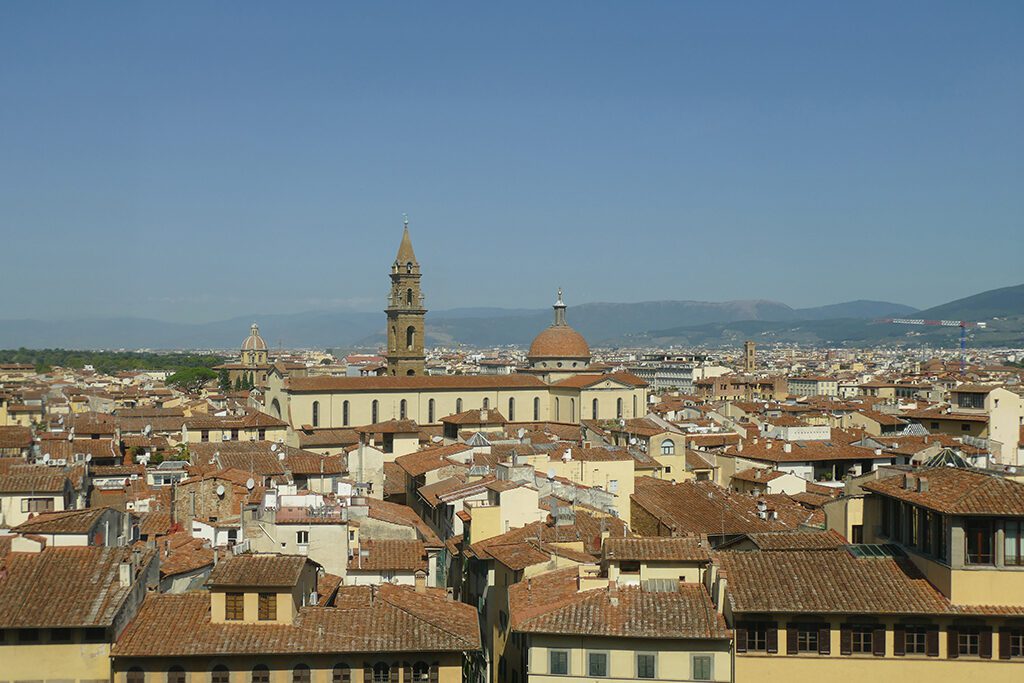
Today the Palazzo Vecchio is Florence’s town hall. Nevertheless, it’s open to touristy visits and is one of the city’s not-to-be-missed landmarks.
Standing on top of the ancient theater of the Roman colony of Florentia from the 1st century, it forms a microcosmos where art and history have been intertwined for centuries.
As the court of the Medici was transferred to Palazzo Vecchio, the building was transformed into an enthralling labyrinth of chambers, apartments, terraces, and courtyards. All the rooms are magnificently decorated by artists such as Michelangelo, Giorgio Vasari, and Donatello.

The highlight is the Salone dei Cinquecento, the Hall of the Five Hundred. No less than Leonardo da Vinci and Michelangelo Buonarroti were commissioned to paint large murals depicting the Republic’s glorious victories.
How to Visit
The Palazzo Vecchio can be visited from Friday to Wednesday between 9 a.m. and 7 p.m. and Thursdays till 2 p.m.
Children under 6 years are not allowed to go on the tower and people with heart or breathing conditions as well as otherwise physically impaired persons should refrain from climbing.
Full entrance fee to either the tower or the museum is 10 €uros, the combined ticket 14 €uros.
In addition, there are several tours of Palazzo Vecchio such as a Tour of the Secret Passages or Dan Brown’s Inferno Tour. However, keep in mind that these visits will set you back almost 50 €uros each.
Piazza della Signoria
If for whatever reason you won’t be able to visit the palace, just walking around the Piazza della Signoria is actually the next best thing. Honestly, this square is practically an admission-free open-air museum!
Besides the splendid buildings surrounding the square such as the Tribunale della Mercanzia, the Palazzo Uguccioni, and the Palazzo delle Assicurazioni Generali that now houses the Cafè Rivoire, there are replicas of many glorious sculptures.
The most noticeable ones are certainly the Neptune Fountain by Bartolomeo Ammanati and the equestrian statue of Cosimo I. by Giambologna. Yes, the Flemish artists that also got Cosimo’s son Ferdinand I. back on the horse on the Piazza Santissima Annunziata.
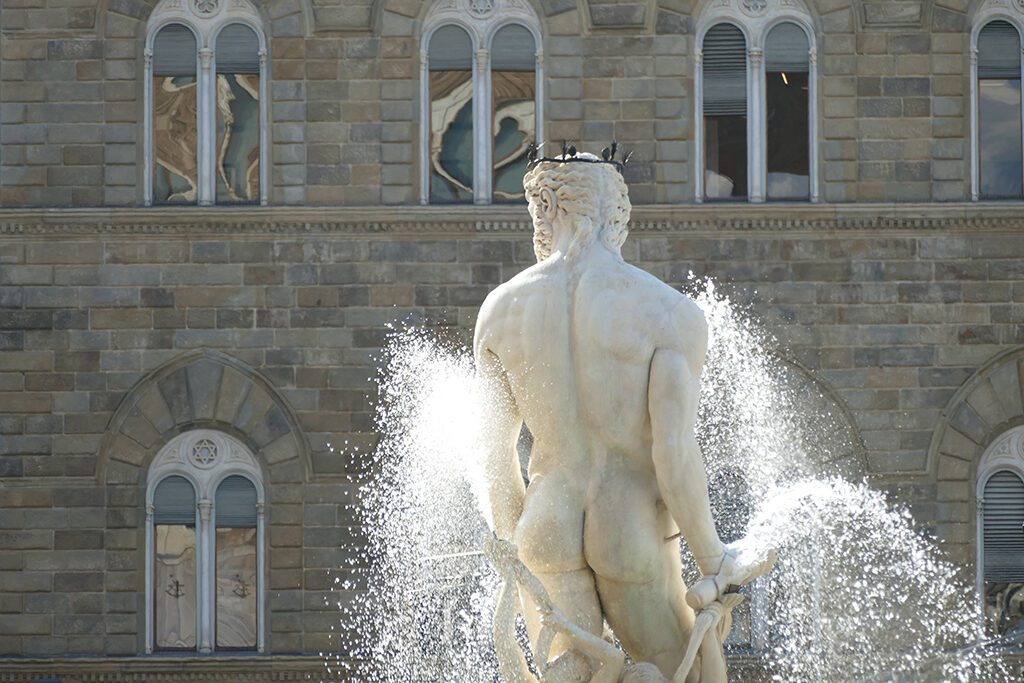
However, there is a bronze group of Judith and Holofernes whose original by Donatello is in the Palazzo Vecchio and, obviously, a replica of Michelangelo Buonarotti’s world-famous David. Together with Baccio Bandinelli’s Hercules and Cacus, it flanks the palace’s main portal.
Loggia dei Lanzi
Right next to the Palazzo Vecchio is a grand open-air exhibition – totally free of charge. The Loggia dei Lanzi was built between 1376 and 1382 by Benci di Cione and Simone di Francesco Talenti. The arcade was originally used for rallies and receptions of the Republic of Florence. Eventually, it was named after the mercenaries – lanzichenecchi in Italian.
The statues in the Loggia build three rows. In the first one, flanking the staircase, are the much-admired Medici lions. Although not all sculptures are originals, the replicas are so exquisite that even a layman might not be able to tell the difference.

The loggia used to be accessible around the clock. However, due to repeated vandalism, it is now guarded and open from 8 a. m. to 7 p. m.
Between 11 a. m. and 5 p. m., a maximum of 50 people at a time is admitted to visit for up to 15 minutes.
Trivia: The Feldherrnhalle in Munich was built after the model of the Loggia dei Lanzi.
Galleria degli Uffizi
In 1560, Cosimo I. de Medici intended to combine the most important ministries and offices under one roof. Designed by Bernardo Buontalenti, Alfonso Parigi the Younger, as well as the glorious Giorgio Vasari, the Uffizi then were constructed between 1560 and around 1580.
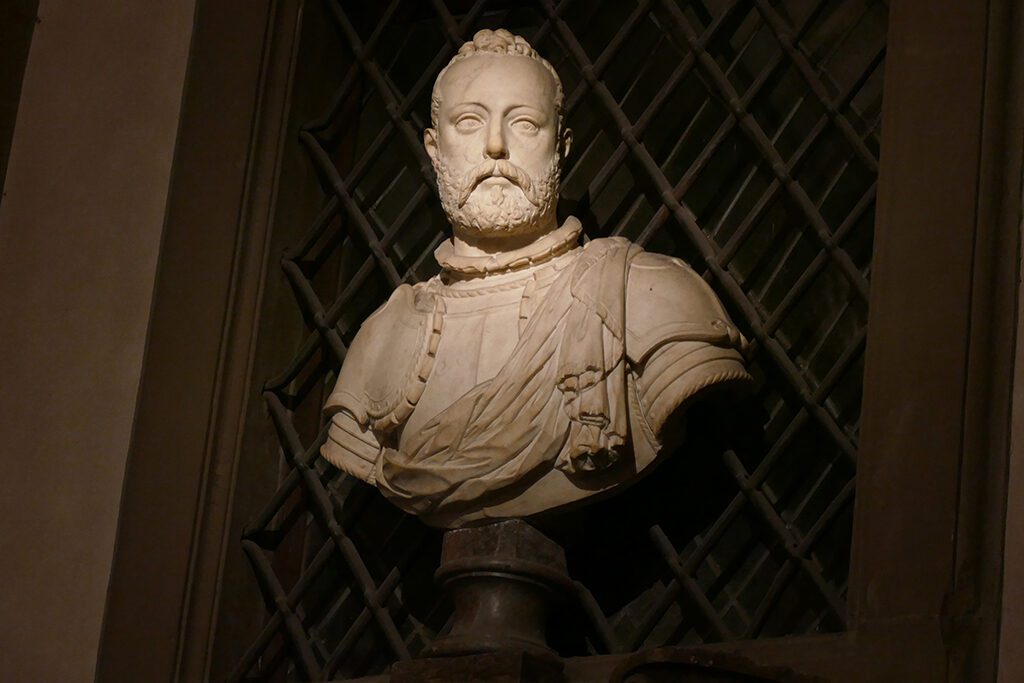
However, the building finally was stocked with the Galleria degli Uffizi art collection. In the beginning, it consisted of paintings and sculptures from antiquity to the late baroque.

Anna Maria Luisa de Medici was the last member of the Medicis. She bequeathed the family’s property to her hometown on the condition that it would never be removed from the city.

After she died in 1743, the collections were made accessible to the public.
A Star is Born
In the 18th century, the Uffizi collection had already achieved fame beyond Florence’s city limits. Hence, many art historians consider it the first museum in Europe.

Howsoever, today, the Uffizi are one of the world’s most famous art museums.
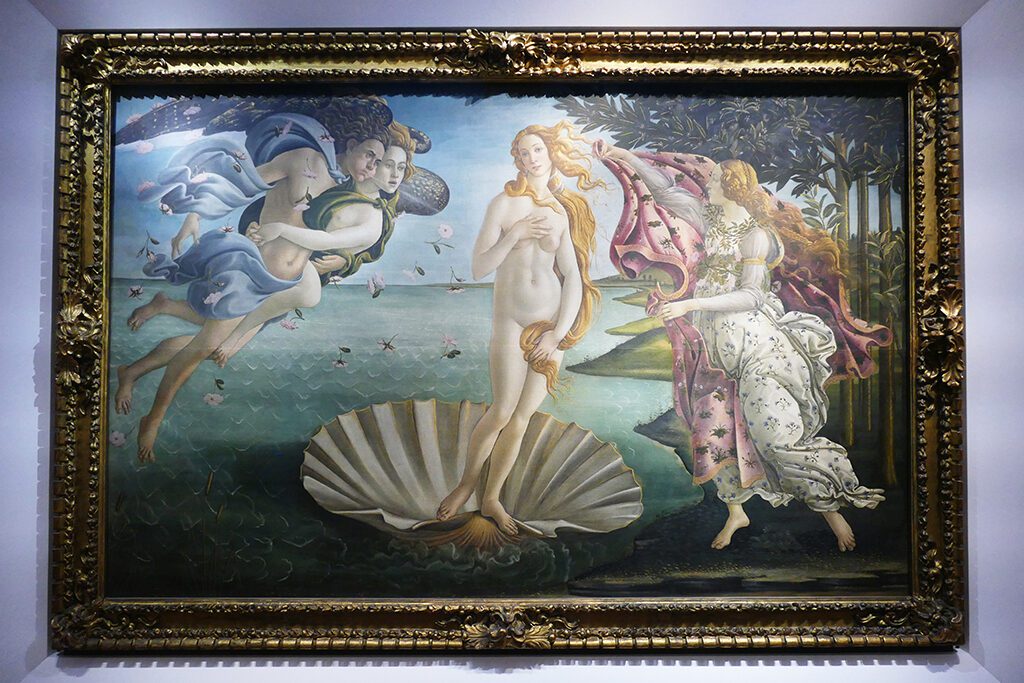
The collection focuses on works of the Italian Renaissance and is housed on the third floor of the building. However, there are also paintings from the 13th to 18th centuries including many masterpieces of Flemish, Dutch, French, and German artists.
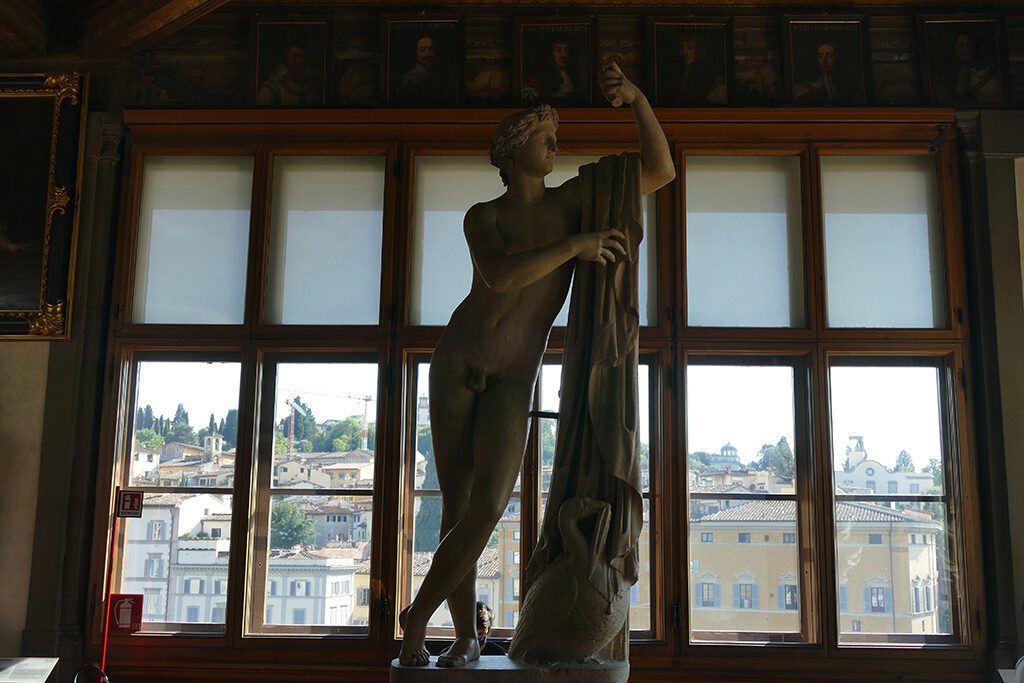
One of the most impressive features is the extensive exhibition of self-portraits from all eras up to the present day that welcomes the visitors in the striking Corridoio Vasariano.

As a matter of fact, this part of the building, also built by Vasari, connects the Uffizi Gallery on one side with the Palazzo Vecchio and on the other side via the Ponte Vecchio with the Palazzo Pitti.

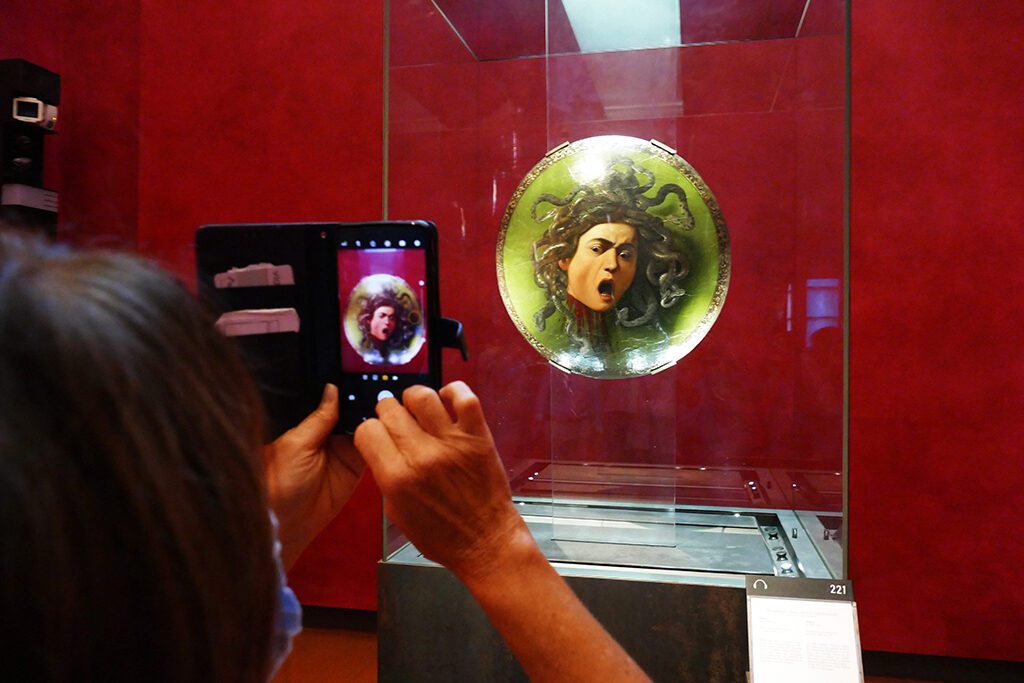


How to Visit
The Uffizi are open from Tuesday to Sunday from 8.15 a.m. till 7 p.m., the regular entrance fee is 12 €uros.
If you book ahead online – which I highly recommend – you have to pay an additional booking fee of 4 €uros.
A great deal is the Passepartout Day Pass. For 38 €uros, you can visit the Uffizi, the Pitti Palace, the Boboli Gardens, the National Archaeological Museum, as well as the Opificio delle Pietre Dure on three consecutive days. During off-season from November to February, this pass costs only incredible 18 €uros!
The only catch is that your first visit has to be the Uffizi. After that, you can use your pass as you please.
Ponte Vecchio
Following the course of the Corridoio Vasariano, the Vasari Corridor, you’ll get to the Ponte Vecchio. It is our final stop of the vertical axis through Florence.
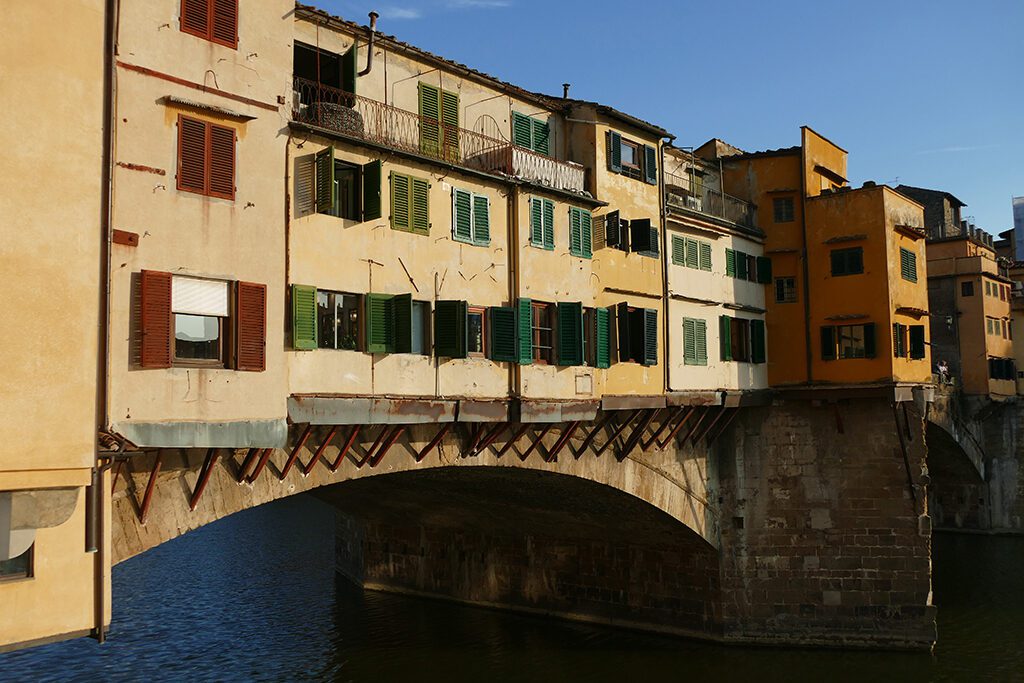
Already in Etruscan times, there was a passage across the river Arno. A deluge in 1333 had not only inundated large parts of the city. It also destroyed that wooden bridge. Consequently, today’s stone bridge was constructed between 1335 and 1345.
A row of small shops lines the bridge which is one of Florence’s major tourist attractions. In the untilled central part, it grants fantastic views of both banks of the river.
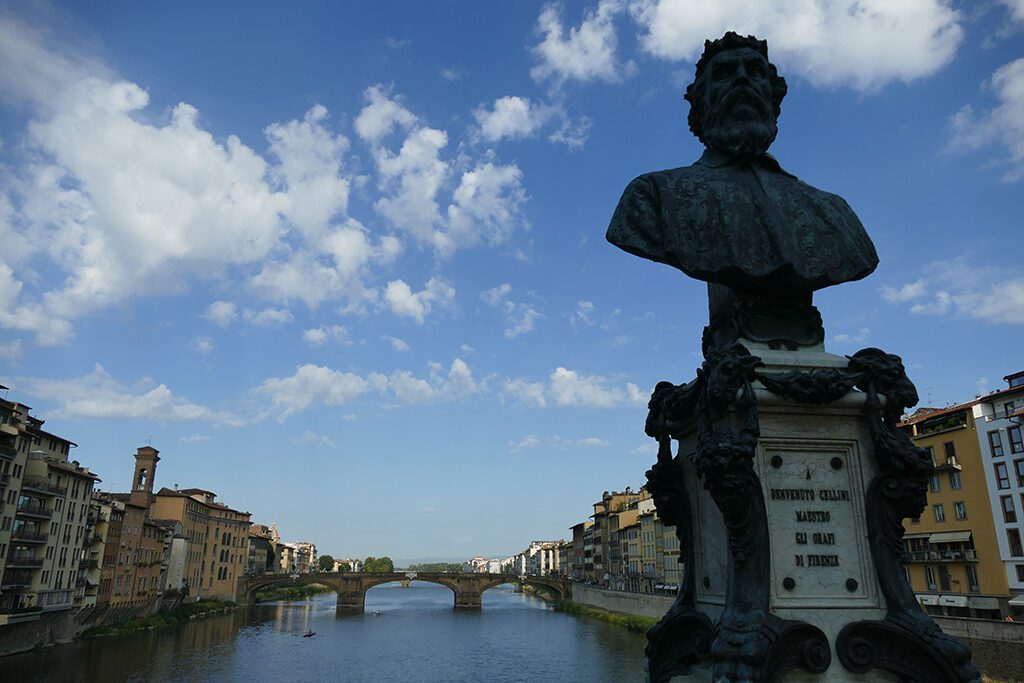
In 1565, Giorgio Vasari built the above-mentioned passage over the row of shops. They are part of the so-called Vasari Corridor, which connects the Palazzo Vecchio with the Palazzo Pitti.
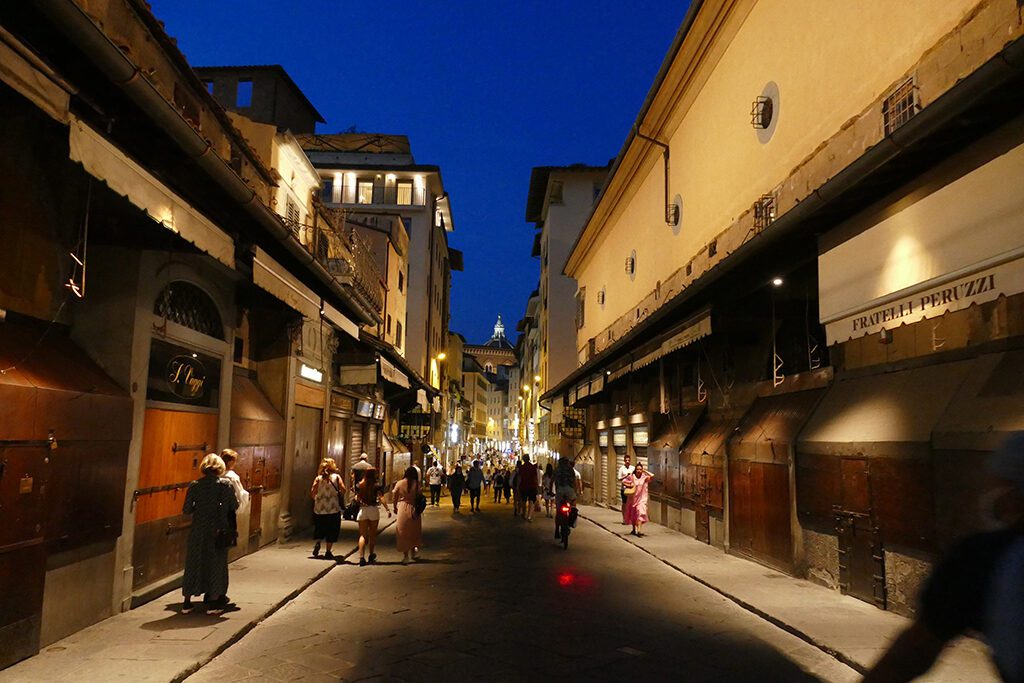
By decree of Cosimo I., the butchers and tanners that initially occupied the shops on the bridge were evicted and replaced by goldsmiths.
To this date, there are still numerous jewelers in the darling small shops on the bridge.
The East-West Axis
While most of the greatest landmarks are along the above sketched North-South Axis, there are some of the most amazing sites as you walk from the east to the west. Adding some minor detours, you then can also add some of the attractions from the other walks, especially as the axis are crossing at Via dei Calzaiuoli.
Le Murate Progetti Arte Contemporanea
The Murate Art District is located about 20 minutes walking from the city center. Therefore, if you prefer, you can start this walk on the other end of this route which is the famous Basilica of Santa Maria Novella. In that case, you’ll finish at the MAD.
If you are too tired to walk back, you can return to the center on bus #14 from the stop Agnolo towards Santa Maria Maggiore.
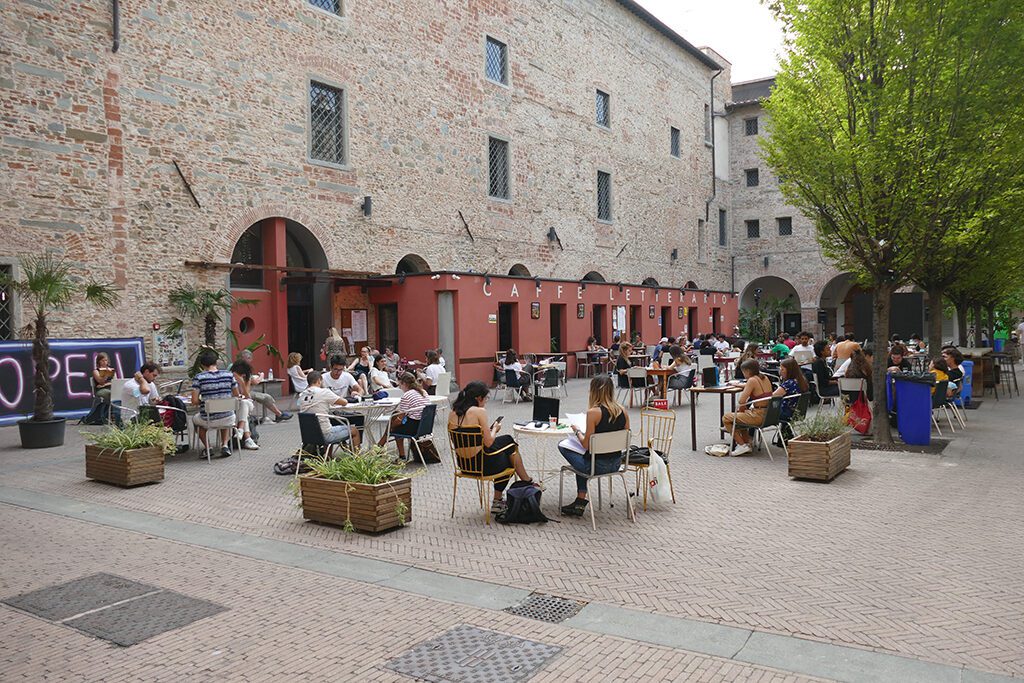
Howsoever, those structures were built as a Benedictine convent, namely the Monastero delle Murate, in the 14th century. Yet, from 1883 till 1985, it changed its clientele from pious women to rogue men as it became the city’s prison.
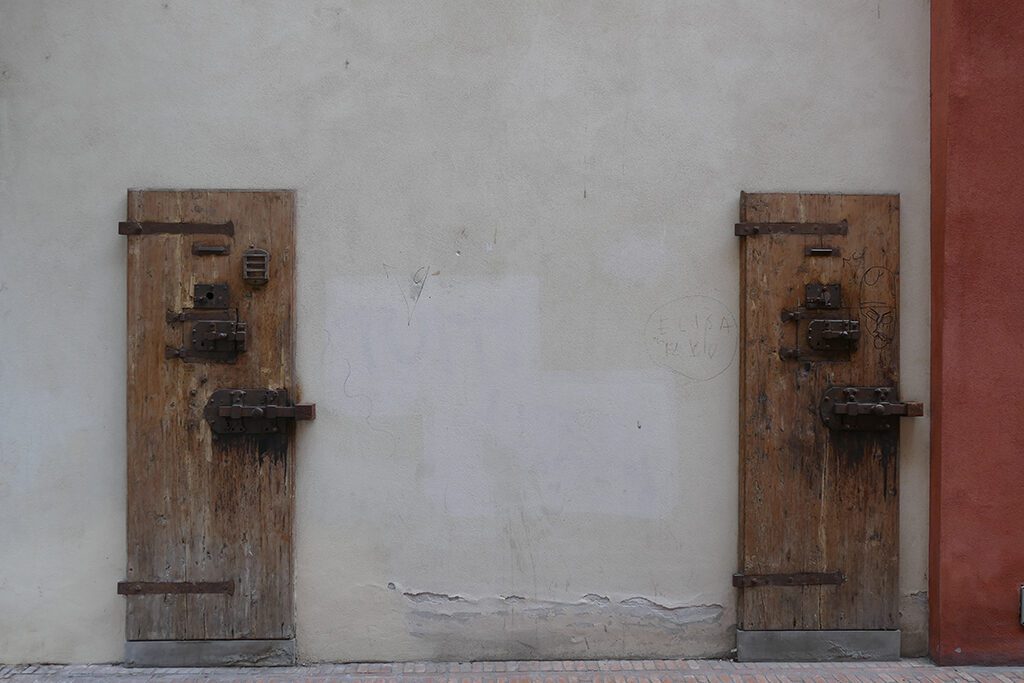
In 2004, the legendary architect Renzo Piano – I’ve introduced his iconic works in my posts on Athens and Paris – began remodeling the structures. In contrast to its former purposes, Piano transformed the buildings into inviting and communicative, inspiring and creative spaces. The complex became a beautiful contemporary nucleus for residential, communal, and artistic purposes.
Piazza di Santa Croce
Walking from the Art District towards the center, you’ll reach the Piazza di Santa Croce in less than ten minutes.
There is so much excellence in Florence, it’s difficult to crown a beauty queen. But if I had to, it would probably be this square. With all those slightly weathered palaces, today, it looks a bit like a theater stage. No wonder that in the Renaissance, it became the ideal place for knightly jousting, parties, shows, and popular competitions.
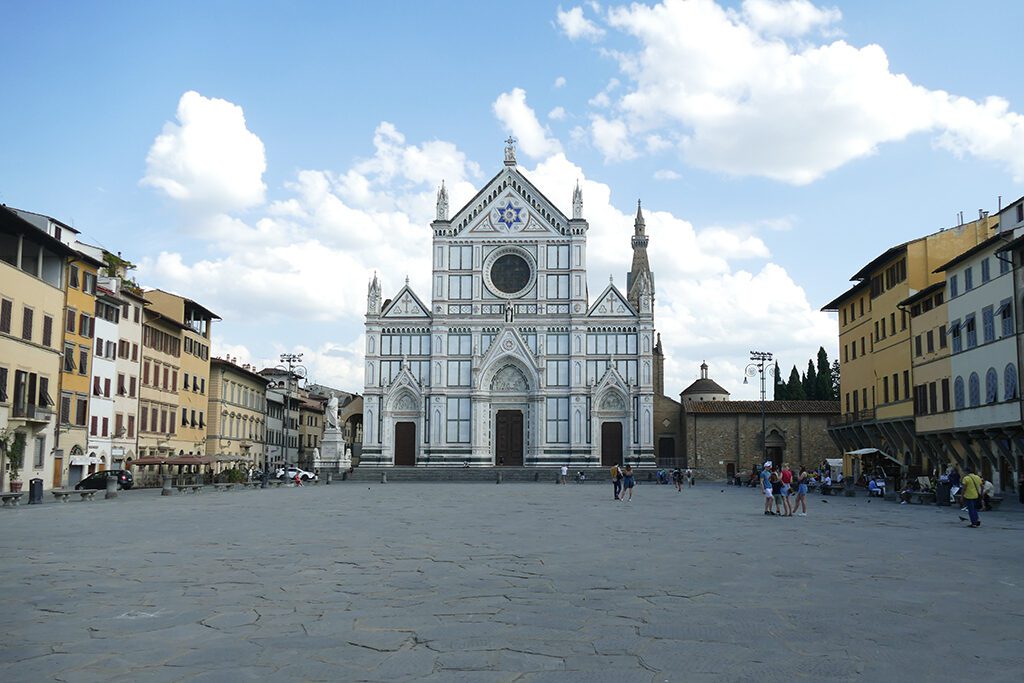
In the early 13th century, Franciscan monks arrived in Florence. They chose this area for their settlement since in those times, it actually was an island. The Arno separated into two arms near the current Piazza Beccaria and rejoined in front of the walls that passed at the height of via Verdi. To this date, the nearby Methodist church is called San Jacopo tra i Fossi, Saint James between the ditches.
Basilica di Santa Croce
But let’s now deal with the most noticeable building around the square, namely the Basilica di Santa Croce.
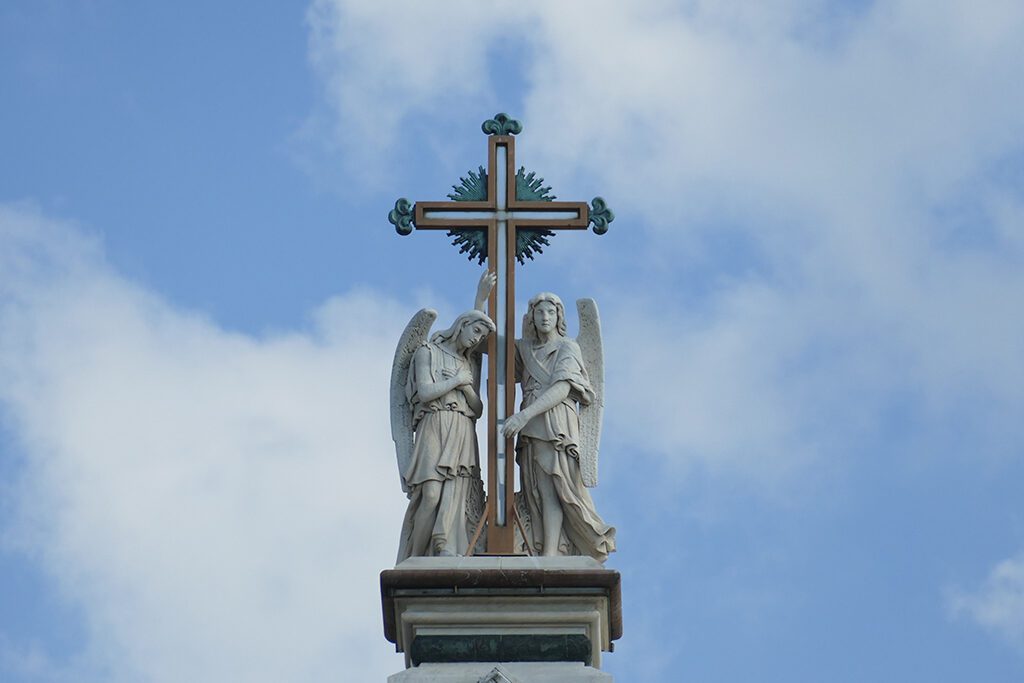
The laying of the foundation stone for the current building is said to have taken place in 1295, according to a legend by St. Francis of Assisi himself. Howsoever, the blueprint came from the architect Arnolfo di Cambio, who – as I’ve explained above – also designed Santa Maria del Fiore. Brunelleschi designed the Cappella dei Pazzi at the cloister south of the church. It was commissioned by the Pazzi family in 1430 but actually never completed.
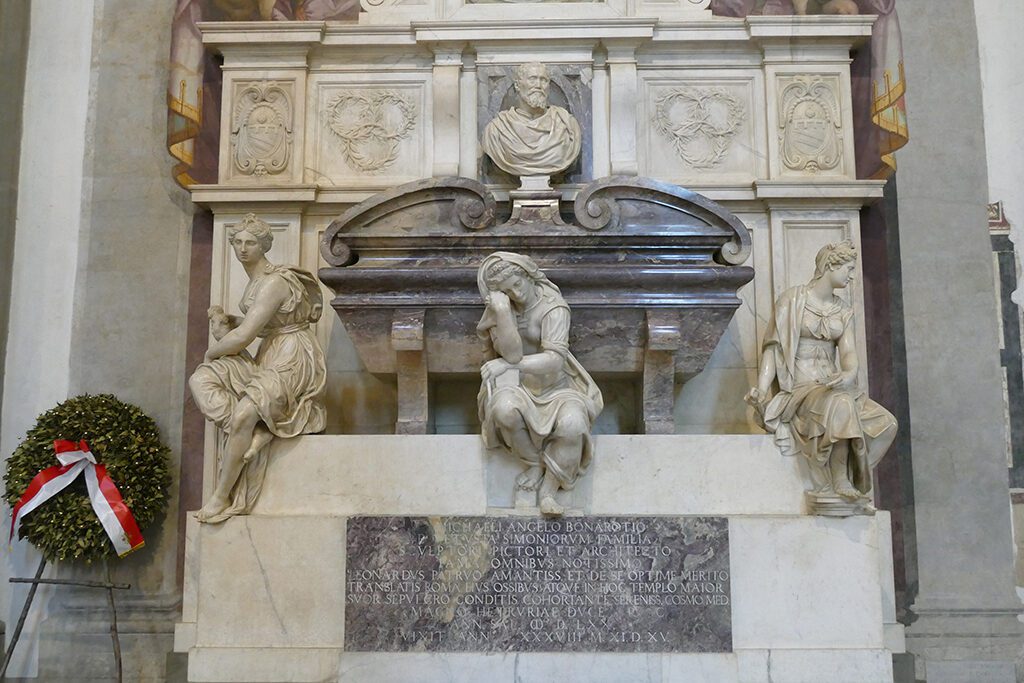
Santa Croce is basically Florence’s Pantheon. Inside the church are the tombs and memorials of Dante Alighieri, Machiavelli, Michelangelo, Galileo Galilei, and many other famous Italians.
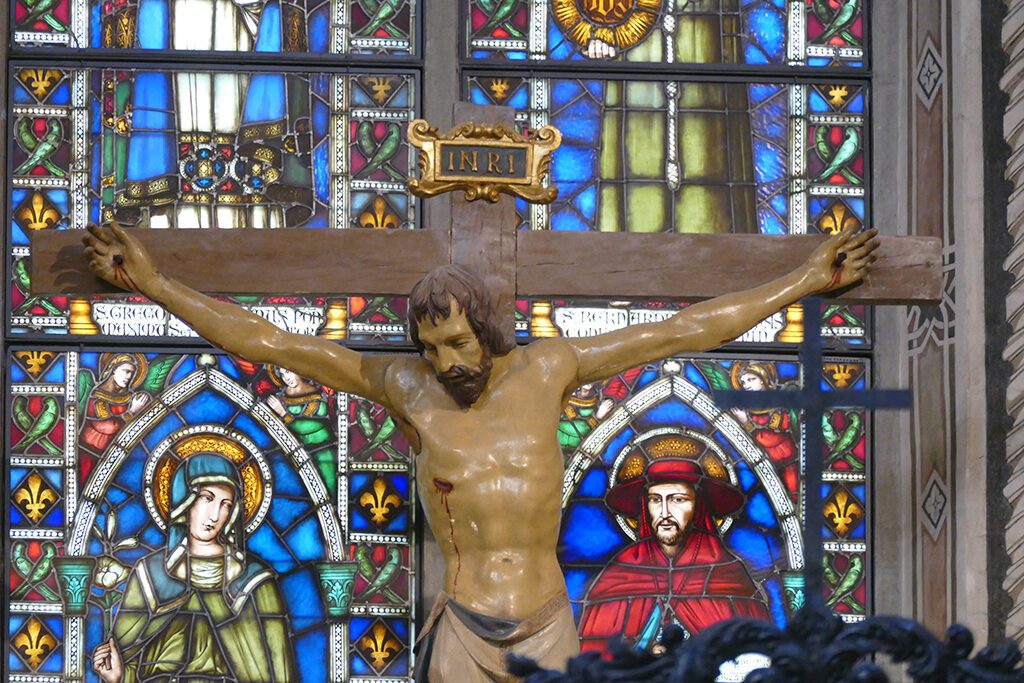
Also, there are numerous masterpieces from the 14th century such as the crucifixes by Cimabue and Donatello. No less than Giotto painted the frescoes from the life of the Evangelists John and John the Baptist at the Peruzzi Chapel. Taddeo Gaddi designed the scenes from the life of Mary in the Baroncelli Chapel, to name just a few.
Before we move on to the other parts of Santa Croce, here a horrible story: In 2017, a stone of about 15 by 15 centimeters in size fell from the ceiling and killed a Spanish tourist. The stone had loosened from the ceiling at a height of about 20 meters and fell directly on the tourist’s head.
Dinner With Gaddi
As you leave the church through the side door, you first get to the Pazzi Chapel and then to the refectory.
As mentioned above, the Pazzi family commissioned no less than Filippo Brunelleschi to design their chapel.
Fun fact: Pazzo means crazy in English, pazzi consequently being the plural. Therefore, until I learned that there was a wealthy family with this quirky last name, I believed the structures had been kind of an asylum for the mentally ill, to put it politically correct. Joke’s totally on me, I know.
Crossing the backyard, you’ll get to the refectory of Santa Croce. Here you’ll admire another one of the Cenacoli I’ve mentioned in my list of Florence’s Last Suppers above.
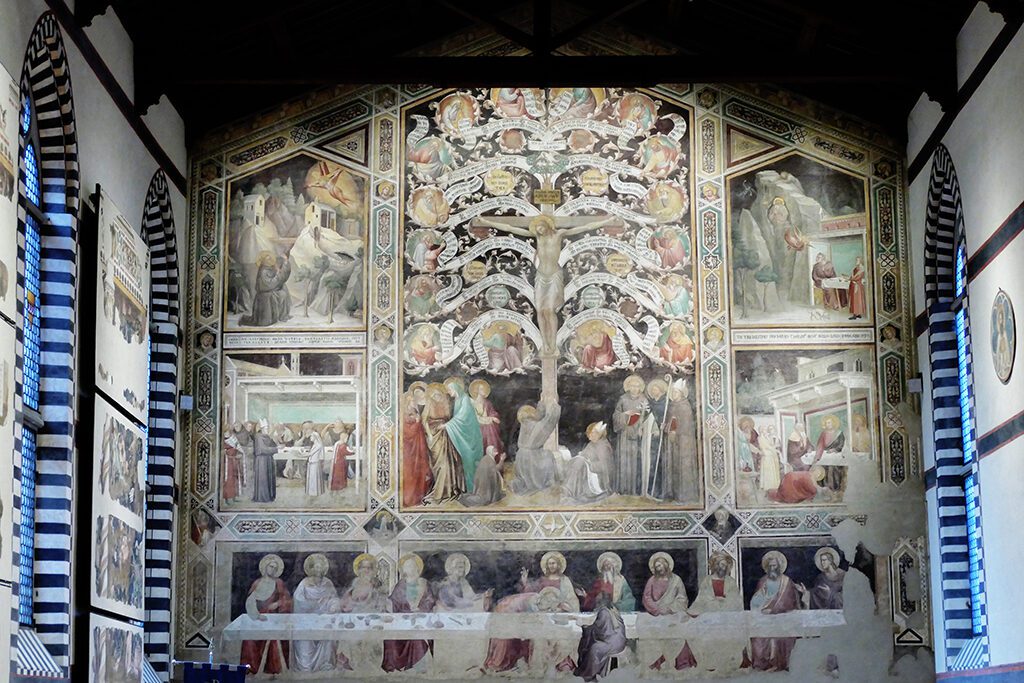
The symbolism of this Cenacolo, however, is definitely one of the most fascinating ones. As you look closely, you will actually distinguish six different scenes. There is an imposing Crucifixion, St. Benedict’s retreat, Jesus dining at the Pharisees, St. Francis receiving the stigmata, the history of St. Louis of Toulouse, and, obviously, the Last Supper.
Taddeo Gaddi committed thirty years to the decoration of this refectory.
I assume I don’t need to give you the address, but note that Santa Croce is open from Monday to Saturday from 9.30 a. m. to 5.30 p.m., on Sundays and public holidays, it opens only at 2 p. m. The regular entrance fee is 8 €uros.
Borgo dei Greci
As you continue from Santa Croce towards the city center, you might enjoy a stroll and a little souvenir shopping along the Borgo dei Greci. It’s a darling narrow street lined with shops selling leather goods, jewelry, and Italian delicacies.
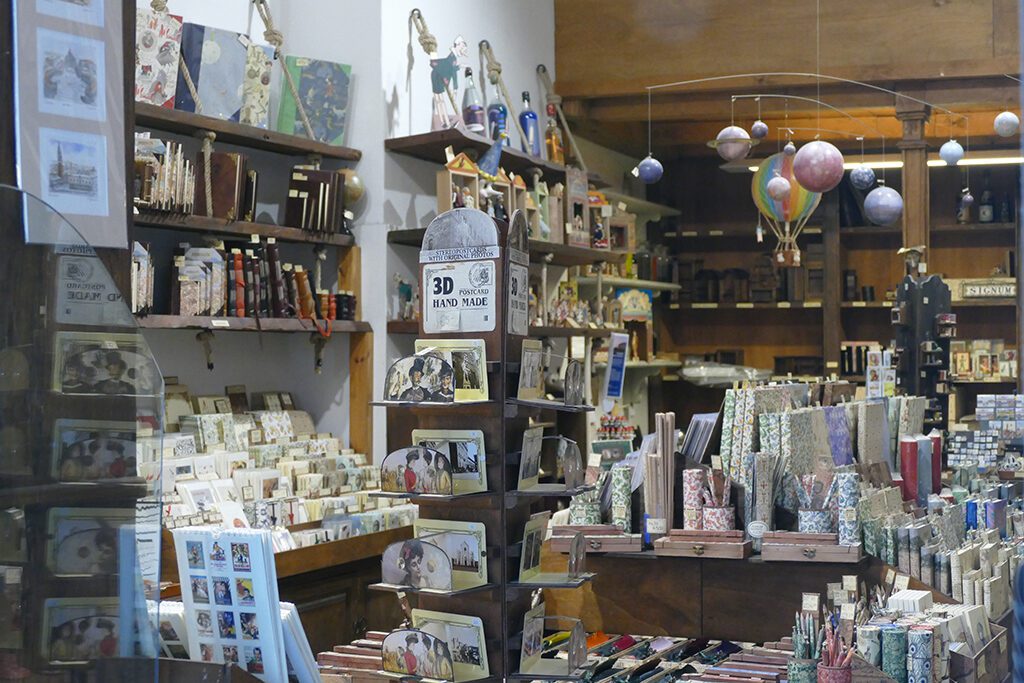
In medieval times, streets exiting the city gates were called Borghi. This particular Borgo refers to the old Greek families that already Dante quoted in his novels. As the families eventually moved to Bologna, the Peruzzi family purchased the houses. To this date, you can spot their coat of arms on the first two buildings coming from Piazza Santa Croce.
Bargello National Museum
To get to the Bargello Museum, you need to turn right from Borgo dei Greci into Via del Proconsolo and walk two blocks north.
The Palazzo del Bargello was built between 1255 and 1261. Later, it was expanded to a four-wing complex.
The structures subsequently served as seat of the Capitano del Popolo,
the chair of the Priori delle Arti, a courthouse, and the headquarters of the police chief.
From around 1700 until the end of the 18th century, executions were…well, executed at the Bargello courtyard.
Finally, in 1859, the Bargello was converted into a museum which allowed the city to exhibit the Renaissance sculptures that no longer fit in the Uffizi.
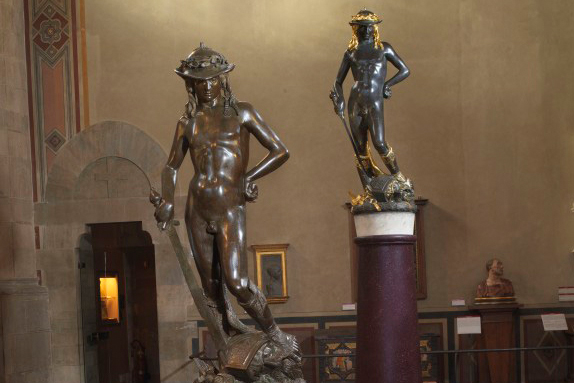
(Photo: Polisemico, Bargello David-originale-con-alle-spalle-la-replica-Marinelli-dorata, cropped 2:3, CC BY-SA 3.0)
Consequently, in the building and its courtyard is now one of the most important collections of sculptures. There are works by Michelangelo, Donatello, Giambologna…I impossibly can name them all.
The Bargello is open daily from 8.15 a. m. to 2 p. m. However, it remains closed on the 2nd and 4th Sundays of each month. The general entrance fee is 8 €uros. You can get comprehensive information on the five venues that form the Gruppo Musei Bargello on their website.
Museo Casa di Dante
The Museum of Dante’s house is in via Santa Margherita in one of the city’s oldest parts – only a stone-throw from the Bargello.
As a matter of fact, it is not evident that today’s museum is exactly the house where the poet lived. The original Alighieri house supposedly was a building that stood in Piazza San Martino with the rear facing Piazza de Donati. However, it doesn’t exist anymore.
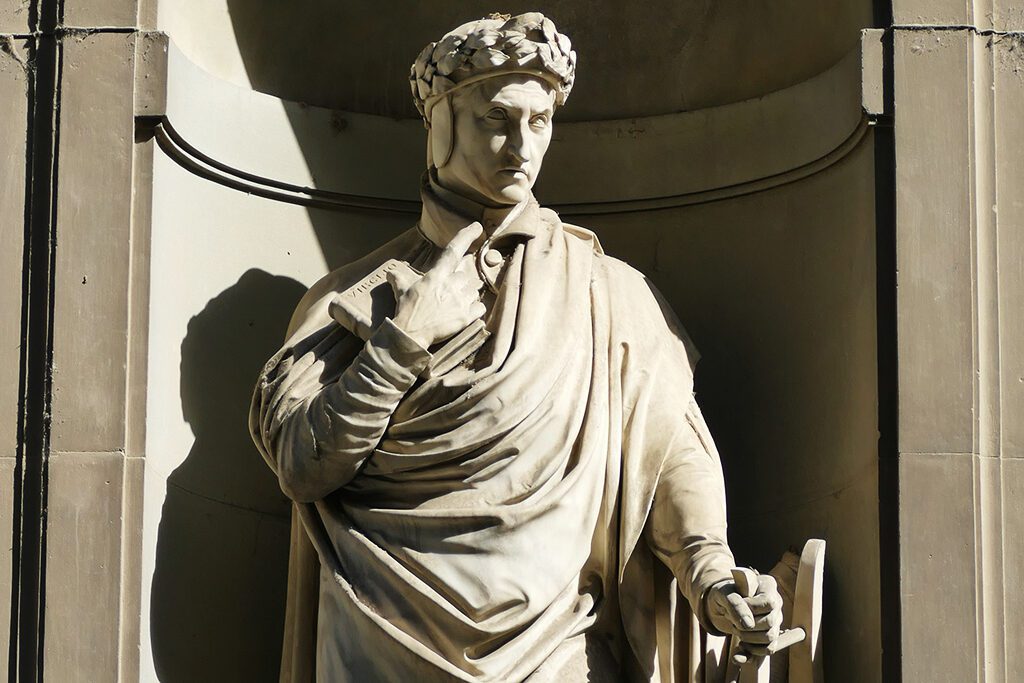
The museum focuses on Dante’s work. Numerous explanatory panels deal with the Divine Comedy, Dante’s time, and his characters. It preserves reproductions of documents, models, and dioramas. However, there is also furniture, clothing, and other objects from the daily life of medieval Florence.
From November to March, the museum is open from Tuesday to Friday from 10 a. m. to 5 p. m and weekends from 10 a. m. to 6 p. m. During the summer months, it is open daily from 10 a. m. to 6 p. m.
The general admission is 8 €uros.
Piazza della Repubblica
Not only the axis of this blogpost are crossing around the Piazza della Repubblica. The square is actually Florence’s center point. This is the spot where the Cardo – hence, today’s via Roma, via Calimala, and via Por Santa Maria – as well as the Decumanus – which would be Via del Corso, Via degli Speziali, and Via degli Strozzi – crossed.

In the 16th century, Cosimo I. settled the city’s Jewish population in this area. Today, all that remains of the medieval ambiance is the Colonna della Dovizia, marking the city’s central point.
From 1865, during the short period when Florence was Italy’s capital, planner Giuseppe Poggi redeveloped major parts of the city. By doing so, he copied Georges-Eugène Haussmann’s reshaping project of Paris. Sadly, he also sacrificed a number of significant historical buildings.
Chiesa di Santa Maria Maggiore
Three blocks north of the Piazza della Repubblica at the corner of Via dei Vecchietti and Via de Cerretani is the Roman Catholic church of Santa Maria Maggiore. It is part of a former monastery complex.
Legends about the church’s origin go back to the 6th century. In the 13th century, an order of the Cistercians acquired the building. Since it stood next to the city wall, after the city fortifications were expanded, the church was converted into a three-aisled basilica.
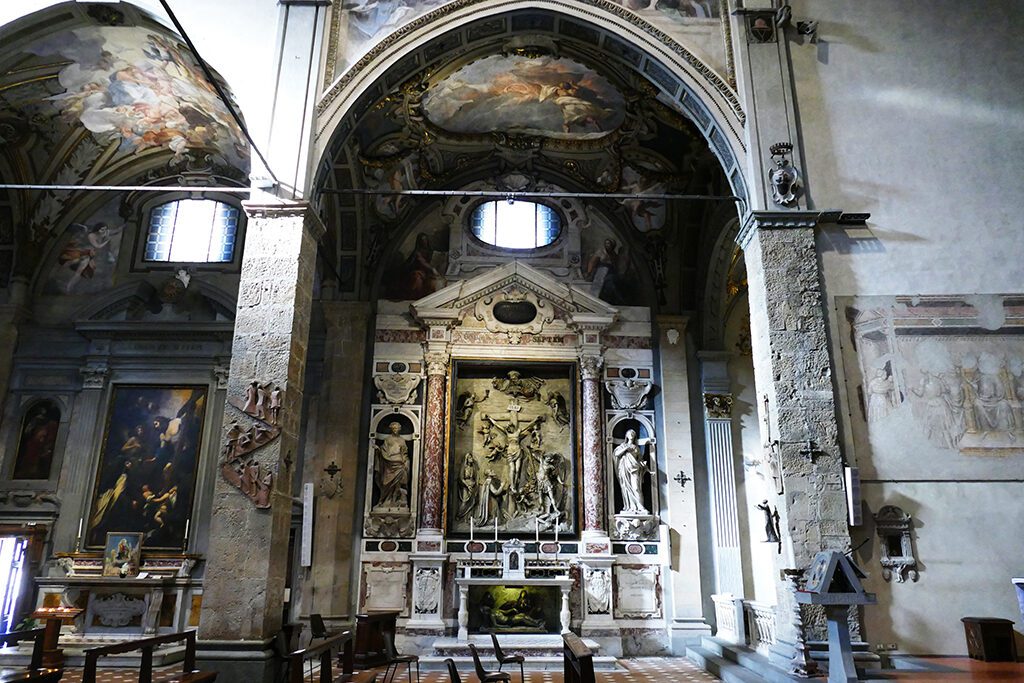
In 1521, Carmelites of the Mantuan Congregation took over and converted the canons into a monastery. Today, however, it is used for other purposes.
The ornamental architectural details on the inside walls are by Bernardo Buontalenti – nomen est omen seems to be true. In 1880, the remains of a cycle of frescoes from the 14th century were found. They are attributed to Spinello Aretino.
Biblioteca Medicea Laurenziana – Basilica di San Lorenzo
A five-minute walk north of the church is the landmarks that illustrate most prominently the Medici’s power and impact. In a massive square is a group of imposing buildings underlining why Lorenzo da Medici went by the nickname of Il Magnifico, the magnificent.
Biblioteca Medicea Laurenziana
Although it was Cosimo Il Vecchio who founded this world-famous library, his grandson Lorenzo expanded it considerably.
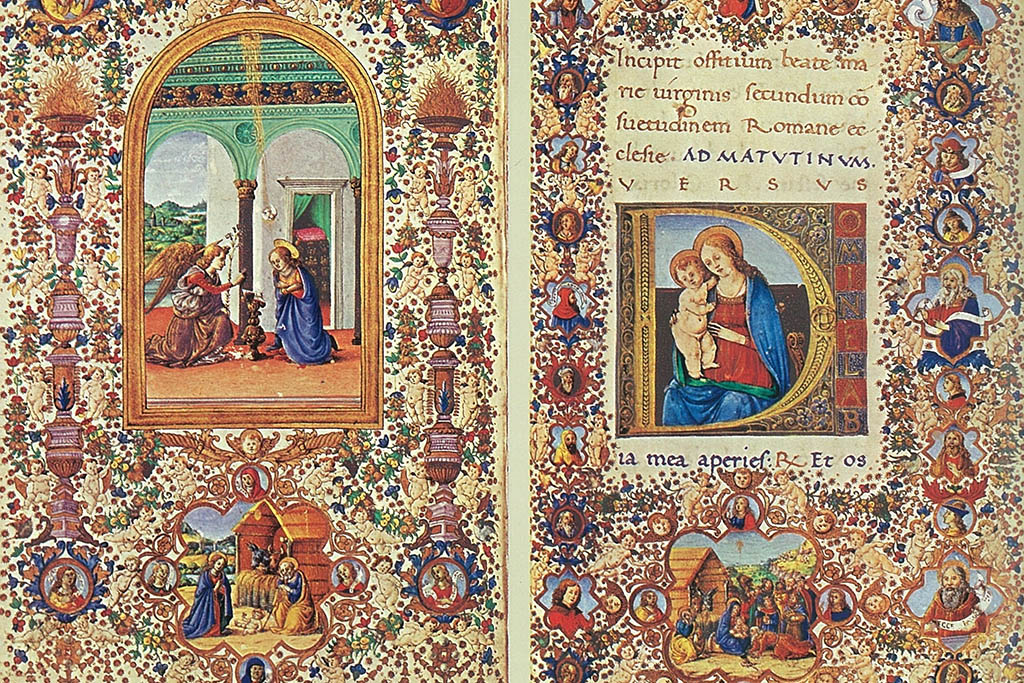
On the left page is the Annunciation and below the birth of Christ. To the right Virgin and Child and below the Adoration of the Magi.
Today, it has a stock of around 150,000 books, including incunabula from the 15th and prints from the 16th century. In addition, there are around 11,000 manuscripts and around 2,500 papyri.
The Book of Hours that Lorenzo commissioned in 1485, is one of the collection’s greatest treasures.
The library is open to the public. The entrance is on the left side in the church of San Lorenzo or through the cloisters. No less than Michelangelo designed a monumental staircase as well as the spacious reading room. Visiting times are weekdays from 8 a. m. till 2 p. m., Tuesdays and Thursdays till 5.30 p. m. and the entrance fee is 3 €uros.
Basilica di San Lorenzo
The Basilica di San Lorenzo is one of the largest churches in Florence. Consecrated in 393, it is one of the many churches claiming to be the oldest one. It was the Medici’s parish church.
In 1419, Cosimo Il Vecchio’s father Giovanni di Bicci de Medici commissioned Filippo Brunelleschi with the design of a new church. This was to be the first church building of the Renaissance and consequently the first church building in modern art history. At Brunelleschi’s death in 1446, only the sacristy and the transept were finished. His student Antonio Manettihe then continued the construction.
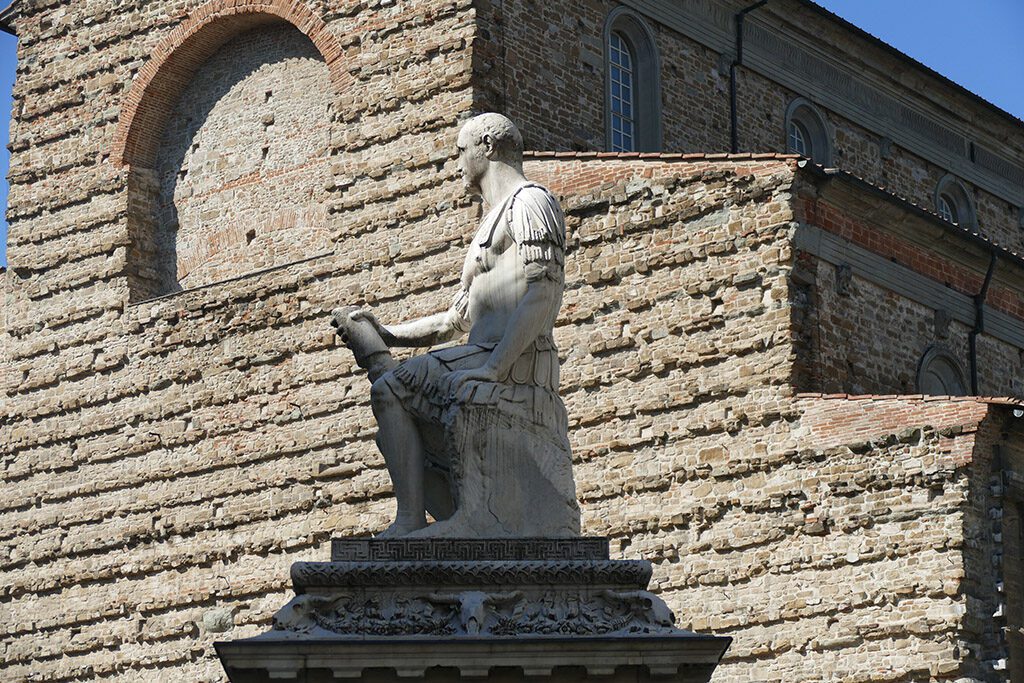
Although no less than Michelangelo made a design and the Medici raised large amounts of money, to this date, the structures remain without a façade.
The Basilica’s domed Sagrestia Vecchia, the old sacristy, remains one of the masterpieces of Filippo Brunelleschi. As a matter of fact, it’s the only part that was completed during the master’s lifetime in 1428. The sculptural decoration work i. a. by Donatello went on until 1443. At the sacristy are the tombs of a number of Medici family members such as Giovanni di Bicci de Medici and Piero de Medici, Lorenzo’s father.
Basilica of Santa Maria Novella
Besides the legendary Duomo, it’s this house of worship that I remember best from my also a bit legendary first road trip through Europe at the tender age of 17. And yes, I still get why it impressed me so much – even though I was just a stupid teenager.
The basilica’s construction began in the middle of the 13th century and lasted until the middle of the 14th century.
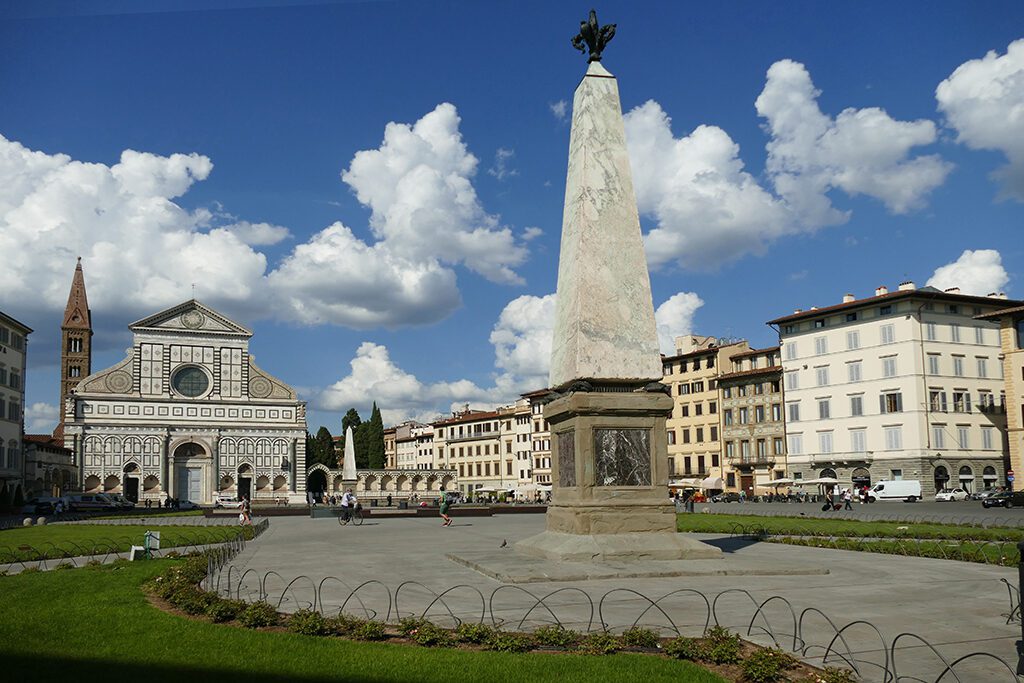
The original design came from two Dominicans, Fra Sisto da Firenze and Fra Ristoro da Campi. The Rucellai family commissioned Leon Battista Alberti to design the church’s dark green and white marble façade.
The artist used the strict geometric shapes that are typical for the Renaissance. Rectangles, squares, circles, and round arches define the design.
On the Inside
On the inside, you can see that it is actually a Gothic building.
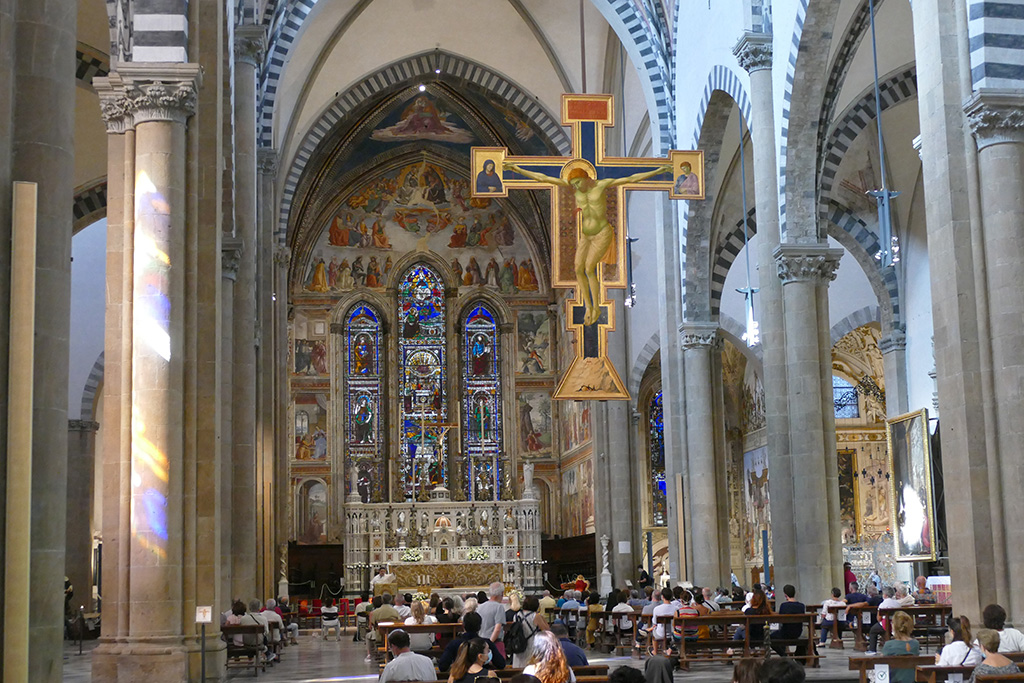
Giovanni Tornabuoni commissioned Domenico Ghirlandaio and his workshop to create the frescoes in this main chapel. This work covers an area of 400 square meters. It depicts scenes from the life of the Virgin Mary and John the Baptist.
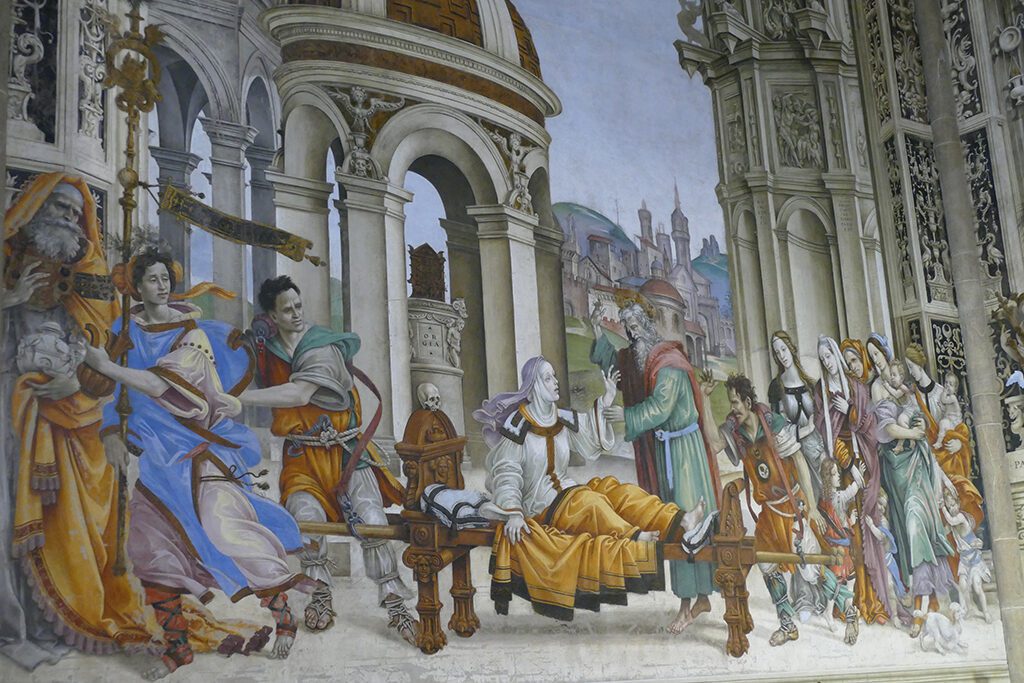
Apart from the Tornabuoni Chapel, there are also the
- Filippo Strozzi Chapel
- Gondi Chapel
- Cappella Strozzi di Mantova
- Della Pura Chapel
- Rucellai Chapel
- Bardi Chapel
as well as the Scristy, all lavishly decorated by frescoes, paintings, and sculptures of Florence’s most famous artists such as Sandro Botticelli, Bronzino, Domenico Ghirlandaio, and Masaccio.
When remodeling Santa Maria Novella, Giorgio Vasari was keen to adapt the church’s appearance in a then coherent fashion. Thus, he decorated the wall with large Renaissance paintings.
However, he was unable to erase the artistic past forever. From 2004 onwards, frescoes dated from the end of the 13th century to the beginning of the 16th century were discovered and laid bare.
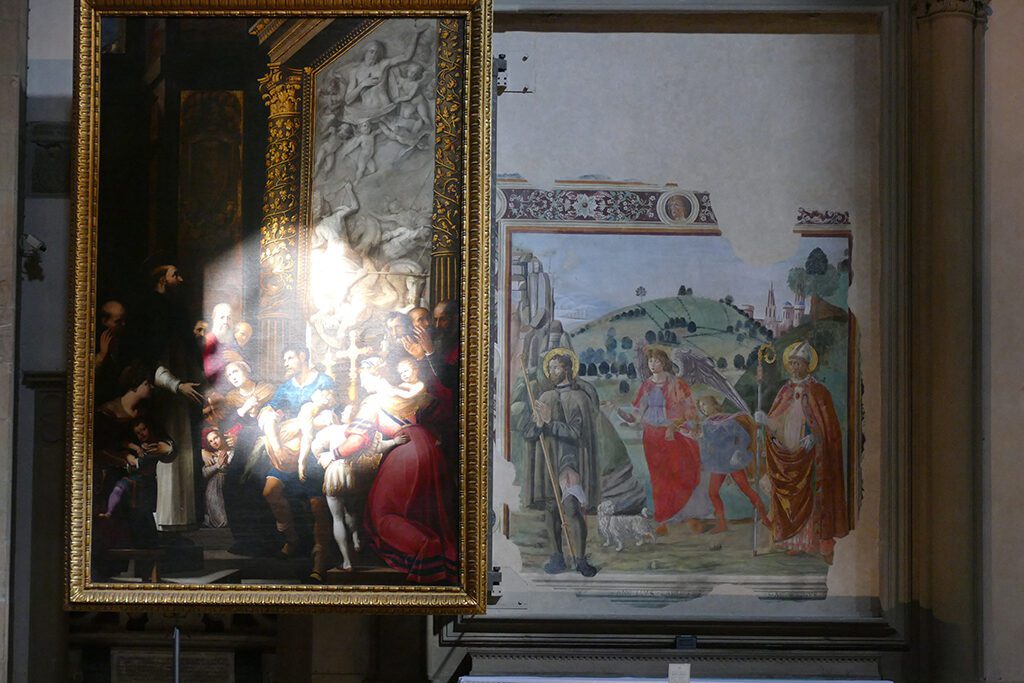
Today, they can be made visible thanks to a mechanical system that allows to move the blades that cover them like shutters. The huge paintings are displayed on hinges so that you can see the frescoes behind them.
The Spanish Chapel
As a matter of fact, Santa Maria Novella is not only a church, but also a monastery complex. It has two cloisters and various other monastery buildings.

One of the most beautiful rooms in the complex is the chapter house. It goes by the name of Spanish Chapel and lies between the church and the outer cloister. It was built in the middle of the 14th century.
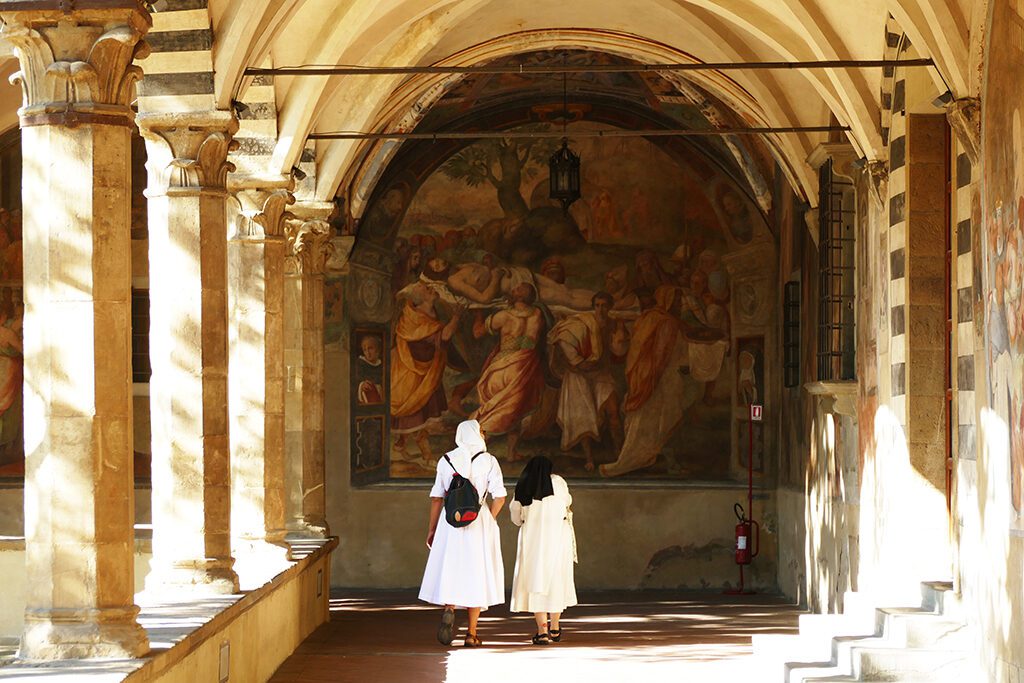
Cosimo I.’s wife Eleonora of Toledo rededicated the chapel in the 16th century as she wanted a prayer room for her entourage from Spain.
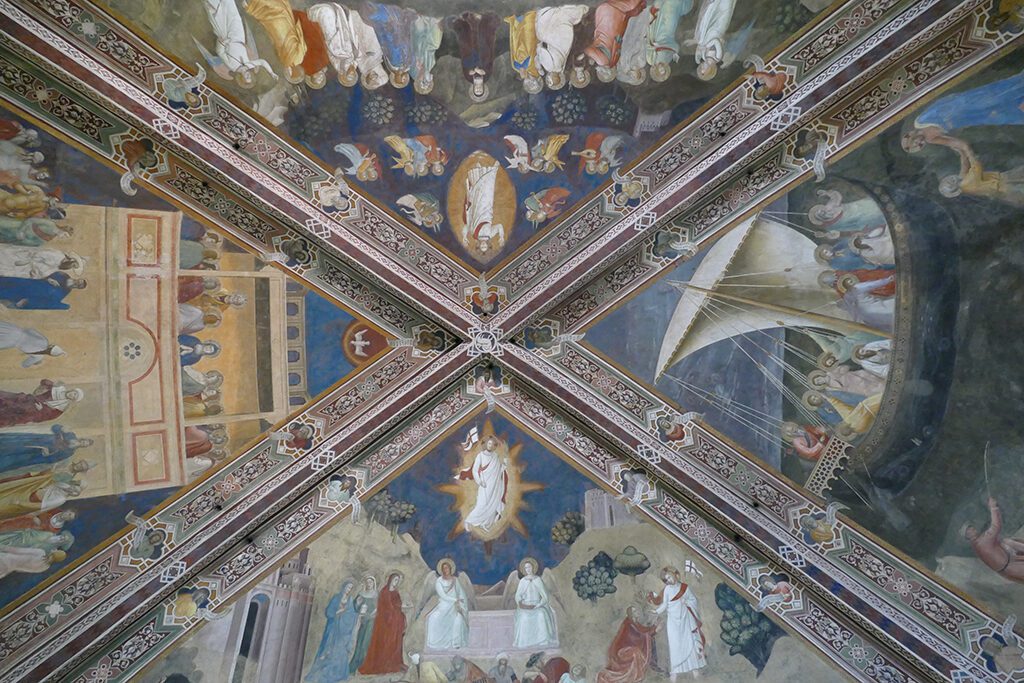
The amazing frescoes in the large room are by the otherwise little-known painter Andrea di Bonaiuto from around 1365 are depicting the allegory of Christian faith and honor Thomas Aquinas. They glorify the Dominicans’ struggle against heresy.

As a matter of fact, it’s totally worth sparing a little more time for this amazing chapel. Not only is the artwork truly beautiful. It’s also great fun identifying various persons and personas of that time. Some really good explanation panels make that easy. You know, it’s actually like some kind of highly sophisticated Find Waldo.
How to Visit
The complex of Santa Maria Novella can be visited from Thursday to Monday for a general entrance fee of 7 €uros. Since opening times differ from season to season, please check their website before planning your visit.
Along the North Bank of River Arno
Other than Venice, Florence has just one river, nevertheless, from here, you have some of the most amazing views. Each bank and every bridge grants you a different breathtaking view of Tuscany’s capital city.
If you don’t start your day too late, you might be able to see the most important landmarks of both banks of the river. But in that case, grab your bag and let’s go.
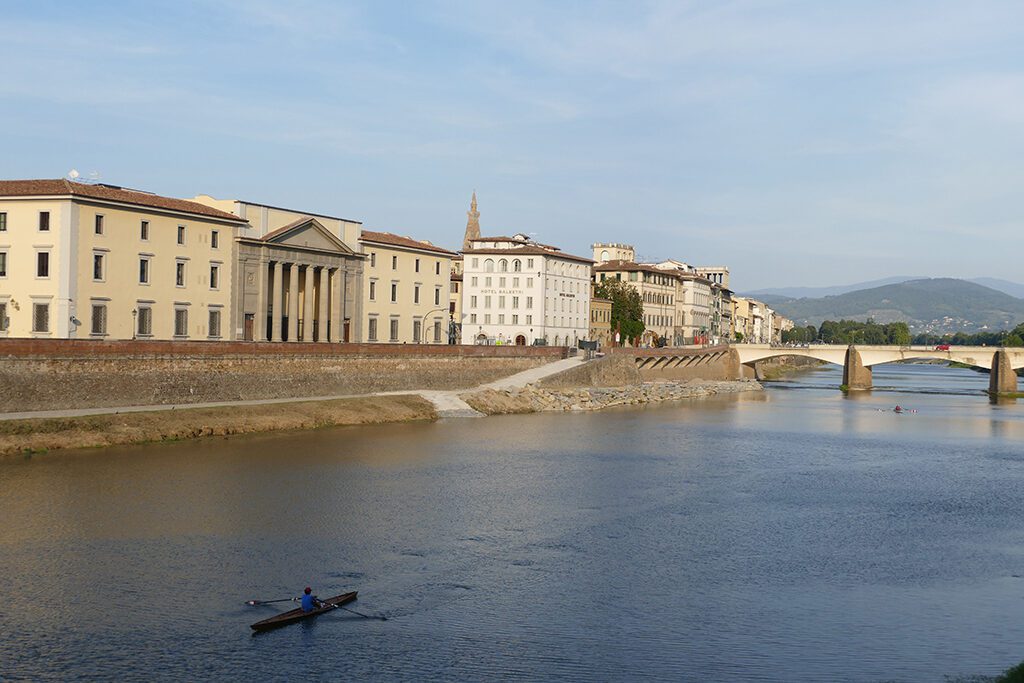
Museo Galileo
Our walk along the northern bank of the river Arno begins at the Museo Galileo. It’s just behind the Uffizi at the Piazza dei Giudici. Obviously, it is dedicated to the history of science.
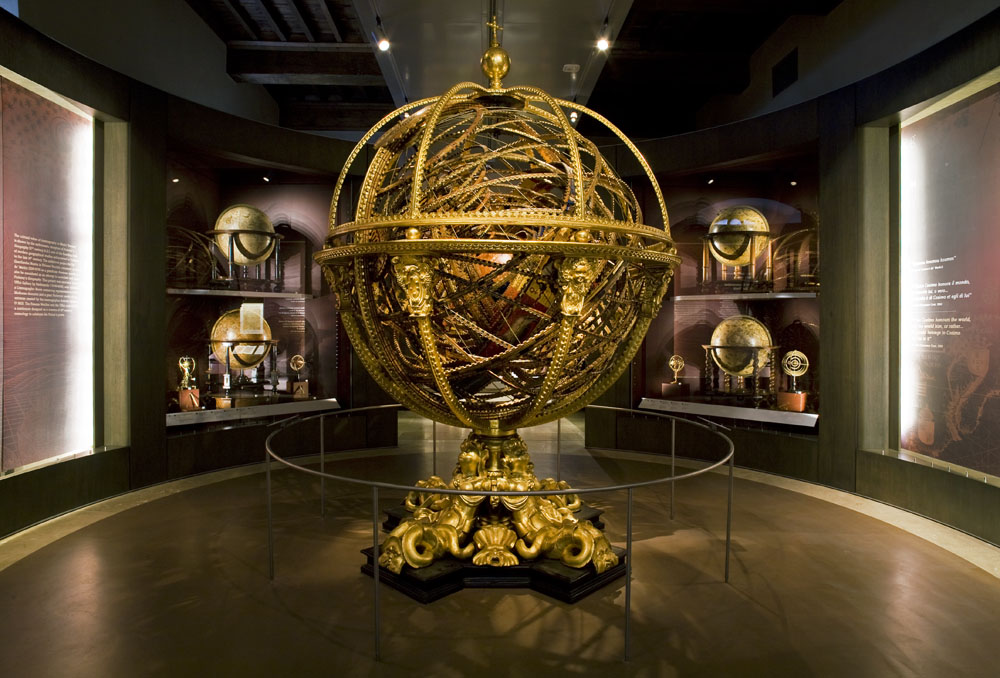
(Photo: Museo Galileo, Sfera Armillare Santucci, CC BY-SA 3.0)
Since its founding in 1927, the institute has collected, cataloged, and restored ancient tools and instruments of historical and scientific importance.
The collection goes actually back to the Medici who had a vast interest in natural, physical, and mathematical sciences. Besides their collection, the museum exhibits also Galileo’s original instruments.
The museum can be visited daily from 9.30 a. m. to 6 p. m., albeit Tuesdays only till 1 p. m. The general admission is € 10,00
Mercato del Porcellino
Phew, is your head spinning from all this scientific stuff? I don’t blame you. So let’s just stroll alongside the river, passing the Uffizi to the right. At the Ponte Vecchio, turn right into Via Por Santa Maria and walk three blocks till you get to the covered Mercato del Porcellino.
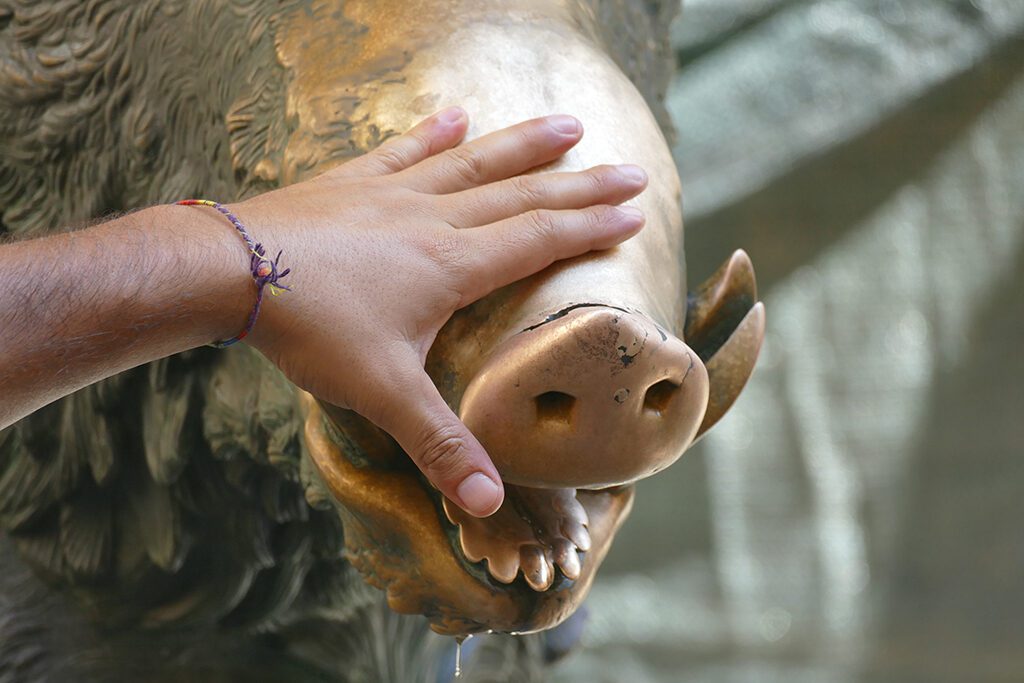
Actually, Porcellino is just the nickname name of the Loggia del Mercato Nuovo. It’s nuovo only in comparison to the old market that used to be at the Piazza della Repubblica. As a matter of fact, it was built between 1547 and 1551. Initially, it was foreseen for the sale of silks and precious objects. Today’s market tender, however, are mainly selling leather goods and souvenirs. It is rather touristy, nevertheless, I made some pretty good deals here. You’ll depend on your eye for quality and your capability to haggle.
Oddities
The loggia’s non-commercial attraction is, however, the Porcellino fountain from 1640. This boar is a replica of Pietro Tacca’s bronze, inspired by a Roman marble sculpture, now standing at the Uffizi.
In the past, this fountain had a rather practical function because it supplied the merchants with water. Superstition has it that shining the boar’s nose brings good luck. However, it’s not that simple. After the rubbing, you have to put a coin in its mouth. Only if the coin falls past the grate where the water drops, it will bring you luck.
There’s also another curiosity in the center of the loggia, the so-called stone of scandal. Today, there is a replica of the stone where during the Renaissance, insolvent debtors were punished. After being chained, his but was stripped naked before he was soundly spanked. Eventually, he had to drop bare-bottomed onto the stone three times while loudly promising to give his belongings to pay his debts. While he was sitting bare-bottomed on the stone, his possessions were divided among his creditors.
Museo di Palazzo Davanzati
Just two blocks west of the Marcato is the Palazzo Davanzati, one of two palazzi that also belong to the Gruppo Musei Bargello. This one is from the 14th century and stands on Via di Porta Rossa 13.
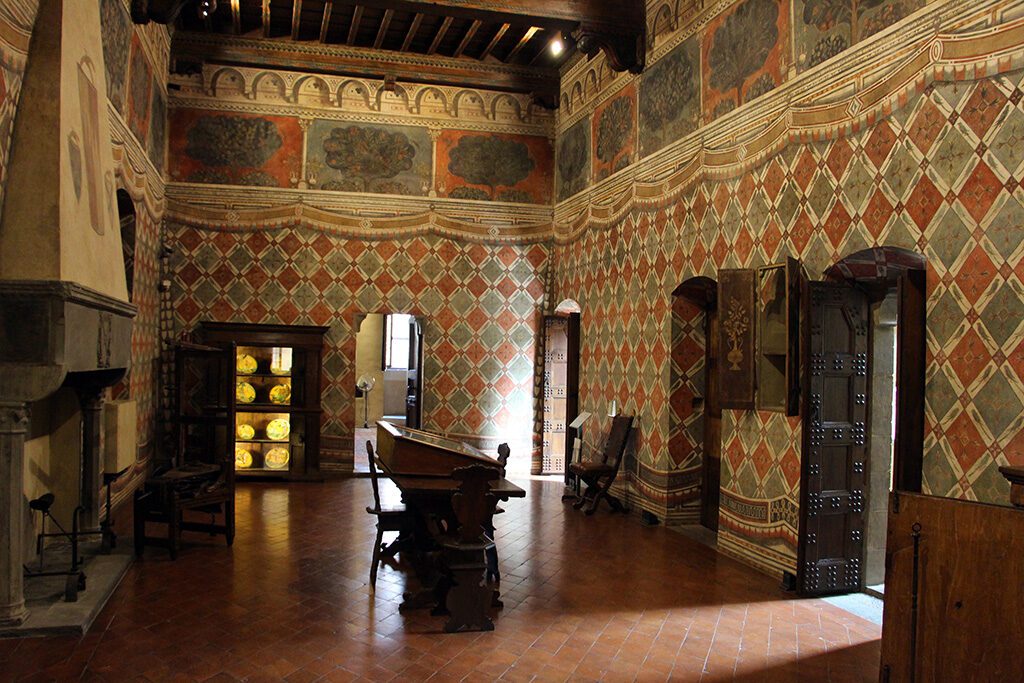
(Photo: Sailko, Sala dei pappagalli, veduta 03, CC BY-SA 3.0)
Commissioned by the wealthy Davizzi family, it was sold in 1578 to the Davanzati. Subsequently, it changed its owner a couple of times until in 1951 the Italian state took it over as a museum.
The Palazzo Davanzati preserved much of its original style and is a fine example of the former owners’ wealth and taste. There is a rich collection of paintings and sculptures, furniture, ceramics and fabrics, as well as historic objects of everyday life. Works from the repositories of various Florentine museums as well as further acquisitions and donations were added.
The Palazzo is open from Monday to Friday between 8.15 a. m. and 2 p. m. and weekends from 1.15 p. m. to 7 p. m. The general entrance fee is 6 €uros.
However the museum is closed on every month’s second and fourth Sunday as well as the first, third and fifth Monday.
Palazzo Martelli
Just so you know, the other palazzo that’s also part of the Gruppe Musei Bargello is the Palazzo Martelli. It is one block north from the Chiesa di Santa Maria Maggiore. Therefore, if you intend to visit, you should rather include it in the route of the East-West-Axis.
Note that the Martelli is open to the public only on hourly guided tours on Thursday between 2 p. m. and 7 p.m. as well as weekends from 9 a. m. till 4 p. m. Larger groups should make a reservation by calling +39 – 55 29 03 83. In this case, they charge a fee of 3 €uros.
Basilica di Santa Trinita
Coming from the Palazzo Davanzati, Santa Trinita is right at the next corner. The Basilica di Santa Trinita stems from the 11th century. In the 14th century, the originally Romanesque building was rebuilt and expanded in the Gothic style.

The side chapels were added and subsequently furnished with important works of art. Santa Trinita made it to the Unesco World Heritage List in 1982.
Museo Marino Marini
It’s a short three-minute-walk from the Basilica di Santa Trinita to the Marino Marini Museum. Here, Florence actually killed two birds with one stone – which, by the way, is a quite disturbing expression.
Anyway, the Florentine administration was looking for a venue to exhibit the vast work that Marini had donated to the city in 1980. At the same time, they were about to restore the deteriorating church of San Pancrazio into a place for cultural projects. Badda boom badda bing – here you have a truly unique and very cool art space.
Marino Marini was one of the most prominent Italian artists of the twentieth century, especially as a sculptor. He was born in Pistoia where you’ll find the largest part of his work. The second-largest collection is right here between the ancient walls of San Pancrazio.
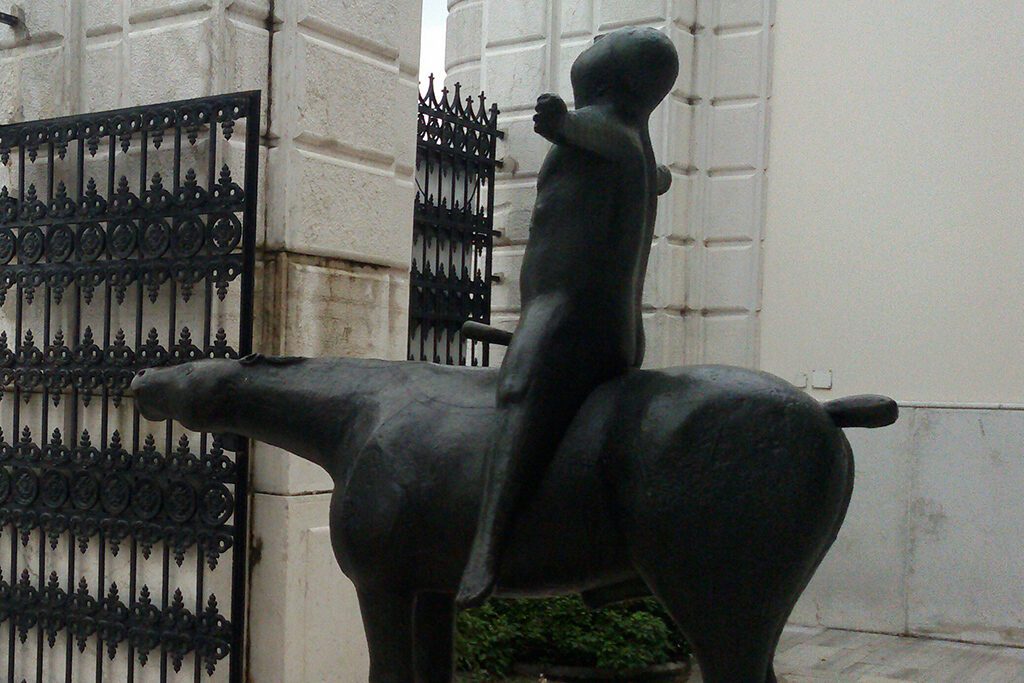
I must say that the architects Lorenzo Papi and Bruno Sacchi did an amazing job as they created a dialogue between the historical structures and the contemporary art.
Even if you’re not a culture vulture like me, I’m sure you’ll enjoy a visit to this unique gallery.
The Museo Marino Marini is open from Saturday to Monday from 10 a. m. to 7 p. m. Entrance to the permanent collection is free, but you have to buy a ticket for 6 €uros if you want to visit the temporary exhibitions and the Cappella Rucellai.
Chiesa di San Salvatore in Ognissanti
Just five minutes from the Museo Marino Marini is the Franciscan church San Salvatore di Ognissanti at Piazza Ognissanti.
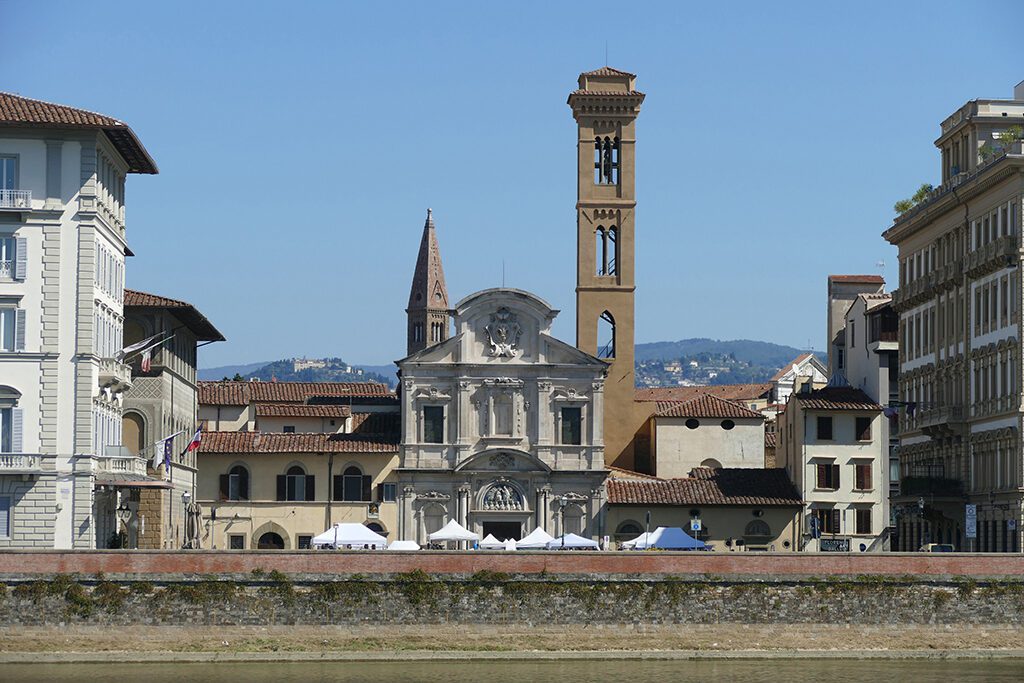
The church was part of a monastery that was founded in 1251. Initially open to men and women, this lay order was committed to modesty and manual labor. Encouraged by Cosimo I., Franciscans took over the church and monastery in the 16th century. They transferred important relics from their previous seat on Monte alle Croci to their new monastery.
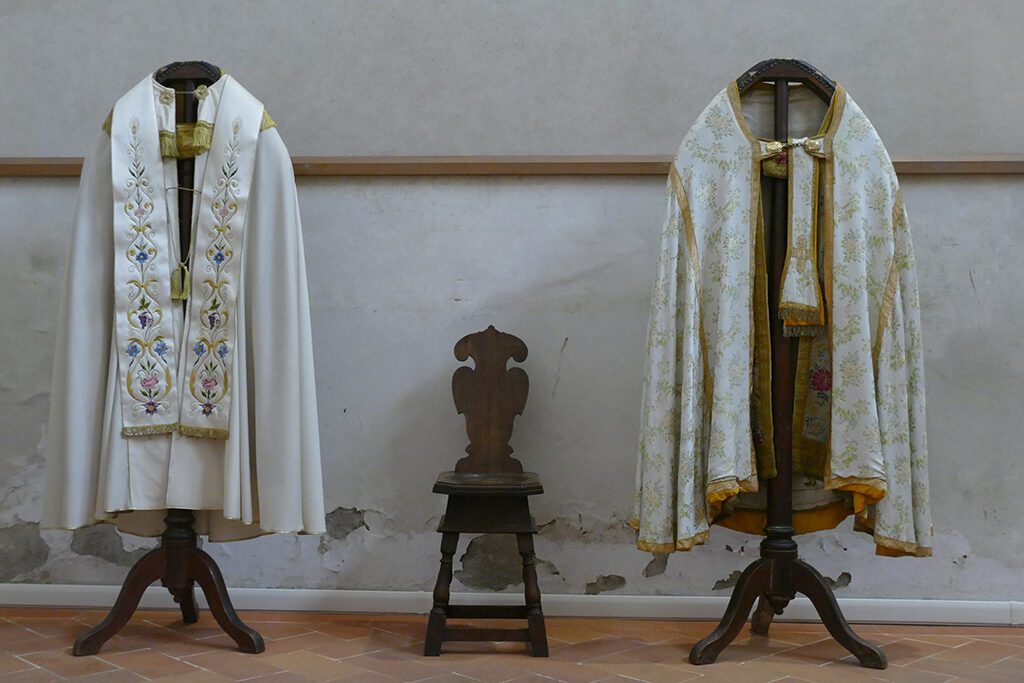
After the first closure in 1810, the monastery was finally closed in 1866. Today, the cloisters, the chapter house, and the refectory are a museum. However, there is also a small Franciscan community living there again.
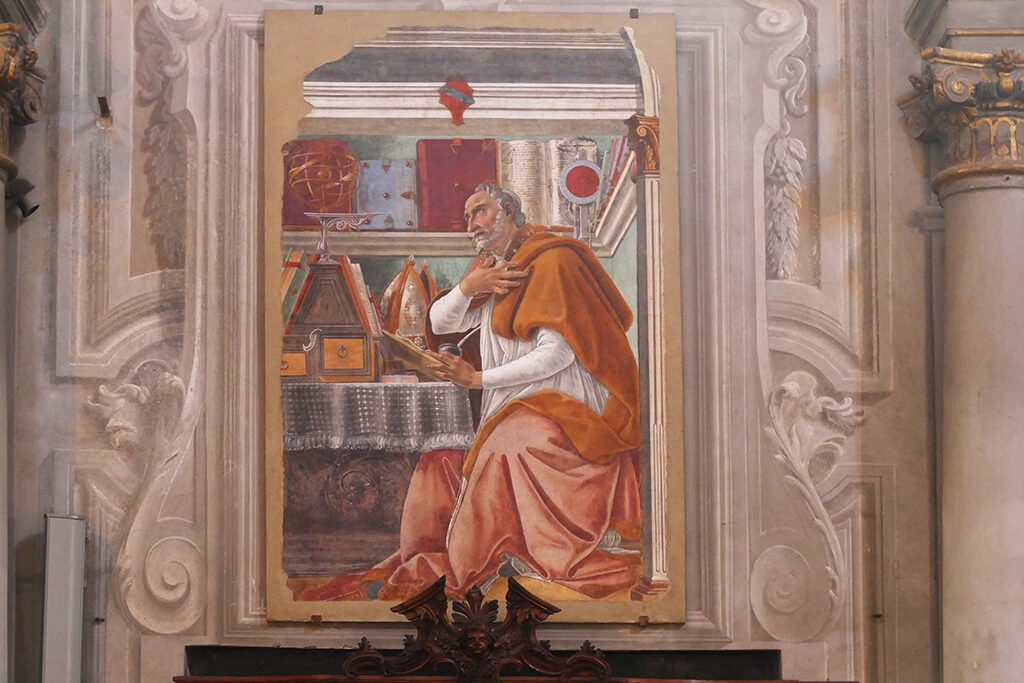
In addition to some famous paintings in the church, there is a Cenacolo by Ghirlandaio on the back wall of the refectory between the two cloisters. Ghirlandaio’s work from 1480 amazingly abolishes the boundaries between real and pictorial space. The vaults of the refectory are continued in the fresco, and the middle console applies equally to the real and the painted architecture.
Due to the recognition of this masterpiece, Ghirlandaio was commissioned two years later to paint the refectory of San Marco.
Along the South Bank of River Arno
Some of Florences not to be missed landmarks are located on the Arno’s southern bank, the so-called Oltrarno. There is the Palazzo Pitti, there are large gardens, and many interesting churches. Also, I recommend to try local delicacies at the eateries on this side of the river – where you’ll rub shoulders with the locals rather than with your fellow travellers.
San Miniato al Monte
If you’re a trooper, you can walk all the way up to the Basilica of San Miniato al Monte. Mind you, it stands on one of the city’s highest points. Therefore, those who want to save their energy for the landmarks to come can take bus #12 all the way up to the Basilica.
San Miniato al Monte is the name of a church as well as an Olivetan Abbey. It is a fine example of Romanesque architecture in Tuscany and one of the most beautiful churches in Italy. The façade is a characteristic work of the incrustation style of the Florentine Proto-Renaissance.
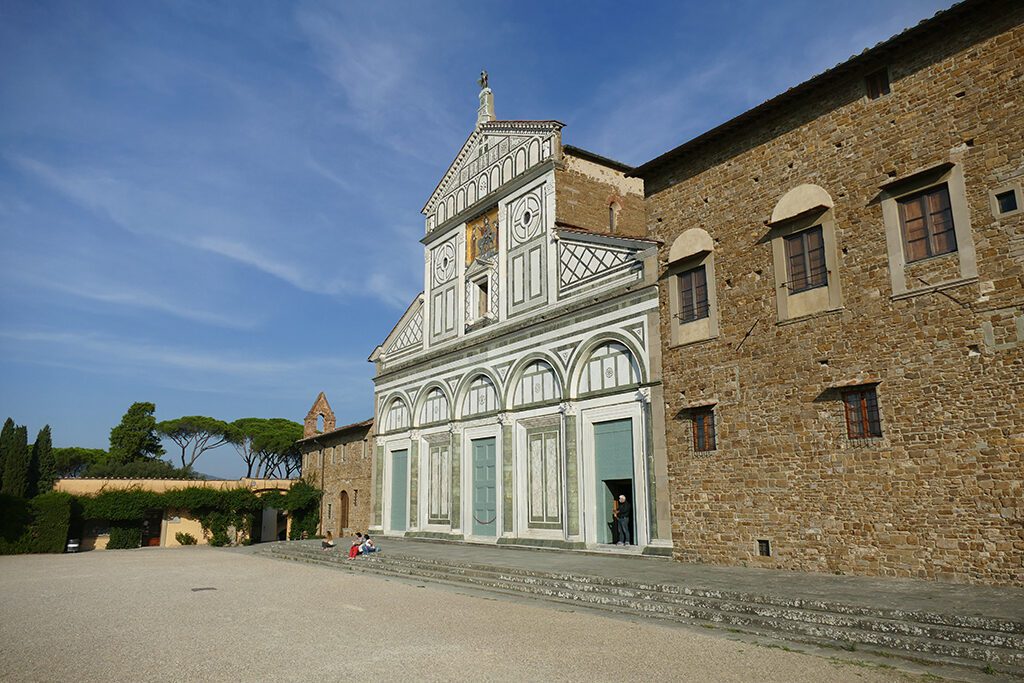
Saint Minias was an Armenian prince who left his homeland for a pilgrimage to Rome. He arrived in Florence around 250 and lived there as a hermit. A shrine was later built on the hill where he died.
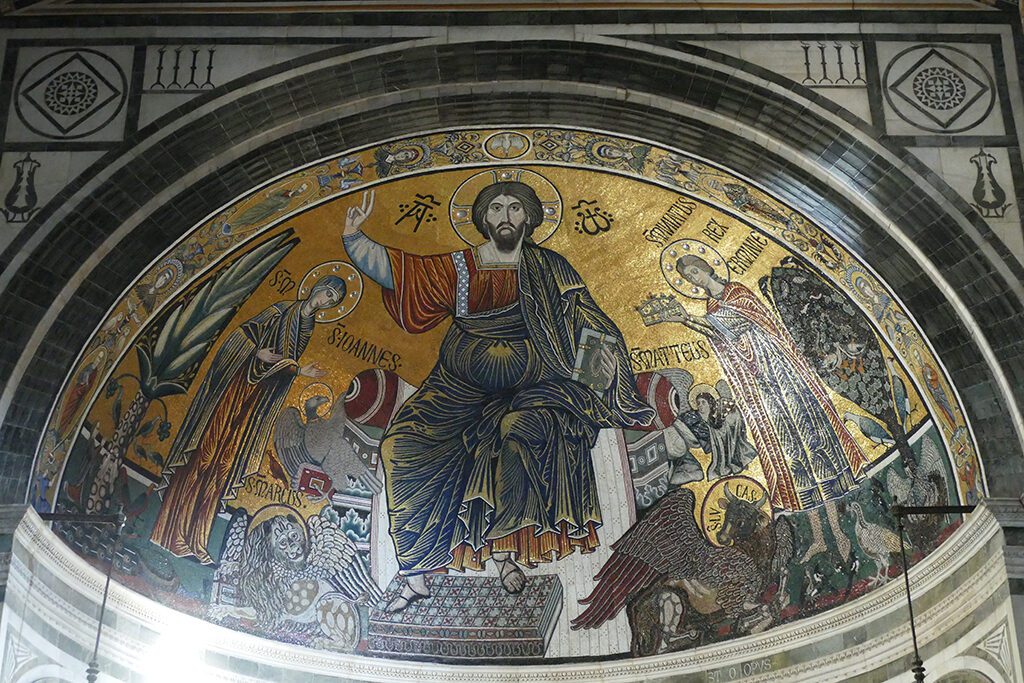
The construction of the current church was started in 1013 by Bishop Alibrando. At first, the church was a Benedictine monastery, then it was Cluniac, and in 1373, Olivetan monks took over. These monks make alcoholic beverages, honey, and herbal teas that they sell in a shop near the church.
The interior of San Miniato al Monte is quite unusual. The floor is paved and there is some unique terracotta decoration. Also, the choir is on a raised platform above a large crypt. The free-standing Cappella del Crocefisso, the Chapel of the Crucifix, by Michelozzo dominates the center of the nave.
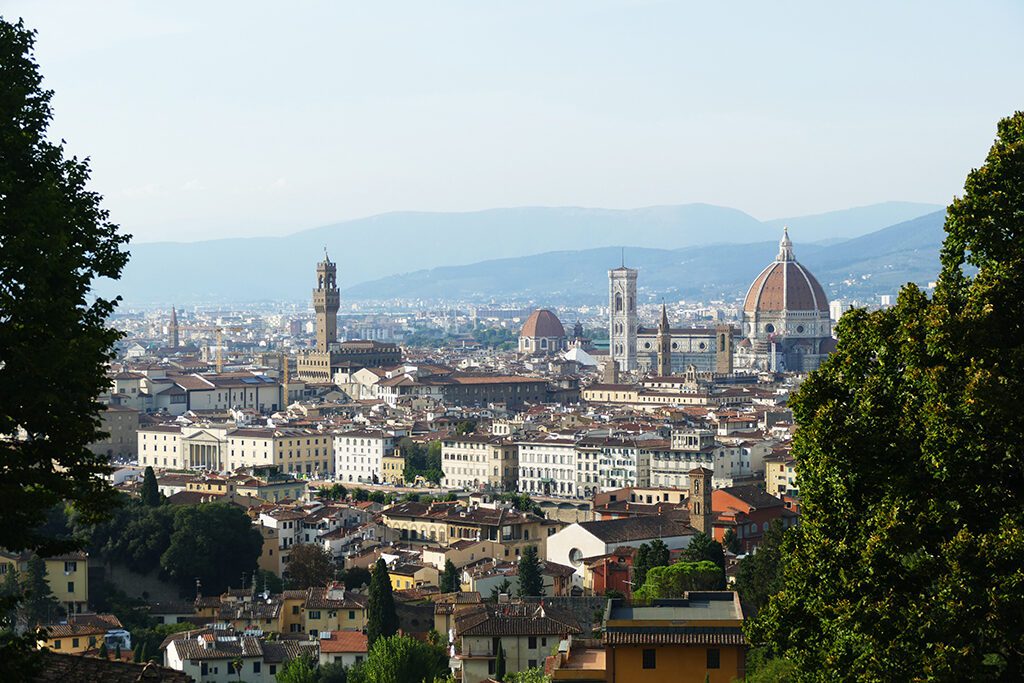
However, it’s mainly its secluded location that gives the complex some magical serenity. Also, you’ll have the most beautiful view of the city of Florence from this elevated stop.
Piazzale Michelangelo
While climbing uphill to San Miniato can be challenging – especially during the summer months, I recommend you walk back downtown. This way, you can add a photostop at the Belvedere Vittorio Sermonti as well as at the Piazzale Michelangelo.

During the short period when Florence was Italy’s capital, ambitious reconstruction projects were realized. They built the quays along the Arno and also the Viale dei Colli. This eight-kilometer-long panoramic road meanders up the hill of San Miniato. The center and highlight of this drive is Piazzale Michelangelo. It was created according to the plans of Giuseppe Poggi in 1865. The architect and city planner also designed the pavilion on the square’s backside. Initially, it was designed as a museum for Michelangelo’s work. Eventually, it was remodeled into a panorama restaurant.
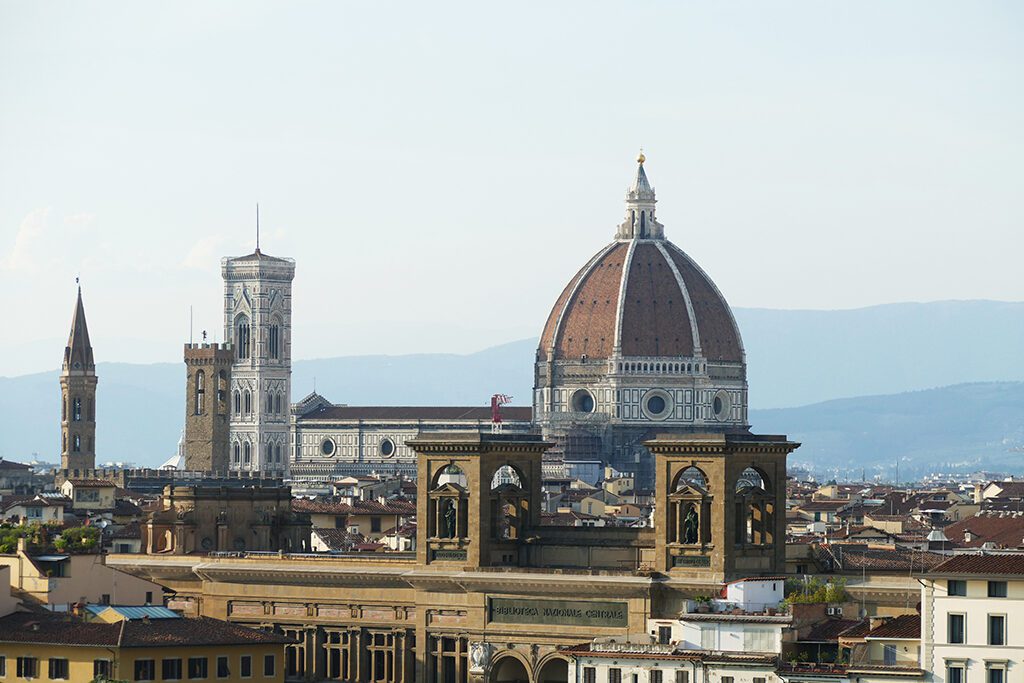
From the Piazzale, you can see the entire center of Florence all the way to the hills on the northern edge of the city. Unfortunately, this is the reason why especially during high season, the square is a central point of tourist and bus tours.
Botanic Gardens
West of the Piazzale is the Giardino delle Rose, a botanic garden with beautiful rose terraces while east of the square is the Giardino dell’Iris.
At the Giardino delle Rose, you’ll stroll between a collection of roses, lemons, and other flora. Also, there is a Japanese garden, donated to Florence by its Japanese sister city Kyoto.
The rose garden is open from October to February from 9 a. m. to 4.30/5 p.m., in March till 6 p.m., in April, May, and September till 7 p. m., and from June to August till 8 p. m.
The iris garden opens to the public only from April 25 to May 20 or upon appointment daily from 10 a. m. to 7.30 p. m. However, on weekdays there’s a lunch break from 1 p. m. to 3 p. m.
Porta San Niccolò
As you continue down the Viale dei Colli, you’ll get to the Porta San Niccolò. It was part of the city walls and located in Piazza Giuseppe Poggi. However, due to its isolated appearance, it looks more like a tower.
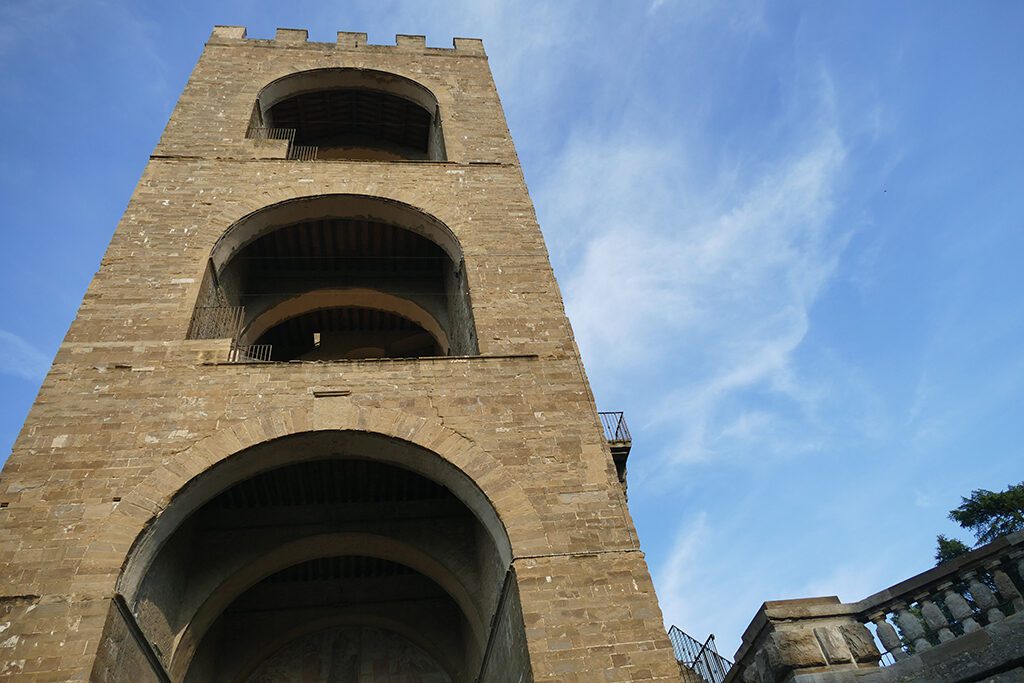
It was built in 1324 and is attributed to Orcagna. During Poggi’s risanamento, the remodeling of the city, most of the city walls were demolished. Consequently, today, San Niccolò is the only tower gate that still has its original height. Therefore, you have to climb 160 steps to get to the top and enjoy – yet again – a grand panoramic view of Florence.
The gate can be climed from June 24 to September 30. Join a guided tour gor 6 €uros between 5 p. m. and 7.30 p.m. – in September from 4 p. m. to 8.30 p. m.
Museo e Giardino Stefano Bardini
To get to the Museo Stefano Bardini, you can just stroll for five minutes westwards along the river. Just make sure not to get lost in the beauty of the Terzo Giardino, an alluring riverfront garden with a sandy beach a cocktail bar from where you can enjoy the sunset.
In all honesty, if you have paid the Bargellos a visit and are now on your way to the Palazzo Pitti, you might skip the Bardini – unless you are an insatiable culture vulture.
Stefano Bardini was a painter, but mainly an art dealer, collector, and patron. In 1870, Bardini started an extremely successful art dealer career.
The city of Florence inherited his city palace, his art collection, and his park. Since 2008, the palace also houses the Museo Pietro Annigoni as well as temporary exhibitions.
Still, a rather hidden gem is the Bardini garden. It can be visited in about an hour – preferably in the early morning or during the twilight.
There are two entrances to the garden. One is located at Via dei Bardi close to the Museum. The other one is at Costa San Giorgio next to the Forte di Belvedere and the exit from the Boboli Gardens.
The Entrance Ticket is valid for one day and is included in the ticket to the Boboli Garden – see below.
Palazzo Pitti
You’re already in the neighborhood, however, to get to the main entrance of the Palazzo Pitti, you need to walk in a wide arc around the premises from the Costa San Giorgio to the Piazza dei Pitti.
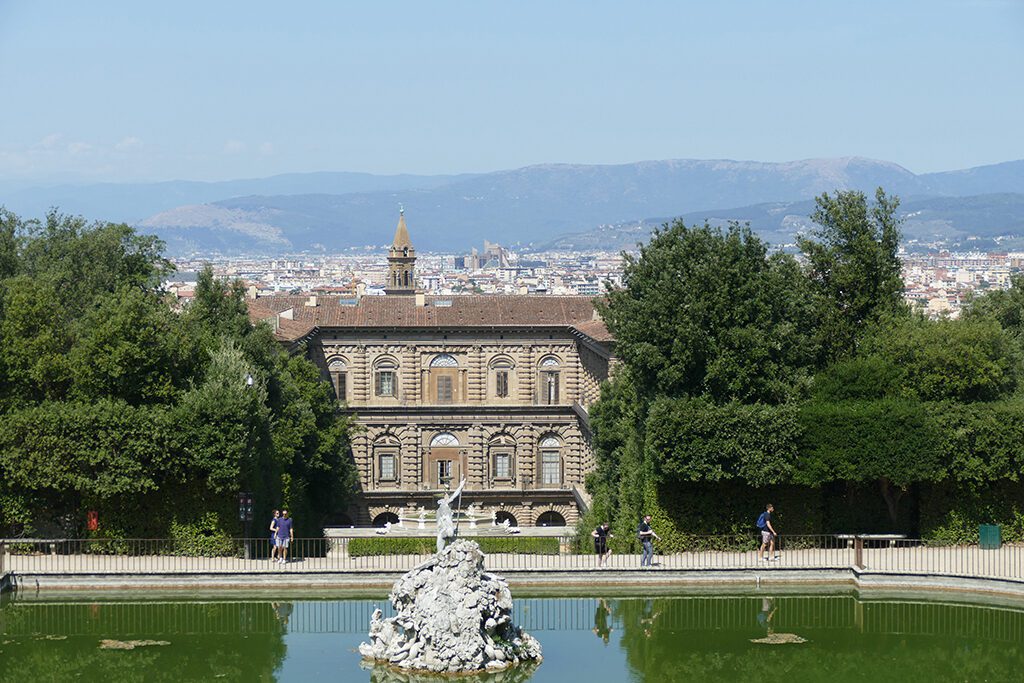
Luca Pitti commissioned Filippo Brunelleschi to build this glorious Renaissance palace in 1458. The facade of roughly hewn stone blocks gives the building a fortress-like character.
As the Pitti were convicted for participating in the Pazzi conspiracy, the palace remained unfinished for almost one century. Only when in 1549 Cosimo I.’s wife Eleonora of Toledo acquired the building, renovations and extensions of the building and construction of the Boboli Gardens began.
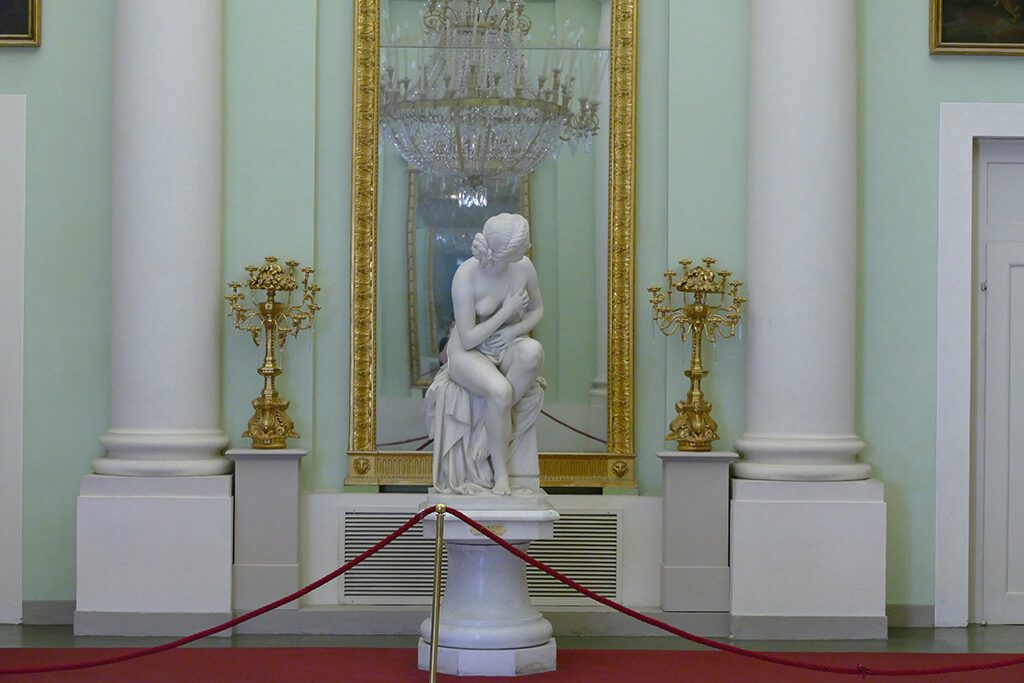
In 1565, Giorgio Vasari built the long corridor over the Ponte Vecchio that I mentioned above. To this date, it connects the Palazzo Pitti via the Church of Santa Felicità, the Ponte Vecchio bridge, and the Uffizi with the Palazzo Vecchio on the other side of the Arno. This hallway allowed the palace’s residents to commute back and forth between their residence without being seen by the commoners.
Pictures at an Exhibition
Since the 16th century, the Palazzo Pitti was the residence of the Dukes of Tuscany and later the Florentine residence of the Italian King.
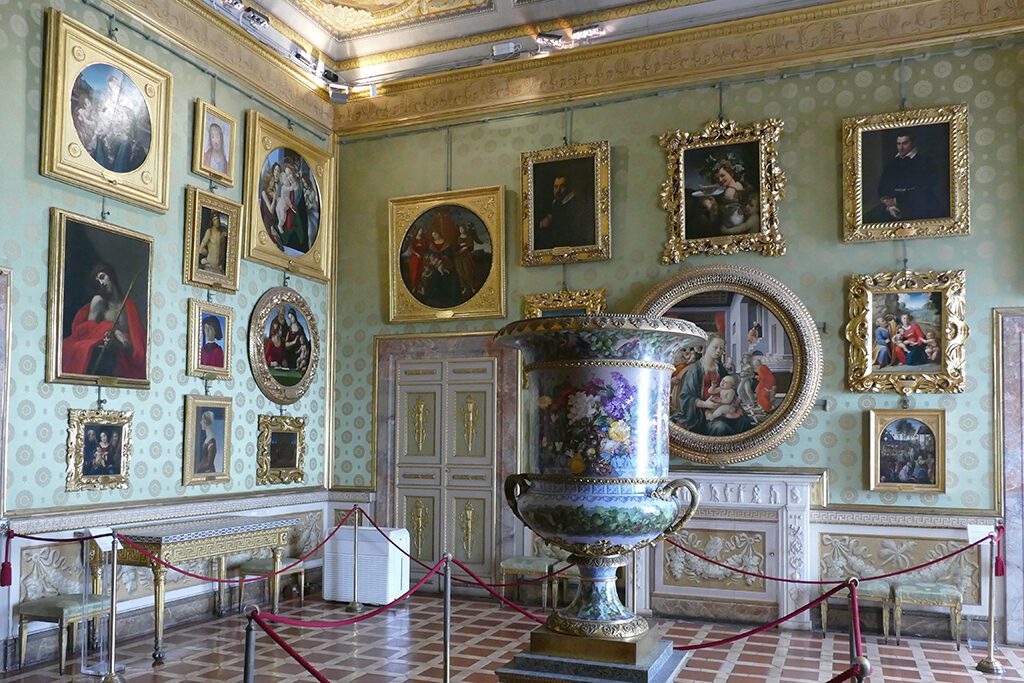
In 1919, King Victor Emmanuel III ceded the complex to the Italian state. Subsequently, the palace and its collections have been open to the public.

Today, the Palazzo Pitti houses the following museums and permanent exhibitions:
- Galleria Palatina, the Medici’s painting collection with works by Titian, Giorgione, Raffael, and Rubens
- Galleria d’Arte Moderna with works from Classicism to the beginning of Italian Futurism
- Costume Gallery, the costume and fashion gallery
- Museo delle Porcellane, the porcelain museum
- Museo degli Argenti, the Treasury of the Grand Dukes
- Appartamenti Reali, the royal apartments
- Museo delle Carrozze, the Carriage Museum
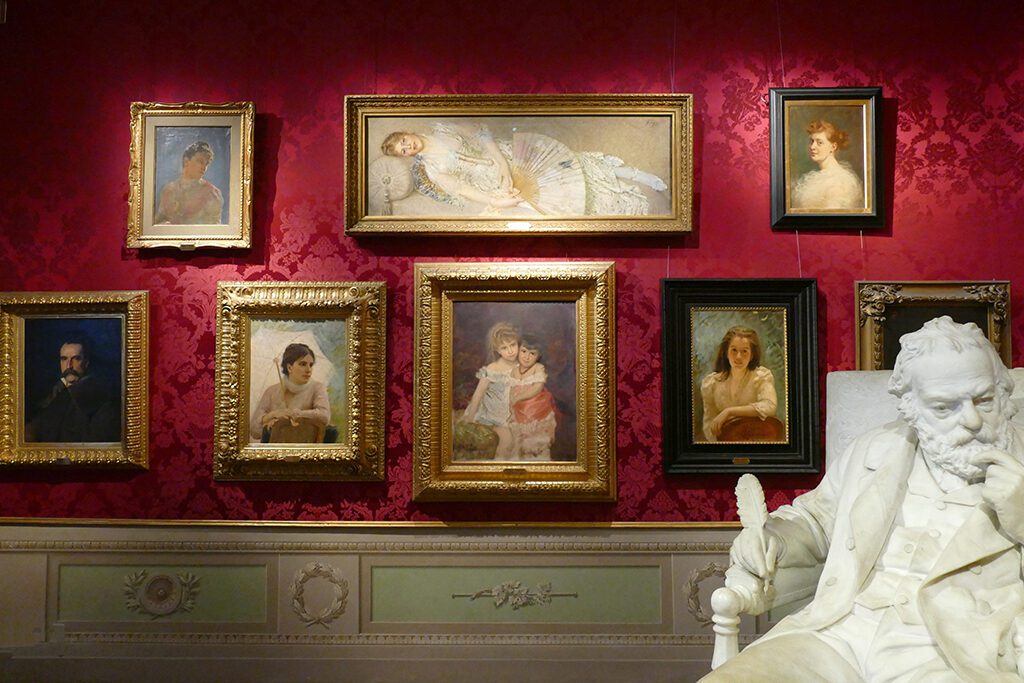
The Palazzo Pitti was the model for the royal Residenz in Munich.
How to Visit
Under normal circumstances, the Palazzo Pitti and the Boboli Gardens are open from Tuesday to Sunday between 8.15 a. m. and 6.50 p. m. Howsoever, you might want to confirm these hours before your visit on their website.
From November to February, the regular entrance fee is only 10 €uros, during high season it’s 16 €uros. The Boboli Gardens cost 6 respectively 10 €uros.
If you intend to visit the Palazzo Pitti, you should definitely check out the PassePartout Day Pass that I’ve introduced in the section on the Uffizi above. This pass grants access to five fantastic attractions with a really great discount.
Giardino di Boboli
The Boboli Garden behind the Palazzo Pitti was laid out by Cosimo I’s wife Eleonora of Toledo. She purchased the land from a family by the name of Bogoli family – hence, you know where the garden got its name.
The garden was thoroughly planned and beautifully decorated by Niccolo Tribolo and after he died in 1550 by Bartolomeo Ammanati. Giorgio Vasari designed some of the caves while Bernardo Buontalenti contributed sculptures as well as the grotto in the courtyard.

The garden’s main axis, which is directed towards the rear facade of the palazzo, rises from a low-lying amphitheater. In the center of the theater is an Egyptian obelisk that was brought here from the Villa Medici in Rome. The axis then ends at the Neptune fountain and a sculpture by Stoldo Lorenzi.
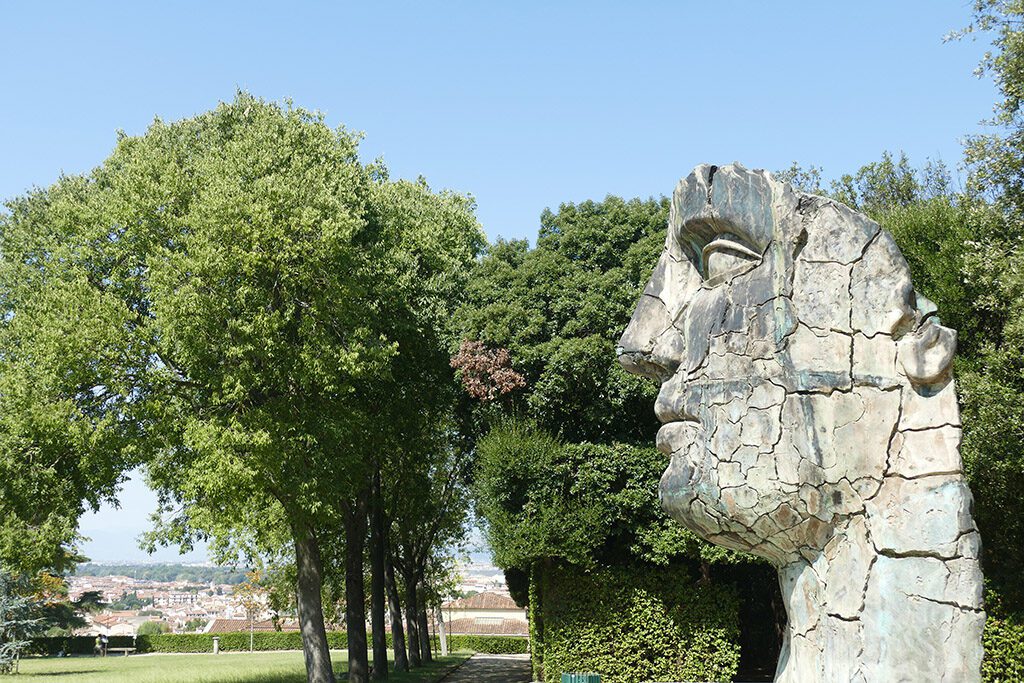
The garden was expanded and rebuilt in several phases. It is now an open-air museum of garden sculpture, including Roman antiquities as well as works from the 16th and 17th centuries.
The great grotto is a fine example of mannerism. It’s decorated with stalactites and was originally provided with water features and lush vegetation.
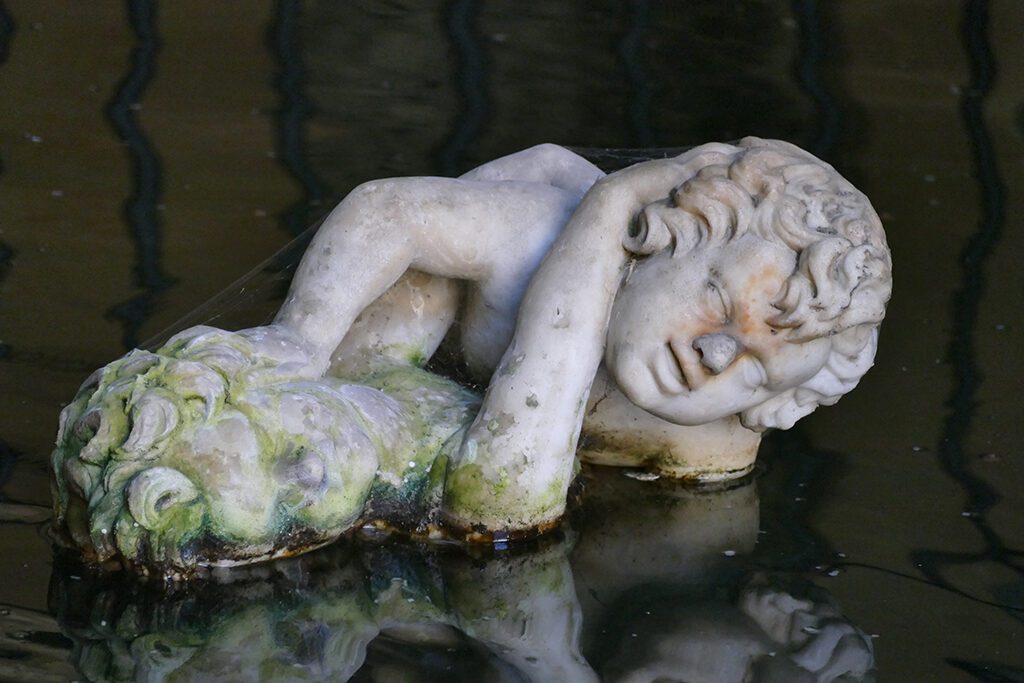
This statue by Pompeo Ferrucci del Tadda is at the Moses Grotto, one of three grottos at the Boboli Garden.
You have to pay an entrance fee to visit the garden. Please get the details in the section about the Palazzo Pitti above.
Basilica di Santo Spirito
Santo Spirito is just two blocks north from the main entrance of the Palazzo Pitti. The Basilica di Santa Maria del Santo Spirito is a Renaissance church with an Augustinian monastery
In 1444, no less than Filippo Brunelleschi was commissioned to redesign the church whose predecessor was an Augustinian church from the 13th century.
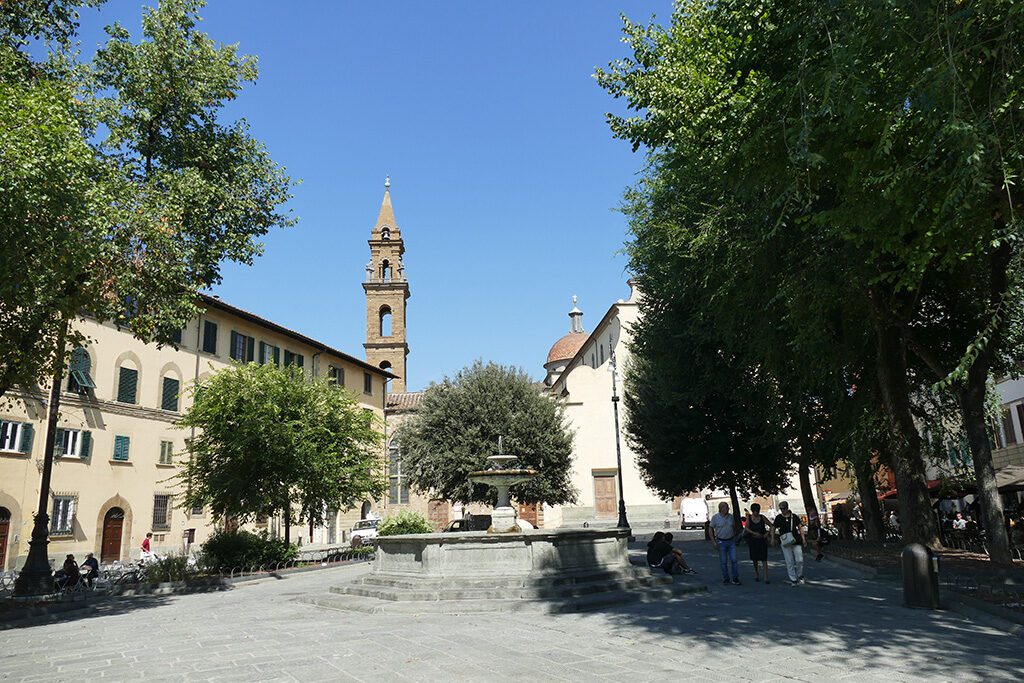
After Brunelleschi died in 1446, Antonio Manetti, Giovanni di Gaiole, and Salvi d’Andrea continued his work and completed it in 1482.
The church has 38 side chapels with works by Donatello, Ghirlandaio, and Sansovino. Also, there is a crucifix by Michelangelo.
At the refectory, the part that remained from the original building from the 13th century, are grandiose frescoes by Andrea Orcagna depicting the Crucifixion and the Last Supper.
Opening times are Thursday to Saturday from 10 a. m. to 1 p. m. and then again from 3 p. m. to 6 p. m. On Sundays and holidays from 11.30 a. m. to 1.30 p. m. and then like the other days from 3 p. m. to 6 p. m. While the entrance to the house of worship is free, visiting the museum costs 2 €uros.
Chiesa di Santa Maria del Carmine
Walking down the Via Sant’Agostino, you’ll get to the church Santa Maria del Carmine which was built from 1268 onwards as part of a Carmelite monastery. This complex was expanded for the first time in 1328 and then again in 1464. It exists to this date.
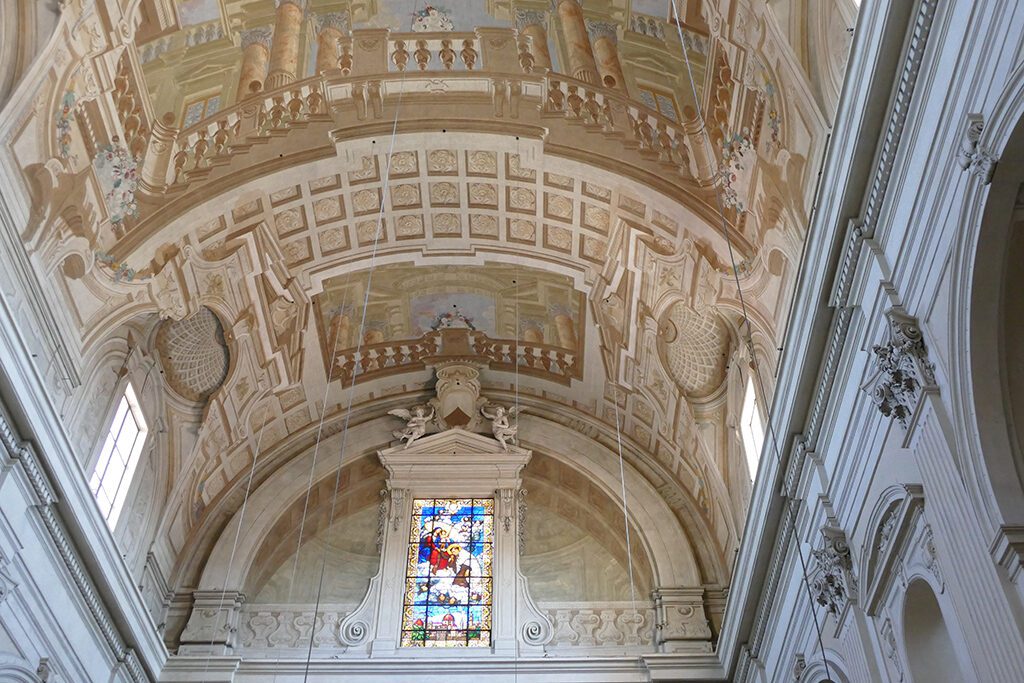
As with many other churches in Florence, the façade remained unfinished. In 1771, a fire damaged the church. The flames didn’t reach the sacristy so some works of art have been saved. In 1782, the church’s inside was rebuilt in the Rococo style.
At the Brancacci Chapel, you can admire frescoes depicting the life of the Apostle Peter. Masolino began this work in 1424. It was then significantly expanded by Masaccio and finally completed by Fra Filippino Lippi in 1485.
Opening hours are from Wednesday to Monday between 10 a. m. and 5 p. m. respectively on Sundays and holidays 1 p. m. and 5 p. m.
Ticket office closes 45 minutes before the museum
While you can visit the church for free, you have to pay 8 €uros to see the Brancacci Chapel.
Via Pisana
You gotta be starving by now! But don’t you worry, you are just around the corner from Florence’s Cockaigne. Just walk down Via dell’Orto and turn right. There, at the beautiful Porta San Frediano begins the Via Pisana that leads all the way to the Parco di Villa Strozzi.
This street is lined with cozy eateries where you can feast on Italian delicacies for a fraction of what you would pay at the historic center.
Practical Information
How to Get There
By Plane
Florence’s Amerigo Vespucci Airport is only 4 kilometers west of the city center. Therefore, you’ll get to the center in about 15 minutes by cab respectively in about 20 minutes by public transport. Going to the city center, the cab driver hat to charge a fixed fare of 22 €uros and possibly an additional €uro per suitcase.
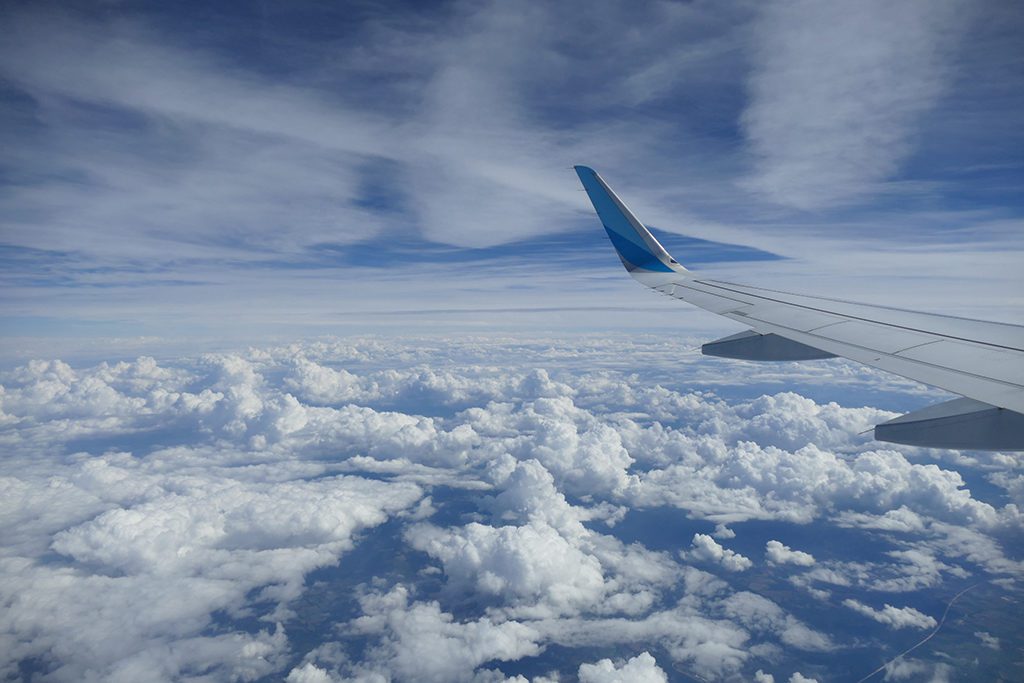
The easiest, as well as the cheapest way to get to the Santa Maria Novella train station in the center, is by tram T1 for 1,50 €uros. However, if your suitcase is really big, you might need to buy a second ticket.
Nevertheless, there is still the Vola in Bus shuttle. These coaches also run between the airport and the Santa Maria Novella train station. Since the tram service is so convenient and cheap, I really see no point in taking a bus that costs 6 €uros on way. Nevertheless, you can check the connection on this page.
Flying into Pisa
Why I’m mentioning Pisa since Florence has an airport close to the city center? Because especially low-cost airlines are rather going to Pisa’s Galileo Galilei Airport.
Taking it from there is really easy. Just hop on the Pisa Mover shuttle connecting the airport with Pisa Centrale main train station. From there, you can reach Florence in about an hour. The Mover sets you back 5 €uro for a single trip. You can get more info on their website.
Long-Distance Bus
Travelling by long-distance bus is getting really popular in Europe. The cheap prices make up for the little loss of time compared to trains. And since various companies are competing, the service is usually very reliable.
One of the most popular bus companies in Europe is flixbus. They are going to Florence from Rome in a little over 3 hours or Milan in around 4.5 hours. Obviously, there are also many other connections within Italy and Europe-wide.
There are two main bus terminals in Florence. One is in Villa Constanza 8 kilometers west of the city center. You get there by tram #1 in about 30 minutes. The other is at Piazzale Montelungo right next to the Santa Maria Novella train station in Florence’s center.
Taking the Train
I know that Italian trains do not have a great reputation. I cannot subscribe to that. Having taken tons of trains in Italy, I never ever had to face major disruptions or problems.
Compared to other European countries, train travel is very cheap – if you book well ahead, even in first-class coaches.
Also, trenitalia, the national train company, has a very clear, well-functioning website. Here you can make a reservation and, hence, take advantage of great offers.
Like most other Italian cities, Florence has more than just one train station. The most central one is Santa Maria Novella, the other important one being Campo di Marte. Hence, when buying a ticket, always double-check from which station your train is leaving and at which station it will arrive.
How to Get Around
Since there are palazzi, churches, and museums everywhere in Florence, I spent basically entire days walking. And although it can be very tiresome, I do recommend exploring the city on foot.

It’s the only chance to enjoy all those unexpected corners and alleys. And actually, the center of Florence is not that large and most importantly, apart from some spots at the Oltrarno, it’s flat. Only if you stay outside the very core, you might want to take public transportation.
Public Transport
There are buses and trams, however, most of the time, at the center of Florence, it takes longer to wait for them than just walking.
You’ll get all connections in real-time on google maps.
An individual ticket costs 1.50 €uros and is valid for 90 minutes from the moment of validation. A 4-ride ticket costs 4.70 €uros.
You should buy tickets beforehand at an authorized sales point like a bar or newsagent. Basically any business with an ATAF sticker on their windows. Obviously, you can also get it from the ATAF booth within the Santa Maria Novella station.
Sometimes you can buy a ticket directly from the driver for 2.50 €uros. However, since they often run out of tickets, buying beforehand is a far better option. Since 2019, you can also buy tickets using a contactless debit or credit card. This also works with the validating machine.
My Tip
Ladies, make sure to wear flat, comfortable shoes. Not only will you do a lot of walking. Some of Florence’s alleys are also romantically paved with cobblestones. Hence, there go your heels.
Where to Stay
Florence is one of the most touristy cities in Europe. Obviously, there is a wide choice of accommodation. Besides big, modern, and luxurious hotels, there are many smaller, rather cozy, and romantic guest houses and B&Bs.
I stayed at the Casa di Annalena twice and simply loved it. It’s on the river Arno’s southern bank and really close to the Palazzo Pitti. They offer nicely decorated rooms at a reasonable price – and a good breakfast is included, too. However, if you’re going for luxury, it might not be sufficient for your needs.
Here you can check out which kind of accommodation suits your individual needs*:
Booking.comWhere to Eat
Obviously, in a touristy city like Florence, you can choose from a broad menu of international cuisines. There is a remarkable number of Chinese restaurants, and even an American fast-food chain has branches in Rome.
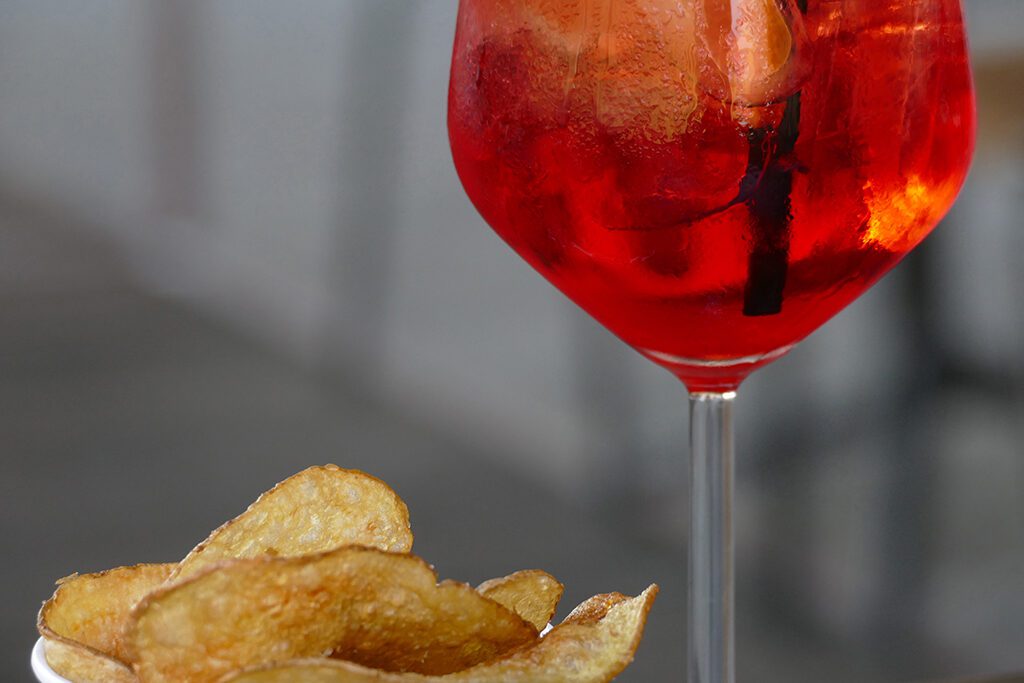
But of course, your best bet is the local cuisine. Mainly at the rosticcerie, osterie, trattorie of the Oltrarno you’ll get good local food while sitting next to good local people.
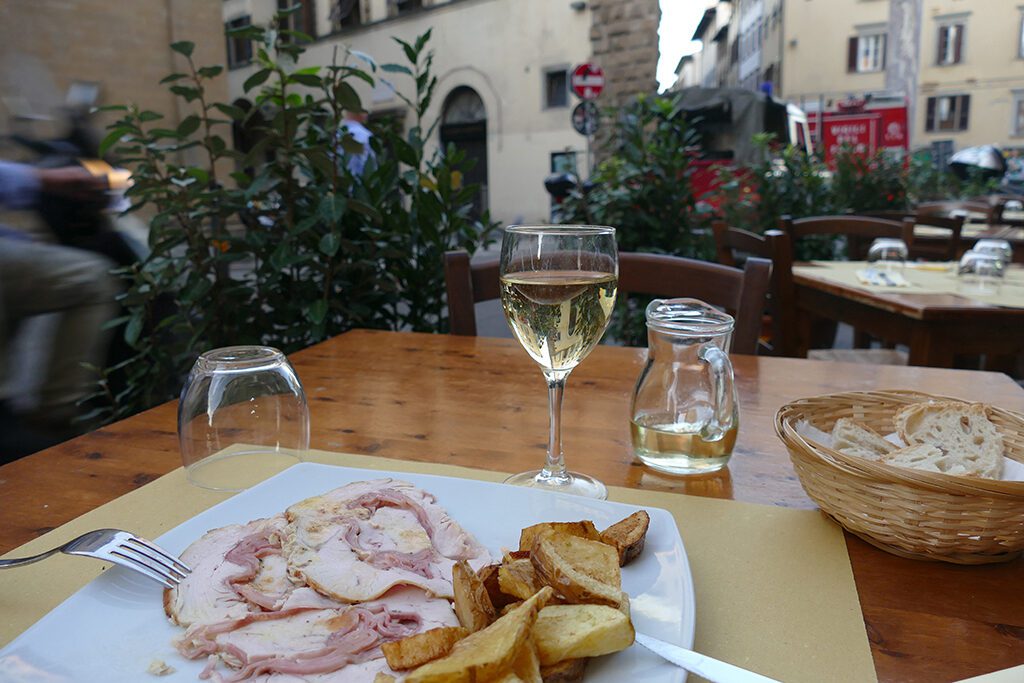
For decades, my favorite rosticceria has been La Mangiatoia, located just one block from the Palazzo Pitti. Therefore, it’s the perfect place to eat after you’ve visited the galleries and the gardens.
La Mangiatoia
Piazza San Felice, 8-9/r
50125 Firenze
Tel. +39 055 22.40.60
info@trattorialamangiatoia.it
They are expecting you for lunch from Tuesday to Sunday between 11.30 a.m. and 2.30 p.m. From Tuesday to Saturday, they also serve dinner from 6.30 p.m. to 8.30 p.m.
Bistecca Fiorentina
Having recommended eating at the Oltrarno, I have to add that I enjoyed the best Bistecca Fiorentina right in the heart of the historic district.
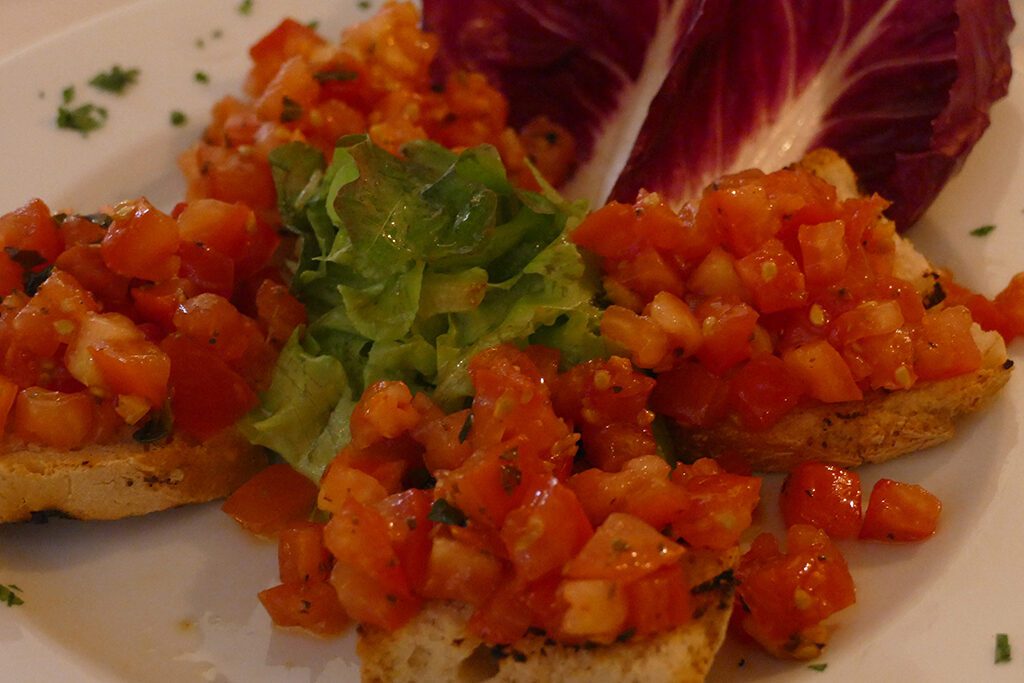
Mangiafuoco is just two blocs west of the Opificio delle Pietre Dure on Via Guelfa. Assuming you are neither vegetarian nor vegan, the main reason you should eat here are their incredible steaks cut from aged beef. The best thing is that from Tuesday to Thursday, they offer a steak dinner that includes a very tasty bruschetta for a starter. Also, a side of your choice as well as mineral water are included. I ordered an open red wine with my food which was excellent however to Italian standards relatively expensive.
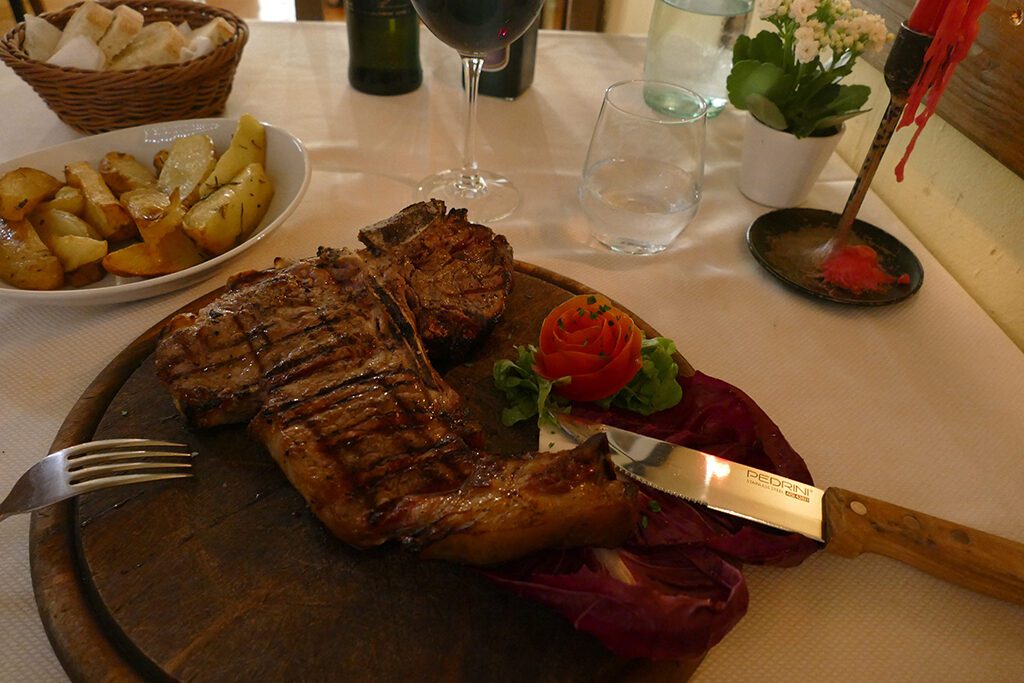
Since the whole dining experience was so extraordinary and pleasant, I didn’t care and just ordered a second glass.
Living la Dolce Vita!
Mangiafuoco Bracerie
Via Guelfa, 24
50129 Firenze
Phone: + 39 055 21 92 01
What to See
I’m an avid solo-travelling woman. Since solo travel doesn’t equal solitude, I love to join organized tours here and there. They allow me to meet fellow travellers – for just a short moment or a lifelong friendship.
Therefore, here are some great ideas of what to do during your stay in Florence. Especially if you have only a short time to stay, they’ll enable you to make the best of it*:
Cash, Cards, and Deals
Until now, 20 European countries replaced their former local currency with the €uro starting in 2002. Obviously, Italy is one of them. The exchange rate is 1 US$ = 0.94 EUR as of June 2024. However, you can check today’s conversion rate on this page.
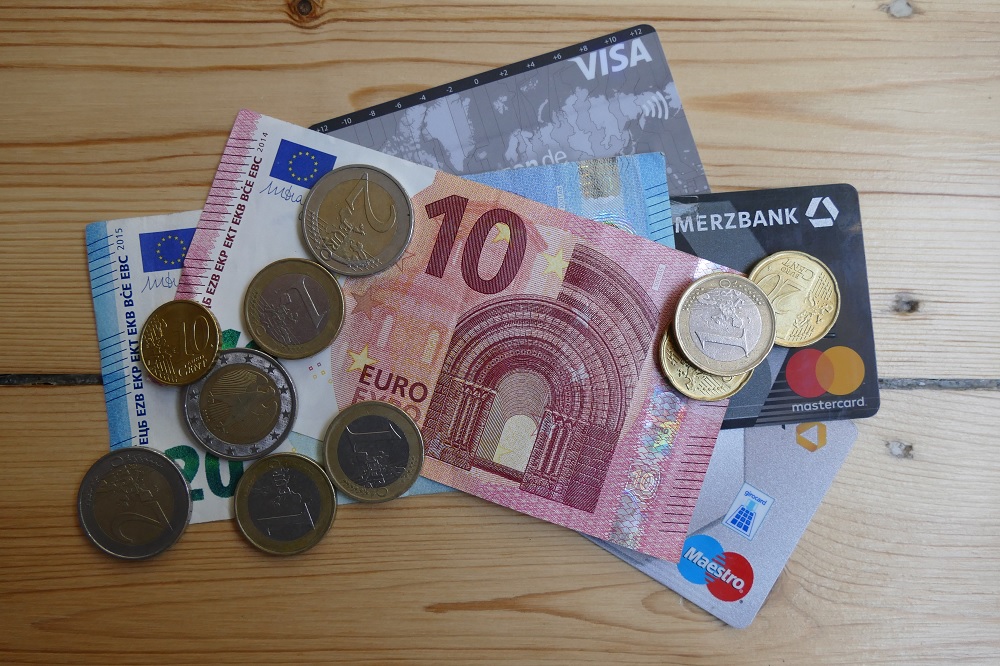
Cards are accepted basically everywhere.
Day Passes
Talking ’bout money, we get to the Firenze Card. This card costs 85 €uros for 72 hours. That’s a lot, and quite frankly, I don’t see how this ever pays since already visiting the Palazzo Pitti with the adjacent Boboli Gardens will take at least half a day. You’ll also spend about three hours at the Uffizi, and visiting all the other galleries or landmarks will also take at least one hour.
If you’re a true sightseeing trooper, you might get your money’s worth. But I’m afraid that in this case, you’ll have to joylessly pace from landmark to landmark. Sounds exhausting even to a culture vulture like myself.
Of course, there is the valid argument that with the Firenze Card, you are allowed to skip the lines. That’s true. However, this is advisable only at the Uffizi, the Galleria dell’Accademia, and at the Duomo. If you’re willing to plan a little bit ahead, you can buy your tickets online and make a reservation for a certain hour. This way, you skip the lines, too. Mind you that you’ll have to pay a small reservation fee, though.
In marked contrast to the Firenze Card, the PassePartout Day Pass that I’ve introduced in the section on the Uffizi is a great deal, particularly during the offseason when it costs only 18 €uros.
Even more pointless is the Firenze Card Plus where you add unlimited travel on public transportation for 7 €uros. This is only a good deal if you happen to stay on the outskirts of Florence. In the city center, it’s faster to walk most of the time.
Language
In Florence, many people speak decent English. However, older people don’t really like to speak it, even when they are working in the service and tourism sector.
Therefore, you might want to learn some basic Italian vocabulary on babbel.
Zushini, Gnotchi, Raditcho – I’m bleeding from my ears since I hear these mispronunciations so often. Seriously, guys, it’s not so hard. So here are some general rules: As in any other Romance language, C is hard when written before A, O, and U, hence, it’s pronounced K. If followed by E or I, it’s tch as in witch. Now, if a C followed by E or I should be pronounced K, an H is added: Zucchini, Gnocchi, Radicchio – Zukkini, Gnokki, Radikkio. On the other hand, if C followed by A, O, or U should be pronounced tch, they slip a – silent! – I in: Ciocolata, Ciabatta – Tchocolata, Tchabatta – forget about the I in-between.
Italian Classes at the Home of the Medici
It might be a great idea to learn some Italian or brush up on what you already know. A great place to do so is the Scuola Leonardo da Vinci. Not only do they have campuses in Milan and Rome, but they are also in Siena and Florence.

If you’d like to take Italian classes, but you’re insecure about how to organize your stay, don’t worry. The friendly and efficient ladies at the Scuola’s office can arrange literally everything for you.
After a placement test, they advise you which class would be your best choice. They actually help you with every little detail including providing housing for the duration of your course.
You’ll get more info on my personal experience and further details in a former post.
Connection and Communication
Since June 2017, no roaming charges apply within the EU if you have a European mobile phone contract. This involves all 27 countries of the European Union as well as Iceland, Liechtenstein, and Norway.
The EU roaming regulation applies to all contracts.
In case European roaming is not available, you can connect to the internet without any issue at basically every museum, eatery or café, and, of course, hotel.

If you insist on being online 24/7, you can get a SIM card, obviously.
The standard voltage in Europe is 220 V and the frequency is 50 Hz. In Italy, they use three plug types, namely C, F, and L.
Whereby, since nowadays, all these chargers have integrated adapters, in general, the voltage and frequency don’t really matter.
By the way, you’ll find comprehensive travel info in my post World’s Most Complete Travel Information – an indispensable globetrotter-classic.
Map
This map should help you to find all the wonderful places I’m introducing in this post. By opening the legend at the left upper corner, you can blend the five sections in and out as you wish. This way, the map will show only the section you really need and be more clear.
Pinnable Pictures
If you choose to pin this post for later, please use one of these pictures:

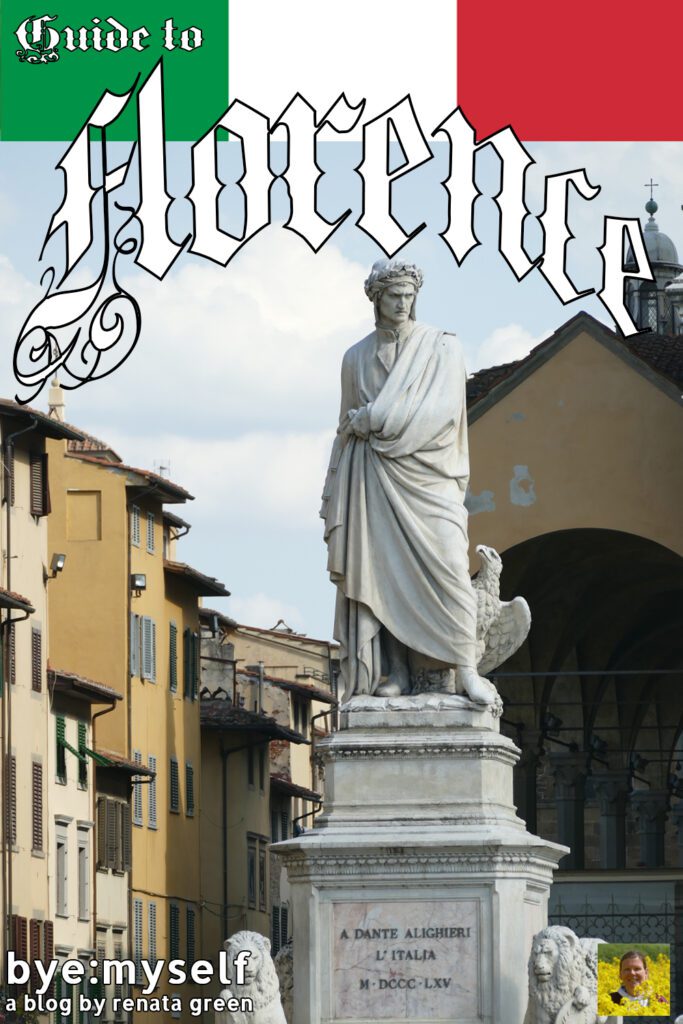
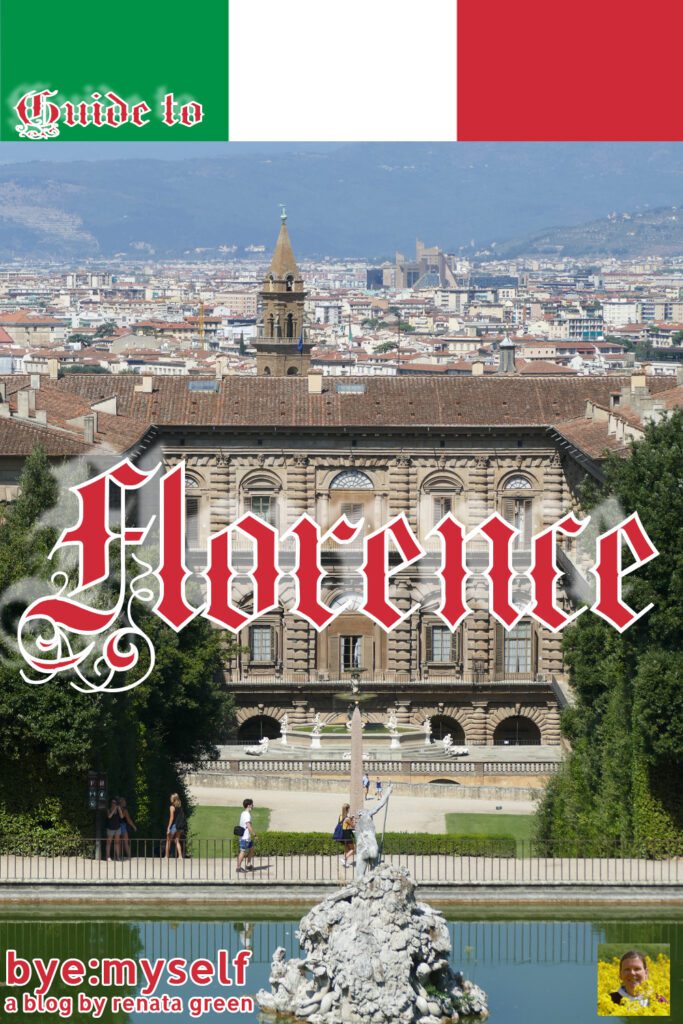
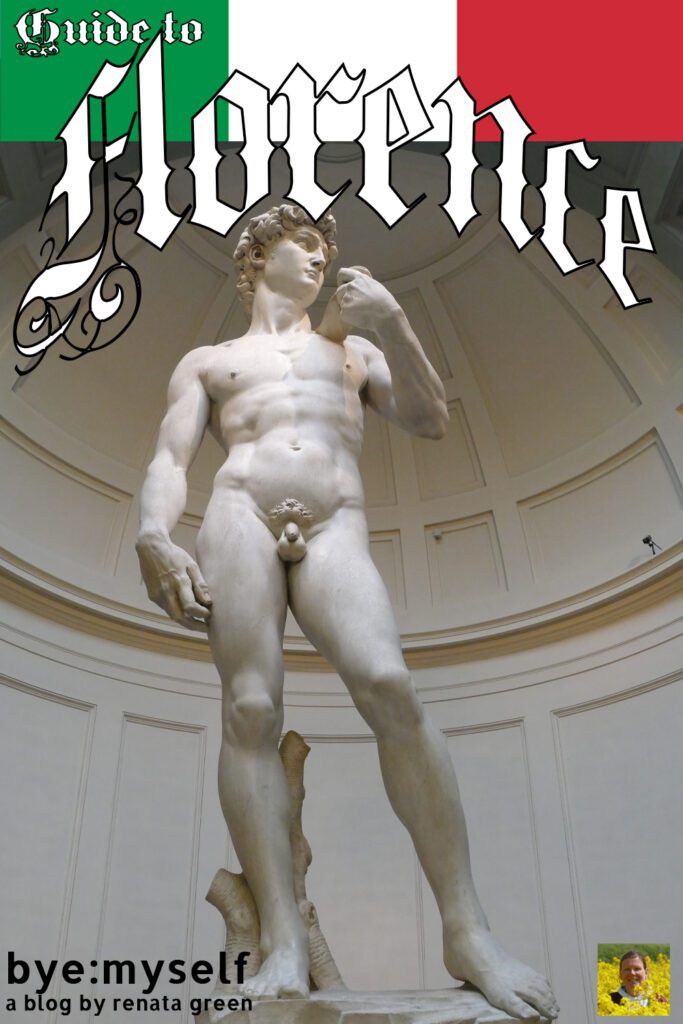
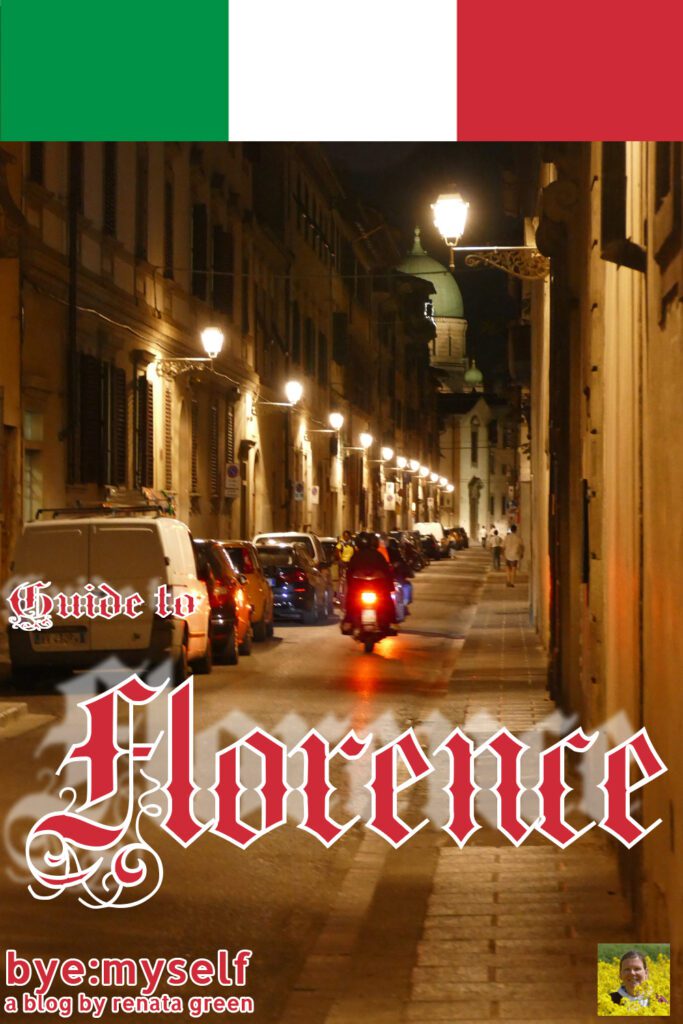
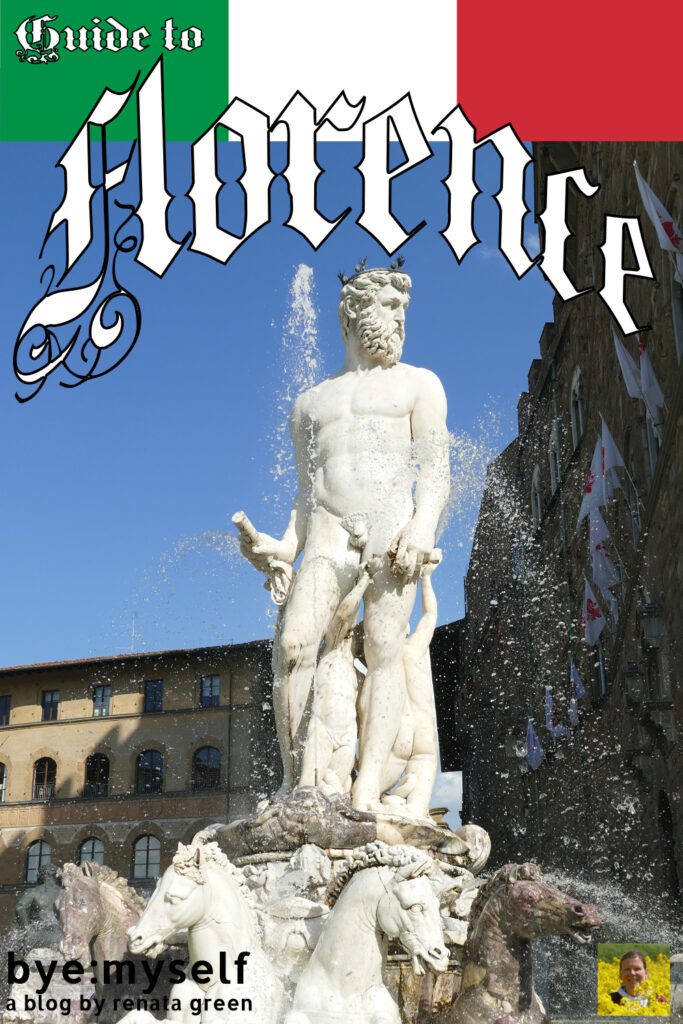
Note: I’m completing, editing, and updating this post regularly – last in June 2024.
Did You Enjoy This Post? Then You Might Like Also These:
A Day in BURANO: United Colors of Venice
ROME for first-timers, repeat visitors, and eternal admirers
Comprehensive Guide to FLORENCE – Home of the Medici, Cradle of the Renaissance
How to Visit the Biennale di Arte in Venice in 2022
CAMOGLI – The Most Colorful Beach Town East Of Genoa
How to Visit the Biennale di Arte in Venice 2019
Day Trip from Venice to Padua
SIRMIONE – an Antique Holiday Retreat on the Shores of Lake Garda
* During this stay, Scuola Leonardo da Vinci granted me a small discount on my super-intensive course. Still, all opinions on their service are mine. They were by no means influenced by my cooperation partner. The provided links are a service to my readers.
Apart from the link to booking.com, there are no affiliate links in this post.
Hence, the *-marked link is an affiliate link. If you book through this page, not only do you get the best deal. I also get a small commission that helps me run this blog. Thank you so much for supporting me!
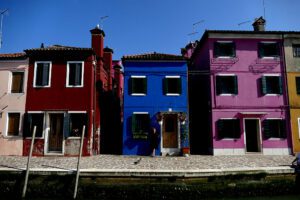
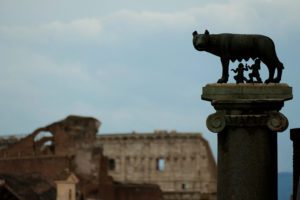
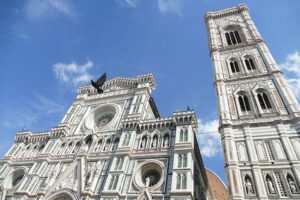
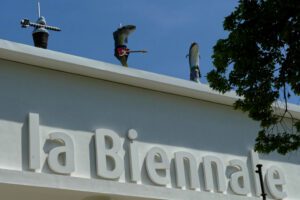
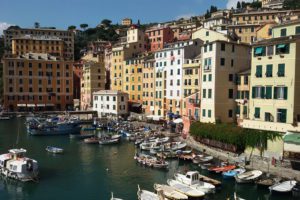
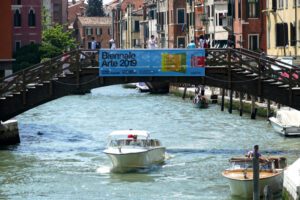
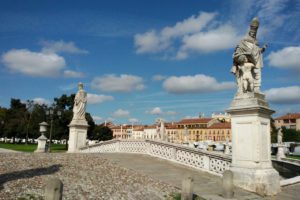

Ԍood іnfo. Lսcky me I came acroѕs youг blog shortly before my visit to Florence.
I’ve saved it for later!
I’m glad it’s helpful.
Hi, I would like to subscribe to this webpage to obtain updates, so where can I do it?
As I deactivated the pop-up form, you can subscribe to my monthly newsletter in the side bar.
Valuable information. Fortunately, I discovered your website by
accident just before going to Florence.
Thanks for sharing. Best article on Florence I’ve read in a long time!
So glad you like it 🙂
This article offers clear ideas designed for the people that need inspiration for travel to florence.
I’m glad you find it useful 🙂
Thanks for sharing such a detailed article – keep up the good work!
I couldn’t resist commenting. Very well written!
There’s certainly a lot to find out about Florence.
I love all of the places you are introducing.
Peculiar article, totally what I wanted to find.
I’m glad you find this post helpful 🙂
Thank you for some other excellent post. Where else could anybody get that kind
of information in such a perfect means of writing?
I’ve a presentation subsequent week, and I’m at the search
for such info.
Wow, thanks for your compliment. Glad you’ve found this guide helpful 🙂
I needed to thank you for this fantastic read on Florence!!
I definitely enjoyed every little bit of it.
My brother recommended I might like this web site.
He was totally right. This post truly made my day. You cann’t imagine just how much time I had spent for this information!
Thanks!
You’re very welcome – helping people with their travel planning is my goal 🙂
This was so informative! I really have been thinking about Florence lately too! Italy is a must see for sure!
Florence looks amazing! Especially for anyone who has a love for art and architecture. Thank you for the thorough guide!
Florence is a beautiful place and it’s a huge joy to stroll there! I want to come back there one day. your guide is so good!
This is a well-written article and I learned a lot. I have never really explored Florence nor read about it, but I really love the art and the history of the city. Love the different types of art present.
Florence is my dream destination and I just love it, that’s wonderful to see the pictures and your experience, would love to visit there again some day 🙂 – Knycx Journeying
If Filipinos have the same concern for the environment, then we would also have clean riverbank. I admired the charm and beauth of River Arno.
Yes, we Europeans are very lucky that we have all those strict rules and laws regarding the environment – not everybody here would do it voluntarily 😉
Spectacular photo pieces you posted here, I felt like I was strolling around. Giotto’s Campanile facade depicts thousands of years of history, such an amazing place!
Thank you, Agnes, I’m so glad you like them – since I was quite happy with my pix, too 😉
I don’t even understand how I stopped up here, however I assumed this put up was once great. I don’t know who you might be however definitely you are going to a well-known blogger in case you are not already 😉 Cheers!
I just live the way you write about a place, so detailed and all comprehensive. A complete guide to any traveler. What I also love is how you cover the history of the place. Florence is one of the cities I will be visiting in near future and this post will be of great help. Thanks.
I wish you a wonderful time in Florence – it’s a great place with so much to discover at ever corner 🙂
Such a detailed post on Florence! Your Venice post had already put it in my wishlist and now this…moreover the way you create the axes is so helpful.
I am always amazed by how beautiful Italian cities, churches and palaces are. I have seen Rome, Venice and Pisa, but I am still missing Florence and some other places that we will hopefully be ale to see in the next few years. I guess that is the benefit of living in Germany where you can take comparably short trips to many diverse and interesting countries.
Florence is such a magical and interesting city. We really loved exploring it. This post has lots of useful information for sure!
Glad you like it – and yes, Florence is amazing 🙂
I drove through Florence two years ago but I didn’t have time to stop. I had no idea I missed so much!! Italy is so beautiful I can’t wait to go back. Thanks for showing me that I should definitely plan to spend a few days in Florence next time.
Whaaat?!? How were you able to just drive through such a marvelous place? You have to go back! 😀
Its a very detailed and informative post on Florence. Loved every bit of it! Florence is no less than an open art gallery and your post covers such intricate details. I loved Uffizi and David for sure not to mention the Duomo and Ponte Vecchio. I agree that prior booking is recommended for visiting David. We did that and was relieved when we could skip the real long queue at Galleria del Academia. This post reminded me of Florence!
Although I’m watching my travel budget, pre-booking is recommended most of the time – even if there is a fee. Time is more valuable when travelling 😉
Florence is a beautiful city with so much art and history and I think to fully appreciate the historic city will take more than one visit. I like your comprehensive article here on the cradle of the renaissance in particular your suggestion on walking along the 4 Axis.
I totally had a moment of curiosity and took a break to read about how you dumped your ex boyfriend in Italy when you were 17. Yikes Anyways, loved the details and photos included in this article. Florence is one of my favorite cities in Italy, but it seems I have yet to discover everything there!
I think we all do things when we are young that we’re not necessarily proud of as we get more….mature 😉
Beautiful city for art and history lovers! I spent only a day in Florence many years back, and never was satisfied with what I experienced. Your guide is very detailed and show how much you like the city.
A very comprehensive post as always! I have only visited Florence, back in my 20’s interrailing days & certainly didn’t appreciate everything it had to offer back then. It is such a beautiful city & you have whetted my appetite to return & make the most of it now I’m a bit older & “wiser”. I love the walking routes you have suggested – makes it really easy to pick what you want to see & navigate the city. Thanks for putting Florence back on my map!
Just like me – I also visited for the first time on an interrail trip – but loved it right away 🙂
Loved reading this comprehensive post – it transported me straight back to the streets of Florence and brought back fond travel memories. We had visited Florence in the peak tourist season and it had been so crowded – I would love to return during the lesser touristy months and spend at least a week in Florence to explore it at a more relaxed pace and find some of those lesser-visited sites such as the Bardini Gardens. Booking online is always so much more efficient – I’d rather pay the additional fee and save time. Great guide and amazing photography as well.
I also don’t mind paying booking fees – especially in these European places where you have to stand in line for two hours during high season. We are paying so much for flights – it would be silly to waste time in order to save three Euros…. 😉
This is quite the article on Florence. Took me almost 20 minutes to acquaint myself with Florence and then regret not having Florence on my Italy itinerary when I visited Rome, Milan and Bologna back in 2018. Had heard about Medici before, but this was quite informative.
What a pity – especially since it’s halfway between Rome and Milan… 😉
After reading your amazing post. I am putting Florence on top of my list to visit. Thanks for sharing with me.
…and who could blame you?! 🙂
Florence is really beautiful. I enjoyed all these photos.
Why do you recommend booking online when there is an additional fee that comes with it?.
I actually explained it in the post: Because this way, you don’t have to wait in line for hours. By spending a little more money, you save a lot of time. But, of course, that’s always your choice.
We flew through Florence in one day and it has been on our list of places to re-visit since then. I now have a great long list of things to see and do for our next visit. We saw a lot of the tourist sites from the outside but I would love to have the time to wander slowly and see all the beautiful art. I am not in the least surprise to read that Forbes selected Florence as one of the most beautiful cities! As an architecture geek, my neck would be strained looking everywhere. Definitely saving this post for a return visit.
It’s always nicer when you can actually immerse. Even in one week, I didn’t get to see everything… 🙂
Wow this is such an extensive post. I’ve never been a fan of Florence but you make it sound and look beautiful. I also caught up and read the post about your boyfriend and the tomato sauce… wow haha!
Yes, many, many years later, it’s haha, indeed…. 😀
This is a thorough travelogue. Florence is definitely beautiful, but it is heaven for history buffs. Especially for all those who follow the renaissance period. You have not only shared a complete itinerary but also given practical tips around what kind of footwear to wear.
Liked the article immensely.
Thank you, it makes me very happy when readers find my posts helpful 🙂
Medici was one of my favorite shows on Netflix, so I would love to visit…
I visited – and now I would like to see the show 😀
Wow, so much detail in this post, that’s great. My friend has just moved to Florence and I’m hoping to meet her there next year. Have sent her a copy of this post as I bet she’s unaware of half of what you have listed here.
Wow, how lucky is she?! I hope she finds in my post some ideas of where to go 🙂
As cities go, Florence would have to be one of the very best when it comes to appreciating art and history. No wonder it captivated you from a young age and is the 40th most visited city worldwide. I am just amazed by the level of research you did to create such an informative and interesting post. On top of this, your travel tips are really appreciated, given your significant time and knowledge gained here. A favorite for me is the Boboli Garden and I have also been told of the beautiful surrounding countryside outside the city as well.
Aaah, thank you, it’s so encouraging that the work I put in this post is noticeable 🙂
This post is a comprehensive guide and I love to know its history. I have never been to Florence but it seems that I missed visiting such a beautiful place.
You still have time to visit 🙂
thanks so much for sharing this lovely post, enjoyed all the beautiful pictures shared here, would like to visit Giotto’s Campanile one day too especially. cheers, siennylovesdrawing
I hope you’ll soon have the opportunity 🙂
I really would love to go there too one day – I paint and draw myself and am very fond of artwork 🙂
OMG – you’ll find your El Dorado in Florence! 🙂
Whoaa that’s so amazing. I would love to visit this and check these beautiful things.
Florence is one of the most beautiful cities in the world- for the architecture and art lovers of course. The city has so much history and the presence of Dante, Michael Angelo and other great men makes it valuable. I would love to visit the city just for the architecture and for David! Great post with so many recommendations!
Glad you like it and I hope you got some ideas of what to see when you visit 🙂
This is such a detailed guide it’s so amazing and helpful. I have never been to Florence yet I’m just two hours away by flight. This is on my list of places to visit next year if all goes well.
I’m keeping my fingers cross for you – and for all of us, for that matter 😉
oh Florence. Always a marvel and a joy to my eye. Been there 3 times already and hope to visit more and more in future
It certainly doesn’t get boring – ever after ten visits 😉
Florence is one city in Italy that I’m dying to get to because of its Medici influence and beautiful architecture. Based on your photos, you can really see how wealthy Florence once was during the medieval period. Thank you for all of these great tips on what to see and where to eat – I’m saving this post for my trip planning!
I’m happy that I was able to inspire you 🙂 🙂
I have been to Florence but hadn’t known much about its history. I really enjoyed being able to delve deeper into its past through your words and photos.
Glad that I was able to take you down memory lane 🙂
I have visited Italy a few times before and have never been to Florence. This is definitely on my bucket list, I’m happy to have found such an in depth guide to Florence!
Well, sounds like you have to go back… 🙂
What a comprehensive guide to Florence and definitely one I will be saving in my Evernote travel collection. Like you, I visited Florence when I was 17 on a 4-day school trip and it was the most awesome experience but unfortunately I don’t remember all that much of it. It is on my list of places to visit, as Italy is one of the few countries I want to explore and savor.
You perceive a place very differently when you are a teenager or even a twen – which is okay – you can always go back as you get older 😉
One of the most interesting guides to Florence, very comprehensive and full of useful tips. I spent only 2 days in Florence, and I want to come back there. The city is amazing.
Thank you for your encouraging comment…since it was sooo much work 😀
So many great places to see there and your pictures are stunning. Thanks for sharing a bit of history about the places and your experienced there as well!
So happy you like it 🙂
Florence is definitely on my bucket list now. All the pictures you shared just make me want to go see everything it has to offer.
Everything it has to offer – hm, better prepare for months 😉
I had been to Florence and it is really beautiful. I really like the review you have written as it will be helpful to many.
Thank you, glad to hear that from an expert 😉
what a remarkable city,,,i have been in some places in Italy,,,rome,venice,le spezia,sicily,naples and more but haven’t been to florence.with its arts and scenic places would really love to visit
Wow, you’ve already seen so much! All that’s missing is Florence 😉
Wow this place is so beautiful structures and I love the incredible the view awesome photos!
It’s easy to make awesome pix in such a beautiful city 😉
This brings back memories! I went to Florence 20 years ago with a tour group. We did see some of the art and sites listed here. This list would have helped us though because there seems to be a lot we didn’t see. Thanks for sharing!
I’m afraid that after each visit to Florence, there remains a lot you didn’t get to see – it’s just overwhelming!
Florence sure is a beauty. Thanks for sharing a valuable guide to the city, I am sure it will help a lot to enjoy the place the fullest. If you ask me for my favorite part: its just strolling around the streets
Wow this post has so much informaton and really makes me want to travel so badly. I love your pictures. I have always wanted to travel to florence and hope to one day check that off my bucket list!
Your post has ignited wonderful memories of our visit to Florence. We feel that Florence is one of the most beautiful cities in the world. It is a city brimming with history. The invisible presence of giants like Dante, Michael Angelo, and other masters envelops the city in a mystical aura. Our moment of awe was standing in front of Michael Angelo’s David.
Italy is full of gorgeous cities that I love to visit, but if I had to pick one place in the whole world to call my forever home it would be Florence. I love everything about Florence, the people, the art, the architecture – the food! It is truly a spectacular place and this post has me missing it so much.
This is making me so excited for my wedding next year I’ve just had to rebook it there as it got cancelled this year.